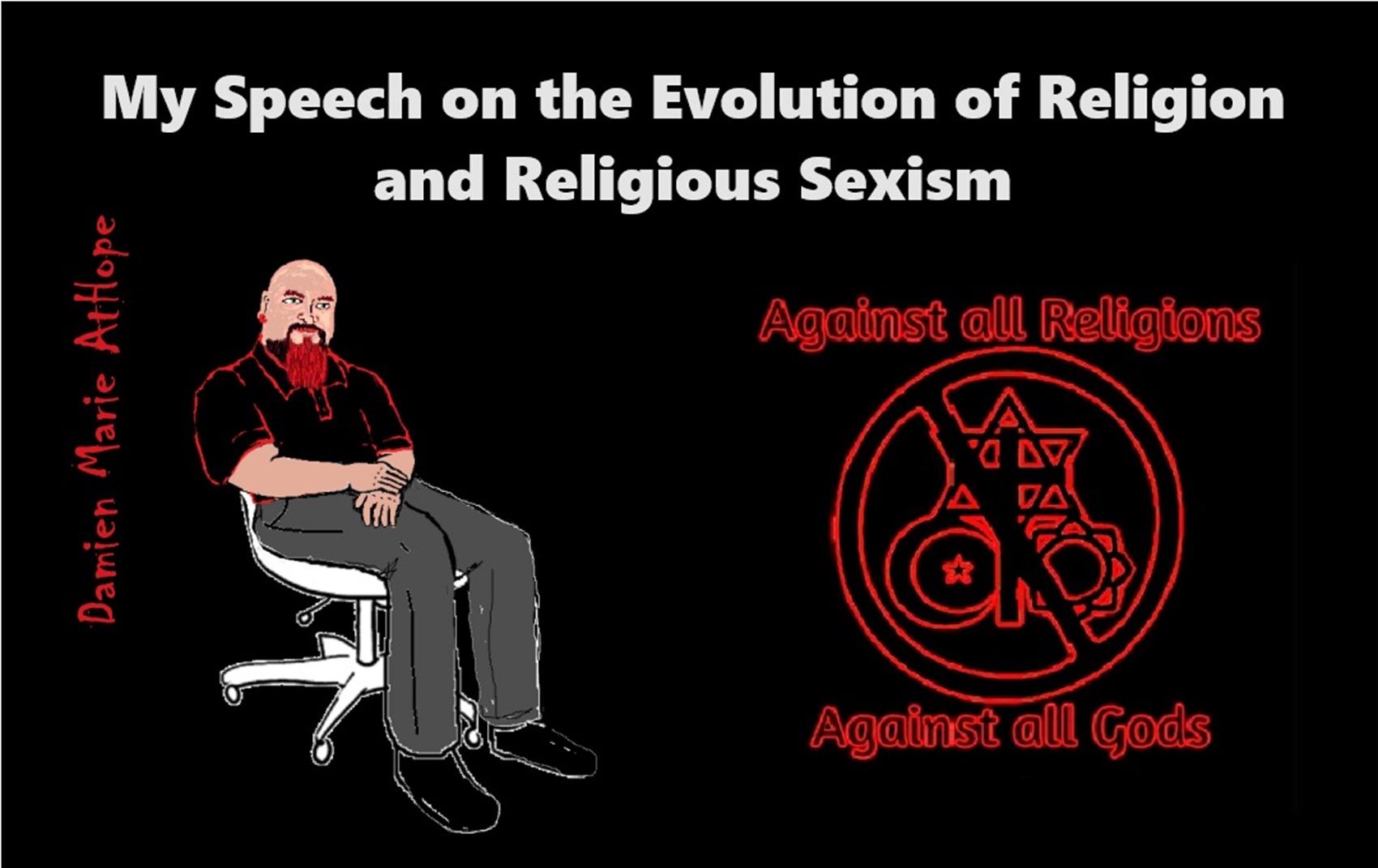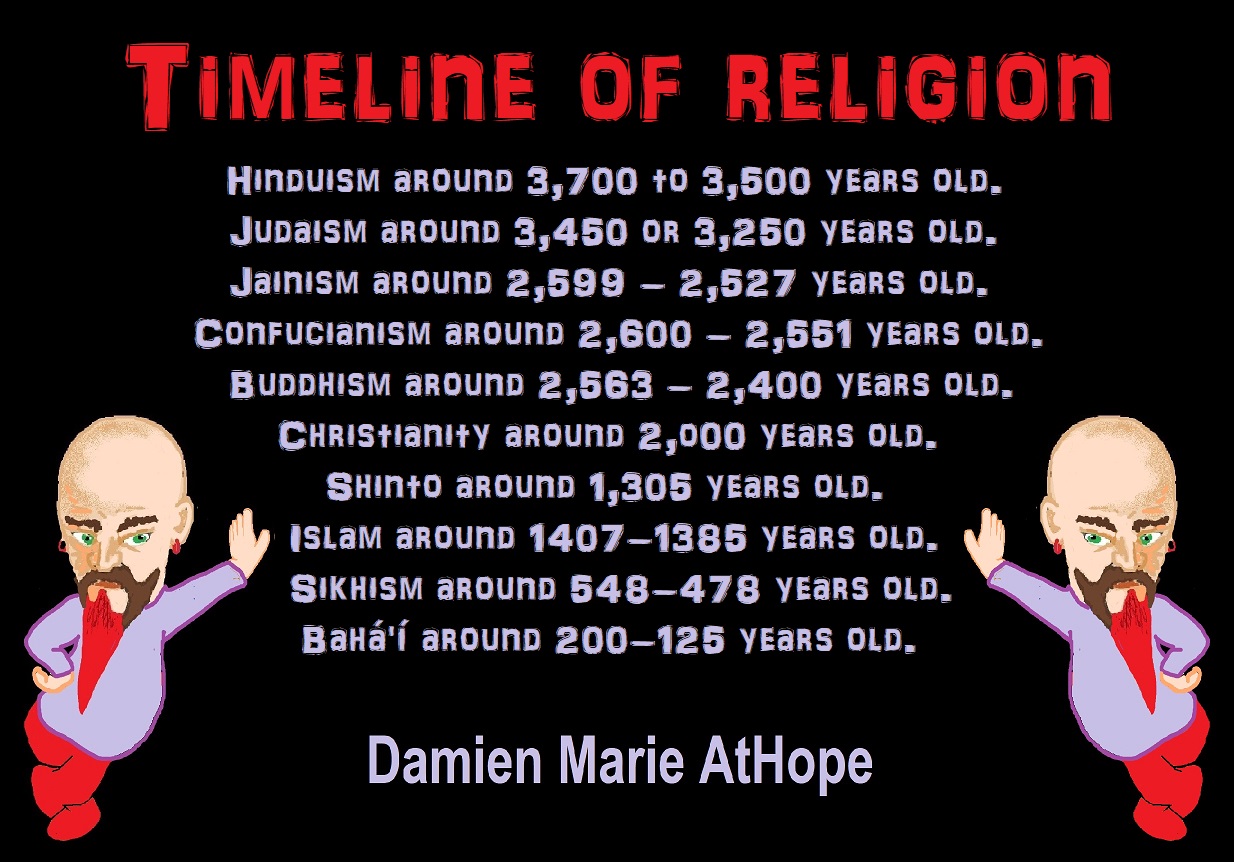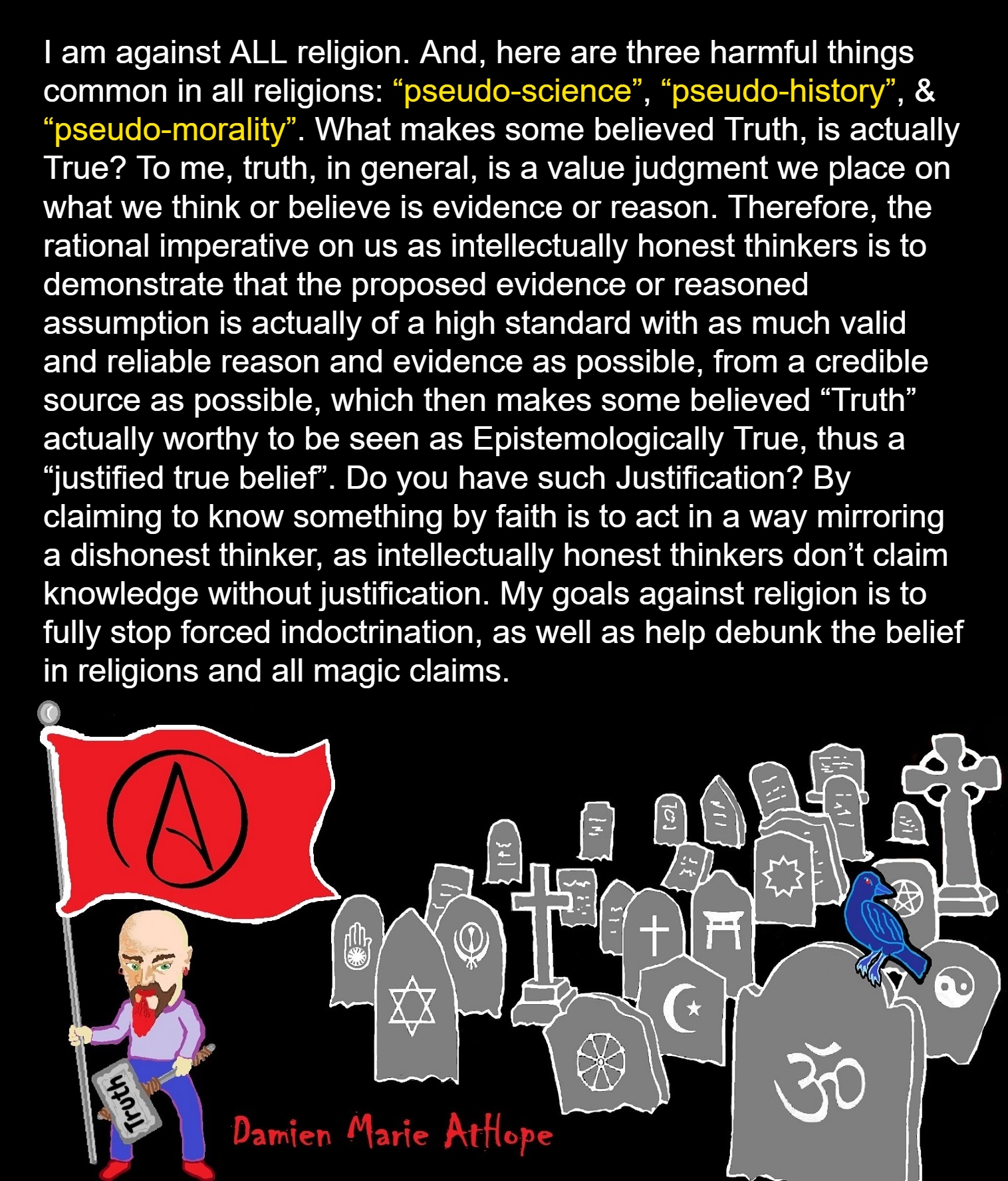Sexism is likely under 7,000 years ago as male clans took over from 7,000 to 5,000 years ago.
Then around 5,000 years ago the state was born and religion gets a military.
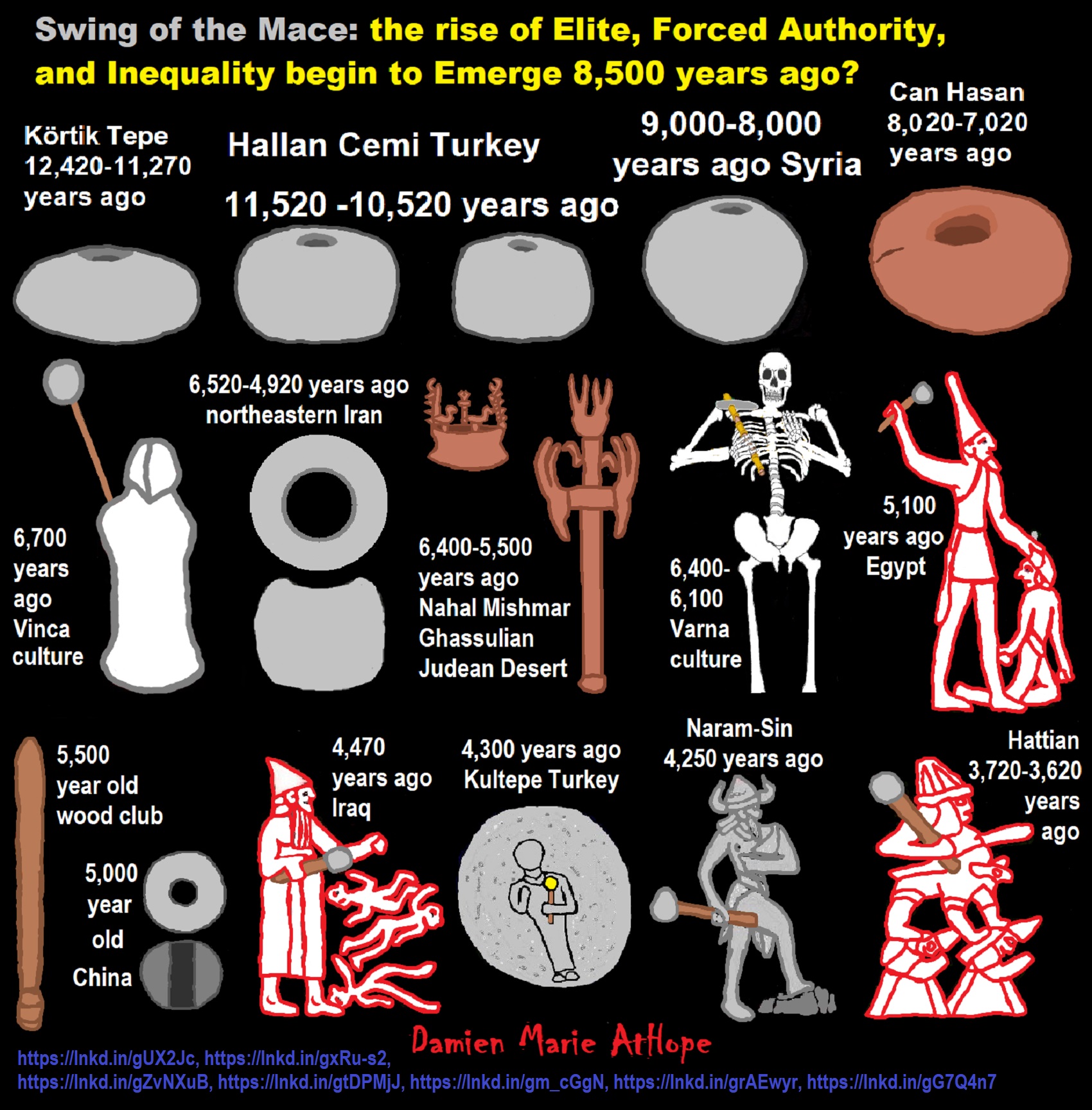
“Israeli Archaeologists Find Earliest Evidence of War in Southern Levant. Industrial production of aerodynamically efficient slingstones almost 8,000 years ago in what is today’s Israel wasn’t done to hunt animals. Almost 8,000 years ago, people in the Galilee and Sharon plain were preparing for war. This postulation is based on the mass production of shaped slingstones at four sites in Israel, starting in the Late Pottery Neolithic – though who they were attacking, or defending against, and why the production of these stone bullets ceased after about a thousand years is anybody’s guess. The current thinking is they were fighting against other local peoples, not invading hordes. That would come later.” ref
“The collections, most recently found at ‘En Esur and ‘En Tzippori but also at two other sites, are the earliest evidence of “formal” slingstones in the southern Levant, say Gil Haklay, Enno Bron, Dr. Dina Shalem, Dr. Ianir Milevski and Nimrod Getzov, archaeologists associated with the Israel Antiquities Authority, reporting in the journal ‘Atiqot. The slingstones were shaped to be biconical, meaning they were bullet-shaped if bullets had two tipped ends. Put otherwise, they look like very big olives, or eggs if there is something wrong with your bird. That double-cone shape is more aerodynamically efficient than just round stones, the archaeologists explain.” ref
“These weren’t the first slingstones in the world, just the earliest found in the southern Levant. Based on the archaeological evidence, the technique of shaping such projectiles emerged in Mesopotamia, spread to western Anatolia in today’s Turkey, from there to the Northern Levant and then to the southern Levant, Haklay explains to Haaretz by phone. Prehistoric contact between these regions has long been established, including through the discovery of obsidian from Turkey in Israel – including in a settlement by Jerusalem from 9,000 years ago.” ref
“The Levantine biconical projectiles were quite uniform, averaging just over 5 centimeters (2 inches) in length and 60 grams (2 ounces) in weight. Made of local dolomite or limestone rock, or basalt, they are similar in shape to recognized slingstones from later times around the world. “Similar slingstones have been found at other sites in the country, mainly from the Hula Valley and the Galilee in the north to the northern Sharon, but this is the first time they have been found in excavations in such large concentrations,” the team said in a statement. This postulated evidence of warfare at ‘En Esur in the plain and ‘En Tzippori in the Lower Galilee is the earliest known in the whole of the southern Levant and certainly modern Israel, though not the world. The earliest known war zone is in Sudan and dates to about 13,000 years ago.” ref
- World’s ‘First War’ 13,400 Years Ago Was Not Isolated Event
- Study reveals the scope of prehistoric violence in the Middle East
- Murder: A Modern Artifact
“The biconical slingstones produced in the southern Levant starting about 7,800 years ago would remain in use for about a thousand years. Then such items abruptly disappeared from the archaeological record, the team says. The legend of David and Goliath from the Iron Age, and giant “flint spheroids” weighing a quarter-kilo apiece found in biblical Lachish, are all well and good. However, respectable “formalized” slingstones would only reappear in the local archaeological record in the Hellenistic period, the authors explain. Come the Late Roman period, the technique would be perfected by the manufacture of “whistling” slingstones, carved to shriek as they traveled, the better to unnerve the enemy. But we digress. Does that mean the locals stopped lobbing stones at one another? It does not.” ref
“The legend of David and Goliath from the Iron Age, and giant “flint spheroids” weighing a quarter-kilo apiece found in biblical Lachish, are all well and good. However, respectable “formalized” slingstones would only reappear in the local archaeological record in the Hellenistic period, the authors explain. Come the Late Roman period, the technique would be perfected by the manufacture of “whistling” slingstones, carved to shriek as they traveled, the better to unnerve the enemy. But we digress. The study discusses 424 slingstones found at ‘En Esur and ‘En Tzippori from the Late Neolithic-Early Chalcolithic. The logical inference of the amounts and circumstances support the thesis that these were weaponry, and the uniformity of the product suggests systematic production: formalization, standardization, and investment in the manufacture, the team explains.” ref
So, this almost 8,000-year-old war evidence is just a little bit before the 7,000 to 5,000 years ago, time of clan violence and World War 0. When it went down to 14 women to 1 man in genetics due to wars.
12,420-11,270 years ago Stone mace-head from Körtik Tepe 12,420-11,270 years ago ref, ref
11,520–10,520 years ago Stone mace heads – Two Hallan Cemi Turkey ref
10,320–8,020 years ago “in Mesopotamia, the earliest mace-heads can also be traced back to around this time, or equivalent to the PPN period (8300–6000 BCE). They are mostly ball-shaped or pear-shaped. Besides boulder and bronze materials, mace-heads were also made by chalcedony or glass, suggesting that they were in fact items of prestige goods. Some of the boulder mace-heads were carved with cuneiforms or figures and animal embossments on their surface.” ref “Mesopotamia occupies the area of present-day Iraq, and parts of Iran, Turkey, Syria, and Kuwait.” ref
9,020-8,020 years ago Calcite mace head Syria ref
8,520-7,720 years ago “Catal Hoyuk (starting more equalitarian, total occupation 9,120-7,720 years ago) signs of inequality begin to emerge. Skulls with depressed fractures in the head, dozens with similar wounds, all showing a consistent pattern of injury to the top back of the skull, but all of them were healed, not fatal injuries, perhaps to control members of the group, and/or to abduct outsiders as wives or slaves.” ref
“The skulls with this characteristic were found primarily in later levels of the site, when more independence and differentiation between households started to emerge. Speculations are that, with these inequalities potentially created new tensions among the community’s members, non-fatal violence may have been a means to keep everyone in check and prevent or diffuse full-fledged conflicts. “The head wounds, in a way, confirm the idea of a controlled society.” ref
8,020-7,020 years ago Can Hasan a copper mace-head ref, ref
“The mace head does not show any trace of having been used. That could indicate that it wasn’t so much a working weapon but a cult object or a status symbol.” ref
7,220 years ago – “Mersin, seaport, south-central Turkey, a planned and constructed fortress, steep mound crowned by a defensive wall, slit windows, and entered protected by flanking towers, containing evidence of military.” ref
6,520-4,920 years ago “stone macehead from a prehistoric site in northeastern Iran. Furthermore, the prehistoric pottery from this area, has close affinities with ceramic materials from Central Asia rather than with contemporary sites in Iran, meaning that in this period its inhabitants were likely culturally linked to their neighbors to the east. Indeed, a very similar stone mace head was excavated at Anau in Turkmenistan in 1904. Nishapur’s location on what later became known as the Great Khorasan Road suggests that it was part of the trade network that facilitated the import of precious stones such as lapis lazuli, carnelian, and turquoise from Central Asia to Mesopotamia.” ref
6,420-5,520 years ago “Earliest mace-heads from the Levant can also be traced back to around the PPN period.” ref
“The archaeological evidence available so far has revealed that the earliest mace-heads first appeared in the Near East about or before 10,000 years ago. along with the early development and spread of agriculture. After that mace-heads began to spread throughout the ancient world: southward to the Ancient Egypt Kingdom in North Africa, and northwest to Europe, and then to the Eurasian steppe of Central Asia and Siberia. Eventually, this movement gradually arrived at the Northwestern region of China. In China, mace-heads were found only in Xinjiang, Gansu, Qinghai, and Western Shaanxi in Northwestern Chine. In fact, the morphology of these objects is quite similar to those found outside China. The author assumes that maces, as they bear special and symbolic functions, are not the original or indigenous cultural trait of Chinese civilization. Instead, they are more likely to be exotic goods coming from outside. The author argues the reasons can be summarized as follow: first, mace-heads in the Near East significantly predate all counterparts in China. Second, the amounts of mace-heads found in China are relatively limited. Third, mace-head discoveries in China are concentrated only in the northwestern area, a pattern explicitly indicating the Western origin of this type of artifacts.” ref
Wooden Mace
“Artifacts dated between 9,500 and 6,200 years ago are the first direct evidence of basketry made by Mesolithic hunter-gatherer societies in southern Europe and a unique set of other organic tools associated with early Neolithic farming communities, such as sandals and a wooden mace.” ref
“World’s oldest forts upend the idea that farming alone led to complex societies, In remote Siberia, hunter-gatherers built complex defenses 8000 years ago. People who lived in central Siberia thousands of years ago, built the world’s first known fortresses, perhaps to keep out aggressive neighbors. With room inside for dozens of people and dwellings sunk almost 2 meters deep for warmth in Siberian winters, the fortresses were ringed by earthen walls several meters high and topped with wooden palisades. At some point, they were consumed by flame, a possible sign of early battles. And at least one set of structures was built startlingly early: 8000 years ago, 2000 years before the mighty walls of Uruk and Babylon in the Middle East and thousands of years before agriculture reached some parts of Europe and Asia, according to a study to be reported in Antiquity on 1 December.” ref
“That early date and the fact that hunter-gatherers built the structures add to the growing evidence challenging the textbook view that permanent settlements—and walls to protect them—could only arise after the dawn of agriculture. “To many people, this still is not part of what hunter-gatherers are. … There’s still an element in archaeology that believes complexity develops over time,” says University of Oxford archaeologist Rick Schulting, who was not part of the research. “This is a nice study that demonstrates you can have alternate pathways to complexity.” The discoveries deep in Siberia are part of a wider re-evaluation of how complex societies arose. Predictable harvests and storable surpluses were needed, traditional thinking went, to support large sedentary populations, monumental architecture, and stratified societies—all of which made up what archaeologists called the Neolithic package. “If you found something like this in the Near East, as part of a farming society, it wouldn’t be a surprise,” says co-author and Free University of Berlin archaeologist Henny Piezonka.” ref
7,000 to 5,000 years ago was a time of World War 0: elite and their slaves. When waring male clans strived for power.
Explained in these three videos of mine:
https://youtu.be/-4-XcR4LjmQ?si=eyM-esCzushdDi3E
https://youtu.be/CRQ3HGpl7V8?si=dvRkdN856spldI9E
https://youtu.be/D0hyhNX4X0U?si=MXzc8wbY-3SMjcz0
“Early men and women were equal, say scientists. A study shows that modern hunter-gatherer tribes operate on egalitarian basis, suggesting inequality was an aberration that came with the advent of agriculture.” ref
“A grand research project created our origin myth that early human societies were all egalitarian, mobile, and small-scale.” ref
“Slavery became widespread only with the invention of agriculture during the Neolithic Revolution (agricultural) about 11,000 years ago. Slavery is rare among hunter-gatherer populations because it requires economic surpluses and a substantial population density.” ref
“Around 7,000 years ago – all the way back in the Neolithic – something really peculiar happened to human genetic diversity. Over the next 2,000 years, and seen across Africa, Europe, and Asia, the genetic diversity of the Y chromosome collapsed, becoming as though there was only one man for every 17 women.” ref
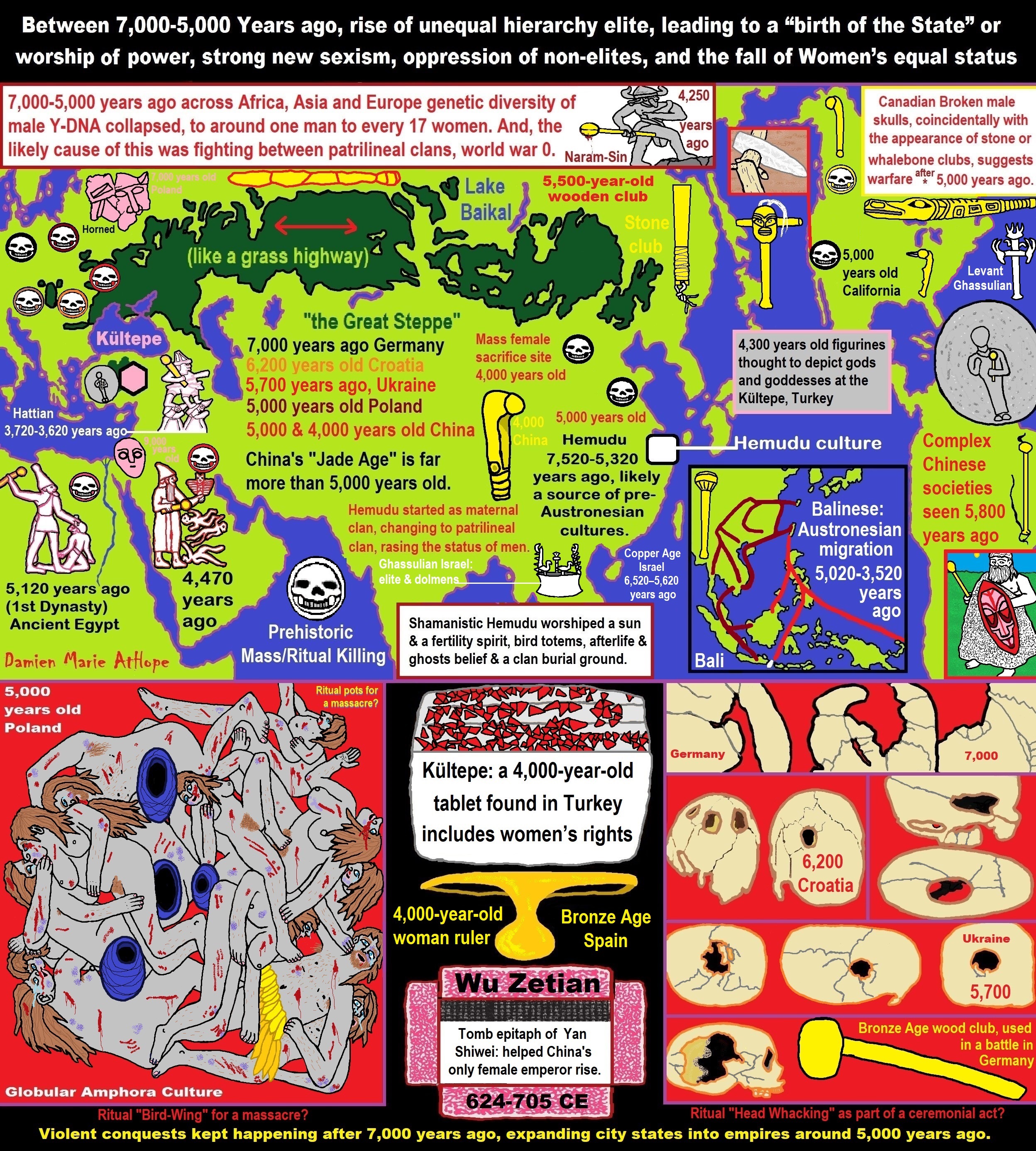
ref, ref, ref, ref, ref, ref, ref, ref, ref, ref, ref, ref, ref, ref, ref, ref, ref, ref, ref, ref, ref, ref, ref, ref, ref, ref, ref, ref, ref, ref, ref, ref, ref, ref, ref, ref, ref, ref, ref, ref, ref, ref, ref, ref, ref, ref, ref, ref, ref, ref, ref, ref, ref, ref, ref, ref, ref, ref, ref, ref, ref, ref, ref, ref, ref, ref, ref, ref, ref, ref, ref, ref, ref, ref, ref, ref, ref, ref, ref, ref, ref, ref, ref, ref, ref, ref, ref, ref, ref, ref
Promoting Religion as Real is Mentally Harmful to a Flourishing Humanity
To me, promoting religion as real is too often promote a toxic mental substance that can divide a person from who they are shaming them for being human. In addition, religion is a toxic mental substance that can divide a person from real history, real science, or real morality to pseudohistory, pseudoscience, and pseudomorality. Moreover, religion is a toxic mental substance that can divide a person from rational thought, critical thinking, or logic. Likewise, religion is a toxic mental substance that can divide a person from justice, universal ethics, equality, and liberty. Yes, religion is a toxic mental substance that can divide a person from loved ones, and religion is a toxic mental substance that can divide a person from humanity. Therefore, to me, promoting religion as real is too often promote a toxic mental substance that should be rejected as not only false but harmful as well even if you believe it has some redeeming quality. To me, promoting religion as real is mentally harmful to a flourishing humanity. Religion may have once seemed great when all you had or needed was to believe. Science now seems great when we have facts and need to actually know.
My Speech on the Evolution of Religion & Religious Sexism
The YouTube for the convention: Atheists of Facebook
Yes, Your Male God is Ridiculous
Hello, My Fellow Non-Believers, I am Damien Marie AtHope and I am an Axiological Atheist, which roughly can be understood as a value theory or value science Atheist. Axiological to Atheism is meant to denote an atheistic rejection of the existence of gods or supreme beings in favor of a “higher absolutes,” such as humanity, formal axiology, or naturalistic or universal ethical principles. Axiological Atheism can be thought to involve ethical/value theory reasoned and moral argument driven atheism, anti-theism, anti-religionism, ignosticism, apatheism, secularism, and humanism.
I am very excited to be a speaker at the first ever Atheists of Facebook Convention. My topics are the Evolution of Religion and Sexism in the Major World Religions.
Now I will begin to discuss Evolution of Religion
When I describe the evolution of religion, I will use the prefixes (primal, proto, and progressed) for the set of stages of development of religion. My use of primal, proto and progressed as prefixes for subclasses I have organized such as early superstitionism, early religionism and organized religionism all connected parts in the evolution of religion. The “Primal” prefix is meant to express the very basic aspects appear but not yet fully evolved or beginning assemblages are starting to come together but lack form, The “Proto” prefix is meant to express the “earliest form of” or all parts of the earliest aspects are now assembled. And, the “Progressed” prefix is meant to express the “concepts or behaviors more fully solidify” or all parts of the aspects are now further developed from previously assembled concepts or behaviors.
I would first like to point out that there seems to be some scant possible hinting of the earliest pseudo-superstition before 1 million years ago and possibly back to 2 million years ago, yet likely this is not yet full superstitionism and defiantly not religion, but there are still elements there that are forming that will further religions’ future evolution.
This pseudo-superstition starts with symbolic, superstition, or sacralized behaviors that may have been possibly exhibited even if only in the most limited ways at start to further standardize around 1 million years ago with primal superstition. Then the development of religion evolution increased around 600,000 years ago with proto superstition and then even to a greater extent around 300,000 years ago with progressed superstition.
Religions’ evolution moves from the loose growing of superstitionism to a greater developed thought addiction that was used to manage fear and the desire to sway control over a dangerous world. This began to happen around 100,000 years ago with primal religion, next the proto-religion stage is around 75,000 years ago or less, the progressed religion stage is around 50,000 years ago, and finally after around 13, 500 years ago, begins with the evolution of organized religion. The set of stages for the development of organized religion is subdivided into the following: the primal stage of organized religion is after 13,000 to 12,000 years ago, the proto organized religion stage is around 10,000 years ago, and finally the progressed organized religion stage is around 7,000 years ago with the forming of mythology and its connected set of Dogmatic-Propaganda strains of sacralized superstitionism.
Click For More on the Evolution of Religion
Now I will begin the discussion on sexism in the Major World Religions with roughly the beginning of sexism and how it is evident in all the Major World Religions.
From the ancient past, evidence shows that sexism was near nonexistent and females were highly valued. Currently in the world with the male dominant thinking, male-centric religions, and the many cultures of societies marginalizing women and promoting of sexism, which all seem to devalue, give a lesser status, or limit the value of women.
Moreover, it should be understood that before there were any male god myths, there were only or mainly female goddesses and animals or aspects of nature, which were held as spirits or something like deities.
Many present-day thinkers may find it difficult to comprehend that women could have been valued, be equal to some extent, or even hold a position of power, especially political power in early historic or prehistoric times. However, from some of the earliest writing, we see that as far back as at least around 6,000 years ago women were documented as leaders and other positions of political authority that went on for thousands of years starting with Legendary Queen of Ethiopia.
Likewise, according to a scientific study, there is further confirmation which shows that sexual equality is nothing new, even if it is something long forgotten. In contemporary hunter-gatherer tribes, evidence shows that men and women tend to have equal influence on important decision-making. Such findings challenge the idea that sexual equality is a recent invention, which suggests that it has been the norm for humans for most of our evolutionary history.
Getting back to the timeline, by at least by 12,000 years ago, female goddesses and not male gods were created; however, the female goddesses may have been created as early as 40,000 years ago or earlier. Furthermore, I surmise around 12,000 years ago the possible beginnings of the hints of sexism and latter patriarchy began. Before 12,000 years ago, women seemed to have a special power of giving life but then things started to change, women started to lose this perceived special or magical status. However, as time went on women were starting to be seen as an object, since animals were being domesticated and humans started to understand birthing. Nevertheless, do not get me wrong, this was not a dramatic shift; it was a slow process of sexism gaining power that took thousands of years to reach full fruition as we think of it today. One of the oldest written religion is of the Sumerians who’s creator being was a Female and not a Male.
The Sumerian religion is around 6,000 years old but it could be much older 7,000 to 8,000 years old. In human history, when did the religious subjugation of goddess and by extension, all women occur? Well, this can also be conserved to happen around 6,000 years ago also. Although, it can be hypothesized that male gods hit the scene in full force around about 5,000 years ago, when women started to lose more, and eventually all value.
The introduction of Proto-Indo-Europeans marked the patriarchalization of agrarian culture. The earliest extant written sources demonstrate that these invading patriarchal peoples accommodated their divinities to those of the indigenous goddess-worshiping cultures, and they did not immediately belittle the importance of the great mother. Instead, the literature from the 5,000 years ago, recorded after the invasions, demonstrates the fusion of the goddess worshiping with the god worshiping culture. In Turkey, archeologists found 4,000-year-old tablets that cite women’s rights. However, more progress sexism continued to develop after 4,000 years ago. Even today, women hardly have any value or even regained a fully equal status. The devaluing, disrespecting, and degrading of women came before societies developed the more fixed class/sex structures as we think of today.
Around 2,000 years ago, the manmade god concept which had taken time to develop finally started to be finalized completely as the only or the main gender of believed gods.
It can be said that one of the male god concept’s goal was or seems to be for male control and domination of female sexuality and their reproductive potential.
Once the male god concept is fully established and by extension men with the promotion of patriarchy, it was relatively easy to maintain and enforce through holy books and laws written by men, which established women’s lower status that deny women of education, their rights to their bodies, and exclude them from decision-making.
Eventually, male dominance and its sexism were established in nearly every known religion as well as every human society and has lasted now for a few millennia. All religions have or are prone and promote sexism, some more than others but it is a shame they all share. Although though there is much more that can be said, I will only offer a few things as evidence of sexism in each of the current major world religions:
Sexism in Judaism (Old Testament):
Exodus 21:7 God not only sanctions selling ones daughter into slavery, but he also gives out laws on how it should be done.
Leviticus 27:3-7 God places a dollar value on human life; with women worth less than men.
Deuteronomy 22:23-24 women who are raped and fail to “cry out” likely enjoyed the attack thus should be killed.
Sexism in Christianity (New Testament):
1 Corinthians 11:7 – 9 “For a man is the image and glory of God: but the woman is the glory of the man. For the man is not of the woman; but the woman of the man.
Romans 7:2 “For the woman who hath a husband is bound by the law to her husband as long as he lives.
Titus 2:4-9 “Train the young women to be submissive to their husbands.
Qur’an (4:11) – (Inheritance) The male shall have the equal of the portion of two females (see also verse 4:176).
Qur’an (4:24) and Qur’an (33:50) – A man is permitted to take women as sex slaves outside of marriage.
Qur’an (4:34) – Men are in charge of women and good women are the obedient, because Allah hath made the one of them to excel the other.
Manusmriti 5.148. In childhood a female must be subject to her father, in youth to her husband, when her lord is dead to her sons; a woman must never be independent.
Manusmrti (9:2-4) – Men must make their women dependent day and night, and keep under their own control those who are attached to sensory objects. A woman is not fit for independence.
Rig Veda (8:33:17) – The mind of woman cannot be disciplined; she has very little intelligence.
Historical Buddha said the female’s defects greed, hate, delusion, and other defilements are greater than the male’s.
Historical Buddha who refused to ordain women as nuns. He said that allowing women into the sangha would cause his teachings to survive only half as long.
A popular belief in Buddhist countries is that negative karma results in a man being reborn as a woman and in Sukhavati-vyuha Sutra (Pure Land Buddhism) women must be reborn as men before they can enter Nirvana. Theravadan Buddhists claim a woman could never become a Buddha. The Ecclesiastical
Buddhist Council of Thailand, announced publicly that any monk who supports the ordination of women will be subject to severe punishment.
The Kanamara Matsuri (“Festival of the Phallus”) is a Shinto celebration centred on a local penis-venerating shrine in Kawasaki, Japan. The legend being that a sharp-toothed demon (vagina dentata) hid inside the vagina of a young woman and castrated two young men on their wedding nights. As a result, the young woman sought help from a blacksmith, who fashioned an iron phallus to break the demon’s teeth, which led to the enshrinement of penis-venerating.
A spiritual practice specific to women involves a relationship to sight because they are always blind or visually impaired. Male sight, specifically women out of the public eye, occupies a privileged position in everything from ancient myths to the modern wedding ritual and continually exerts an oppressive influence on the lives of women, monitoring and impeding their public movements.
“Feminine Pollution” involves the idea in Shinto ritual, which has been used in the past to justify discrimination against women. Therefore, women have historically been pushed out of the public eye and out of public religious spaces because of their supposed impurity and to this day women are haunted by the belief in their inherent pollution.
The Gurus’ teaching on the role of women is stated as, “we are conceived and born from women. Woman is our life-long friend and keeps the race going. Why should we despise her, the one who gives birth to great men?” – Guru Granth Sahib Ji (the third Guru). Well, that still is saying its men that are great because of whom they are and women great only because they can produce great men still sounds like sexism to me.
Only Men as Guru only Men as the five Panj Pyare yes try to tell me of how Sikhism is completely equal to women…
Shiha Kaur a self-claimed feminist Sikh states,“ ancient cultural traditions sometimes take precedence over the principles of in Sikhism. Maharaja Ranjeet Singh, one of the most famous Sikh Kings in Moghul India often considered a model Sikh, had seven wives. Not only does polygamy go against Sikh beliefs but also half of his wives committed sati (widowed woman commits suicide by fire) when he died in 1839. In India today, school attendance of Sikh girls is lower than that of Sikh boys. The Asian Network has reported in the rise of Asian couples ttraveling to India to abort female fetuses and no sweets are shared among Sikh relatives to celebrate the birth of a girl, as usually happens when a boy is born.”
Jainism does not teach that women can gain ultimate spiritual liberation, though a woman could strive to become a man in her next life so she could then reach enlightenment.
Jains believe, for example, that even microbes in the air and water are sacred life and any action that impacts other living things – such as driving or using electricity – can add to bad karma. Therefore, to Jains the bleeding which occurs in menstruation is thought to kill micro-organisms in the body, making the female body less nonviolent than the male body and the female body more prone to bad karma.
Digambara texts say that women’s genitals and breasts are sources of impurity and have many micro-organisms living in them. Digambara Jain theologians have written that due to bodily secretions, women suffer from itching which gives them uncontrollable sexual urges. They believe that women cannot take higher vows of ascetic renunciation, because naked women would have two deep emotions: shame of being naked and fear of sexual assault which they might face.
Confucius about women is “Shaoren and girls are difficult to handle. If you get familiar with them they cease to be humble. If you keep them away, they get resentful.” (Analects 17:25) This sure sounds insulting to women.
A well-known sexist Confucianism commandments is “Since the age of seven, men and women should not share a room or food” and “When young, a woman should obey the father, when married, the husband, when old, the son” are creations of later generation of Confucian scholars who developed a greater sexist tendency since the Tang dynasty era (618-907 C.E.).
According to the Confucian structure of society, women at every level were to occupy a position lower than men. Most Confucians accepted the subservience of women to men as natural and proper.
The Tao sees the world as male (yang) and female (yin) which is very sexist. Some think the yin and yang are just good and bad. Never heard of it as sexist. But the white is male and the black is female. Chinese literature beginning with the classic cannon Yijing (book of Changes) we see sexism as we find the male (yang) symbolized as day or the sun embodying everything good and positive, and this status is identified with heaven. Whereas the female (yin) is symbolized as night or the moon embodying everything negative, evil and lowly. Ref
The idea of balancing male and female energies is fundamental to Taoism, and applies to women as well as to men. One early practice was ritual sexual intercourse between men and women who were not married to one another. These rituals followed strict guidelines, and the goal was the union of yin and yang energies. In the Taode jing offers a females role is made clear in passages like this one from Chapter 61: “The Feminine always conquers the Masculine by her quietness, by lowering herself through her quietness. The general stance on gender is there are attitudes expected of women, such as keeping a cheerful attitude or speaking in quiet tones. Divine marriages with deities were one very ancient version of this practice. Ref
Taoist sexual (and sexist) practices: Sex and the concept of Yin and yang is important in Taoism. Man and Woman were the equivalent of heaven and earth, but became disconnected. Therefore, while heaven and earth are eternal, man and woman suffer a premature death. Every interaction between Yin and Yang had significance. Because of this significance, every position and action in lovemaking had importance. Taoist texts described a large number of special sexual positions that served to cure or prevent illness. The basis of all Taoist thinking is that qi is part of everything in existence. Qi is related to another energetic substance contained in the human body known as jing (精), and once all this has been expended the body dies. Jing can be lost in many ways, but most notably through the loss of body fluids. Taoists may use practices to stimulate/increase and conserve their bodily fluids to great extents. The fluid believed to contain the most Jing is semen.
Women were often given a position of inferiority in sexual practice. Many of the texts discuss sex from a male point of view, and avoid discussing how sex could benefit women. Men were encouraged to not limit themselves to one woman, and were advised to have sex only with the woman who was beautiful and had not had children. While the man had to please the woman sexually, she was still just an object. At numerous points during the Ishinpō, the woman is referred to as the “enemy”; this was because the woman could cause him to spill semen and lose vitality. In later sexual texts from the Ming, women had lost all semblance of being human and were referred to as the “other,” “crucible”, or “stove” from which to cultivate vitality.
The importance of pleasing the woman was also diminished in later texts. The practice was known as Caibu (採補), as a man enters many women without ejaculation. Women were also considered to be a means for men to extend men’s lives. Many of the ancient texts were dedicated explanation of how a man could use sex to extend his own life. But, his life was extended only through the absorption of the woman’s vital energies (jing and qi). Some Taoists called the act of sex “The battle of stealing and strengthening.”
These sexual methods could be correlated with Taoist military methods. Instead of storming the gates, the battle was a series of feints and maneuvers that would sap the enemy’s resistance. Some Ming dynasty Taoist sects believed that one way for men to achieve longevity or ‘towards immortality’ is by having intercourse with virgins, particularly young virgins. Taoist sexual books, such as the Hsuan wei Hshin (“Mental Images of the Mysteries and Subtleties of Sexual Techniques”) and San Feng Tan Cheueh (“Zhang Sanfeng’s Instructions in the Physiological Alchemy”), written, respectively, by Zhao Liangpi and Zhang Sanfeng (not to be confused with semi-mythical Zhang Sanfeng who lived in an earlier period), call the woman sexual partner ding (鼎) and recommend sex with premenarche virgins.
Zhao Liangpi concludes that the ideal ding is a premenarche virgin just under 14 years of age and women older than 18 should be avoided. Zhang Sanfeng went further and divided ding into three ranks: the lowest rank, 21- to 25-year-old women; the middle rank, 16- to 20-year-old menstruating virgins; the highest rank, 14-year-old premenarche virgins. Ref, Ref
Highest leadership of the religion where only men Central figures: Bahá’u’lláh The Báb `Abdu’l-Bahá aso all men.
Women are excluded from serving on the religion’s highest governing body, the Universal House of Justice, which is confined to men only is sexist and does constitute evidence of the Bahá’í Faith support of superiority of men over women.
In 1997, a Canadian fantasy writer was disenrolled, primarily for his outspokenness on email forums for women’s full inclusion in Baha’i administration. Furthermore, in the Baha’i Faith there are particular cases of assignment of different roles to women and men at the level of individual life, family, and society.
Click For More on Sexism in Religion
- Stone Snake of South Africa: “first human worship” 70,000 years ago: Link
- Totemism and Shamanism Dispersal Theory Expressed around 50,000 to 30,000 years ago: Link
- 31,000 – 20,000 years ago Oldest Shaman was Female, Buried with the Oldest Portrait Carving: Link
- Sedentism and the Creation of goddesses around 12,000 years ago as well as male gods after 7,000 years ago: Link
- 5-600-year-old Tomb, Mummy, and First Bearded Male Figurine in a Grave: Link
- 5,500 Years old birth of the State, the rise of Hierarchy, and the fall of Women’s status: Link
- Single God Religions (Monotheism) = Man-o-theism started around 4,000 years ago: Link
- Early monotheism: Zoroastrianism (around 2,600 – 2,100 to possibly 4,000 years ago) and Atenism (around 2,140 years ago) totally monotheistic: Link
- Kultepe? An archaeological site with a 4,000 years old women’s rights document: Link
Around 500,000 – 233,000 years ago, Oldest Anthropomorphic art (Pre-animism) is Related to Female
The Berekhat Ram (anthropomorphic Repersinitive art is related to female) sculpture, has a groove around the neck and on the sides which have been shown to be deliberate modifications absent from other scoria found in the area. The archaeologist Alexander Marshak examined the pebble using an electron microscope. He concluded that it had been made, or enhanced, by hominid hand, the hominins who found and worked on their respective pieces would have been unaware of their future significance.
The Venus of Berekhat Ram is a pebble found at Berekhat Ram on the Golan Heights, Israel. The base object is an anthropomorphic red tufic pebble, 35 mm (1.4 in) long, which has had at least three grooves, possibly incised on it by a sharp-edged stone. One is a deep groove that encircles the narrower, more rounded end of the pebble, two shallower, curved grooves run down the sides. These grooves can be interpreted as marking the neck and arms of a figure. Because it was found between two layers of ash, it has been dated by tephrochronology to at least 230,000 years before the present but is at a range of 500,000 – 233,000 Years Ago. Moreover, lf the artifact was intended to replicate a female figure, it would be the earliest example of representational art in the archaeological record. Rather than being made by modern humans, it would have been made by Neanderthals or perhaps by Homo erectus, hunter-gatherers and Acheulean tool users.
There is some other evidence of an aesthetic sensibility during the period although compelling examples do not appear in the archaeological record until the emergence of behaviorally modern humans around 50,000 years ago. The venus of Berekhat Ram is a red stone figure with symbolic intent and possibly intended to represent an anthropomorphic female figure. The surface is a bright high red with a large hole lined with black volcanic glass is at the approximate position of a ‘navel.’ Venus figurines are often found in different elements or mediums from limestone, serpentine, ivory, clay, and bone ash and are dispersed from western Europe to Siberia.
These figurines are often faceless with downturned heads, large breasts, buttocks (many-extreme fat), some possibly pregnant, several stuck into the ground, and found near cave walls or in hearths. So what are the possible explanations of Venus figurines? They could be some kind of good luck charms (evidence of polish), symbols of fertility, cult objects, art, Paleolithic porn, or representations of women by women or men (some look like modern pregnant bodies and some very skinny) but overall there may be no one reason. These figurines may have been created for several different reasons depending on time, place, and people but we just do not know. Though calling them all goddesses or venus is at least misleading if not outright uncalled for because of mythologizing motivated by current projections and this is true even if a few were seen as some kind of goddesses.
However, the venus of Berekhat Ram even if just anthropomorphic art (i.e. ascribing human form or attributes to a thing not human) could be seen as possibly the earliest known archaeological manifestations of any kind of elements that later become more defined religious belief systems. This is reasonable because anthropomorphic character design in art is a symbolic use of design to portray personality and thus, natural objects resembling the human body (or parts of it) which have received minor amounts of intentional modification in order to bring out the similarity further for the desired purpose. One could possibly even surmise that for some, there may have been a character that can play a possible part in telling stories.
Thus, anthropomorphic art, such as Venus figurines, may connect or be a larger growing fantasy of symbolism, superstitions, and supernaturalism thus to socio-cultural-religious transformations or evolution. Although one cannot at present rule out a purely fortuitous association with the venus of Berekhat Ram and the piece can hardly be described as artistic, the possibility remains that it can be placed in the figures category as unambiguous indicators of early symbolism, let alone ritual, and we should not write it off as casual ‘lithic art’. Instead, the appearance of precocious lithic technologies such as end-scrapers and stone chisels at Berekhat Ram, symbolism (and by extension perhaps ritual) drifted in and out of use over evolutionary time. Ref, ref, ref, ref, ref, ref, ref
Read more in the Art of the Ice Age section: Link
40,000 years ago “first seeming use of a Totem” ancestor, animal, and possible pre-goddess worship?
40,000 – 35,000 years ago “first seeming use of a Totem” ancestor and possible pre-goddess worship? There is, to me, evidence of possible ‘ancestor and possible pre-goddess worship’ at Hohles Fels cave Site, such as a small bird figurine around 33,000 years old is one of three carvings important as well as relatable to later times, which had been cited as evidence of shamanism, the belief that spirits can be influenced by priests known as shamans. A female fertility figurine ( pre-goddess Venus of Hohle Fels), a bird in addition to bird-bone flute— from a griffon vulture wing dated to around 35,000 years ago as well as around 40,000 years old mammoth-ivory flutes and the 40,000 years old the Lion man of the Hohlenstein Stadel. as well as “first seeming use of a Totem” as the female fertility figurine may have been worn as an amulet, along with seeming ancestor, animal, and possible pre-goddess worship. (the oldest known wooden sculpture Shigir Idol “totem pole” 17 feet high and approximately 11,500 years old and the Shigir Idol’s decoration has been thought by scholars to be similar to that of the oldest known monumental stone ruins, at Gobekli Tepe in Turkey.) ref
31,000 – 20,000 years ago Oldest Shaman was Female, Buried with the Oldest Portrait Carving
31,000 – 20,000 years ago, Oldest Shaman was Female (Dolni Vestonice, Czech Republic) Buried with the Oldest Portrait Carving. Dolní Věstonice (often without diacritics as Dolni Vestonice) refers to an Upper Paleolithic archaeological site near the village of Dolní Věstonice, Moravia in the Czech Republic. The site is unique in that it has been a particularly abundant source of prehistoric artifacts (especially art) dating from the Gravettian period, which spanned roughly 27,000 to 20,000 B.C. In addition to the abundance of art, this site also includes carved representations of men, women, and animals, along with personal ornaments, human burials, and enigmatic engravings. ref
One of the burials, located near the huts, revealed a human female skeleton aged to 40+ years old, was found at Dolni Vestonice in an elaborate burial setting, ritualistically placed beneath a pair of mammoth scapulae, one leaning against the other. Also found was a carved ivory figure in the shape of a female head. The left side of the figure’s face was distorted. These and other items were found with the woman seemed to have had a profound impact on the interpretation of the social hierarchy of the people at the site, as well as indicating an increased lifespan for these inhabitants. The remains were covered in red ochre, a compound known to have religious significance, indicating that this woman’s burial was ceremonial in nature. Also, the inclusion of a mammoth scapula and a fox may indicative of what could be shamanistic ritual and/or a high-status burial. Surprisingly, the left side of the skull was disfigured in the same manner as the aforementioned carved ivory figure, indicating that the figure was an intentional depiction of this specific individual.
The bones and the earth surrounding the body contained traces of red ocher, a flint spearhead had been placed near the skull, and one hand holding the body of a fox. This evidence suggests that this was the burial site of a shaman. This is the oldest site not only of ceramic figurines and artistic portraiture but also of evidence of female shamans. In the Upper Paleolithic, anatomically modern humans began living longer, often reaching middle age, by today’s standards. Rachel Caspari argues in “Human Origins: the Evolution of Grandparents,” that life expectancy increased during the Upper Paleolithic in Europe (Caspari 2011). She also describes why elderly people were highly influential in society. Grandparents assisted in childcare, perpetuated cultural transmission, and contributed to the increased complexity of stone tools (Caspari 2011).
The woman found at Dolni Vestonice was old enough to have been a grandparent. Although human lifespans were increasing, elderly individuals in Upper Paleolithic societies were still relatively rare. Because of this, it is possible that the woman was attributed with great importance and wisdom, and revered because of her age. Because of her advanced age, it is also possible she had a decreased ability to care for herself, instead of relying on her family group to care for her, which indicates strong social connections. Furthermore, a female figurine was found at the site and is believed to be associated with the aged woman, because of remarkably similar facial characteristics. The woman was found to have deformities on the left side of her face.
The special importance accorded with her burial, in addition to her facial deformity, makes it possible that she was a shaman in this time period, where it was “not uncommon that people with disabilities, either mental or physical, are thought to have unusual supernatural powers” (Pringle 2010). In 1981, Patricia Rice studied a multitude of female clay figurines found at Dolni Vestonice, believed to represent fertility in this society. She challenged this assumption by analyzing all the figurines and found that, “it is womanhood, rather than motherhood that is symbolically recognized or honored” (Rice 1981: 402). This discovery challenged the widely held assumption that all prehistoric female figurines were created to honor fertility. The fact is that we have no idea why these figurines proliferated nor of their purpose or usage. ref
- Early Shamanism around 30,000 to 20,000 years ago: Sungar (Russia) and Dolni Vestonice (Czech Republic)
- Shamanism: an approximately 30,000-year-old belief system
- Black, White, and Yellow Shamanism?
- Similarity in Shamanism?
- Sky Burials: Animism, Totemism, Shamanism, and Paganism
- ‘Sky Burial’ theory and its possible origins at least 12,000 years ago to likely 30,000 years ago or older.
- Paganism: an approximately 12,000-year-old belief system
- 12,000 – 10,000 years old Shamanistic Art in a Remote Cave in Egypt
- 12,000 – 7,000 Years Ago – Paleo-Indian Culture (The Americas)
- 12,000 – 2,000 Years Ago – Indigenous-Scandinavians (Nordic)
- Horned female shamans and Pre-satanism Devil/horned-god Worship? at least 10,000 years ago
- Shamanistic rock art from central Aboriginal Siberians and Aboriginal drums in the Americas
- 9,000-8,500 year old Female shaman Bad Dürrenberg Germany
Where did the god come from? Well, to me, it likely connects to the area of the Altai Mountains, a mountain range in Central and East Asia, where Russia, China, Mongolia, and Kazakhstan the heart of ancient shamanism.
The Shaman is a kind of a priest or medium who acts as a conduit between the human world and the realm of the gods, demons, and spirits of ancestors. The experience of death and rebirth is the most important condition for obtaining the power of shamanizing: only after this experience does a shaman reach the level at which his spirit-assistant sees fit to appear to him. in Siberian and Mongolian “petroglyphic art” there are some examples to support a thesis that these anthropomorphic figures may represent shamans and, since in Siberia the local shamanic folklore was continuous, have several types of symbols referencing the sun, skeletonized humans, horned figures may represent the proto-shamans.
As signs, these anthropomorphic figures may represent an important, non-ordinary member of the community.considers the question of the antiquity of shamanism in Central Asia and outlines several lines of inquiry into the issue. It analyses both linguistic and archaeological data with particular emphasis on ancient rock art. In the sphere of rock art studies, it focuses on methodological questions connected with identifying shamanism in visual arts. Historical records from different times and parts of Asia clearly show that shamanism is an archaic belief system of Asian peoples.
Although shamanic beliefs and practices have been documented in different parts of Asia, many studies still consider Siberia to be the land of their most classic forms. Furthermore, there is no single word for shaman across Siberia and Central Asia. Almost every culture has its own name for this spiritual practitioner, and even in a single language group the names for shaman differ regionally. And, research concludes that most convincing traits of shamanic symbolism, which characterizes Central Asian tradition, can be deciphered in the art dated to four thousand years. ref, ref
To understand fully read thess:
- Kurgan 6,000 years ago/dolmens 7,000 years ago: funeral, ritual, and other?
- Ziggurats (multi-platform temples: 4,900 years old) to Pyramids (multi-platform tombs: 4,700 years old)
- 4,250 to 3,400-Year-old Stonehenge from Russia: Arkaim?
Art as Evidence
Stone Shamans and Flying Deer of Northern Mongolia – Smithsonian
Mongolia’s Bronze Age deer stones are one of the most striking expressions of early monumental art in Central Asia, yet their age, origins, relationships, and meaning remain obscure. Speculation about Scythian connections has stimulated recent research in Mongolia that has begun to peel away their mysteries and reveals connections to Scytho-Siberian and northern art. Radiocarbon-dated horse skulls indicate pre-Scythian ages of “classic Mongolian” deer
stones as well as firm association with the Late Bronze Age khirigsuur [kurgan] burial mound complex. – Smithsonian
A 4,000-year-old art gallery found in Siberia, of ancient images of humans, a bull, trees, and birds (could this relate to sky-burials: ‘Sky Burial’ theory and its possible origins at least 12,000 years ago to likely 30,000 years ago or older. This (Sky Burials: Animism, Totemism, Shamanism, and Paganism) I believe sky-burials also somehow relates to shaman rituals of when a would-be shaman goes into a trance in order to undergo the mystical dismemberment of his body by spirits, the loss of his flesh, and to contemplate his own skeleton., which explains the connections of tres that reach the heavens where the birds live and the birds eat the dead taking the spirits of ancestors to the heaves such as the treetops and the believed heavens above and I also think there is a connection of stars to ancestors as well possibly.
There is a practice of hanging bulls from trees as well and I image the birds would eat them too and the bull’s horns have connections to beliefs of them representing the moon in the heavens or the sun represented as a believed spiritual/magical energy-spirit of the sun between the horns holding it. The Tibetan sky-burials appear to have evolved from ancient practices of defleshing corpses as discovered in archeological finds in the region. These practices most likely came out of practical considerations, but they could also be related to more ceremonial practices similar to the suspected sky burial evidence found at Göbekli Tepe (11,500 years before present) and Stonehenge (4,500 years ago). Moreover, there is a 4,000-year-old art gallery found in Siberia contained 20-plus ‘perfectly preserved’ petroglyphs in a remote spot in the Transbaikal region.
Most intriguing in the newly revealed rock art is a figurine and nearby a human-like image is a circle, seemingly a sign of the sun. Scientist Sergei Alkin said: ‘We can assume that the figure with the solar sign depicts a shaman with a drum.’ 4,000 years ago (2000 BC) — we see the Seima-Turbino Phenomenon originating in the Altai Mountains leads to rapid and massive migrations westward across the Urals into north-eastern Europe and eastward into China and South-east Asia.
Seima-Turbino phenomenon refers to a pattern of burial sites dating from 2100 BCE to 1900 BCE found across northern Eurasia, from Finland to Mongolia, which has suggested a common point of cultural origin, advanced metalworking technology, and unexplained rapid migration. The buried were nomadic warriors and metal-workers, traveling on horseback or two-wheeled chariots. These cultures are noted for being nomadic forest and steppe societies with metal working, sometimes without having first developed agricultural methods. The development of this metalworking ability appears to have taken place quite quickly. The Altai Mountains in what is now southern Russia and central Mongolia have been identified as the point of origin of the cultural enigma of Seima-Turbino Phenomenon.
The Altai Mountains have been identified as being the point of origin of a cultural enigma termed the Seima-Turbino Phenomenon which arose during the Bronze Age around the start of the 2nd millennium BC and led to a rapid and massive migration of peoples from the region into distant parts of Europe and Asia. In regard to religion, some of the Altay remain Altai people Shamanists. The name “Altai” means “Gold Mountain” in Mongolian; “alt” (gold) and “tai” (suffix – “with”; the mountain with gold) and also in its Chinese name, derived from the Mongol name (Chinese: 金山; literally: “Gold Mountain”). In Turkic languages, altın means gold and dağ means mountain. The culture spread from these mountains to the west. Artifact types such as spearheads with hooks, single-bladed knives and socketed axes with geometric designs traveled west. Although they were the precursor to the much later Mongol invasions, these groups were not yet strong enough to attack the important social sites of the Bronze Age.
It is conjectured that changes in climate in this region around 2000 BC and the ensuing ecological, economic and political changes triggered a rapid and massive migration westward into northeast Europe, eastward into China and southward into Vietnam and Thailand across a frontier of some 4,000 miles. This migration took place in just five to six generations and led to peoples from Finland in the west to Thailand in the east employing the same metalworking technology and, in some areas, horse breeding and riding. However, further excavations and research in Ban Chiang and Ban Non Wat,
Thailand argue the idea that Seima-Turbino brought metal workings into southeast Asia is based on inaccurate and unreliable radiocarbon dating at the site of Ban Chiang. It is now agreed by virtually every specialist in Southeast Asian prehistory, that the Bronze Age of Southeast Asia is too late to relate to Seima-Turbino, and the cast bronzes are quite different. It is further conjectured that the same migrations spread the Uralic group of languages across Europe and Asia: some 39 languages of this group are still extant, including Hungarian, Finnish, Estonian and Sami.
However, recent genetic testings of sites in south Siberia and Kazakhstan (Andronovo horizon) would rather support a spreading of the bronze technology via Indo-European migrations eastwards, as this technology was well known for quite a while in western regions. “Radiocarbon Chronology of Complexes With Seima-Turbino Type Objects (Bronze Age) in Southwestern Siberia.” The religion of altai, the main and the most ancient religion of Altai region was shamanism. The traditional religion of the native Altaians is Tengrist shamanism, revived by modern Tengrist movements and Burkhanism.
First, written sources about shamanism belongs to the second half of the 6th century. The religion originated in Altai and emphasized the “white” (could this relate to snow-covered mountains in the region?) aspect of shamanistic practice. Black, White, and Yellow Shamanism? Burkhanism remains an important component of Altai national consciousness and is currently being revived in several forms along with indigenous Altai culture in general. Characteristics of shamanic drums and costumes of ancestors of modern Tuva formed in the second half of the 1st millennium.
Peoples of South Siberia and Mongolia have been already used developed shamanic cults with a characteristic feature as a priest chosen to communicate with spirits, using a tambourine during the ritual, falling into trance and traveling to the spirit world. Archaeological materials of Bronze Age, monumental sculptures, rock paintings show the complexity of the religious beliefs of tribes inhabiting the territory of the Altai Mountains (3 millennium BC. – 9 century BC.). They allow seeing elements of Indo-European mythological tradition, images of shamans and spirits of patrons.
Iconography images associated as with unique images related with early Buddhist subjects, so with Tibetan Buddhism, which originated on the basis of pre-Buddhist religion of Tibet Bon, also known as yundrun Coupons – “tradition of eternal wisdom”. The outlook of tribes inhabiting Altai represented a synthesis of several religious courses, which was reflected in funeral ceremony and arts in the Scythian period (8-2 centuries BC). Scythian culture mixed shaman, Zoroastrian and Buddhist ideas.
Symbiosis of Indo-European and shamanic burial vividly presented at the funeral ceremony in Altai Pazyryk barrows (Tuekta, Bashadar, Pazyryk). Despite high degree of religious beliefs of that period, the tribes have preserved the cult of fire, sun, ancestors, as well as elements of magic and witchcraft. Archaeologists have found strands of human hair sewn into skin, nails and various charms in Pazyryk burial mounds. Archaeological evidence confirms the presence of special techniques of ecstasy, ritual fumigation and using of ritual drink “catfish” in the religious practices. Huns had extensive political and economic relations with countries which had a Buddhism as a main religion since 2 in. BC. Chinese source “Wei Shu” (506-572 AD.) mentioned that the Huns had worshiped to Buddhist statue of the great deity and smoked incense in 121 BC. But it is difficult to prevent widespread Buddhism among Huns because of lack of other historical documents.
Altai tribes were descendants of ancient tribes and other great cultures at various times. They interacted with the Buddhist world: ancient Turkic period, western Mongols (Oirat), then a period of gradual strengthening of Buddhism in North-Western Mongolia and formation of Burkhanism. The indigenous Altai culture holds the lands of Altai to be sacred. The indigenous (Turkic) languages are focused on the stewardship of the lands. The Altai oral history is transmitted by throat-singers. Altai shamanism representation about “a double” is the dominant concept which explains the mechanism of the main religious ritual practice a Kam. Representation about individual double reflects the faith of cycle of human existence. Every human life begins in the heavenly area of the universe, yet it has not an anthropomorphic shape, then it is sent to the Earth in physical form.
For example, in the form of a shooting star or a ray of sunlight. These embryos are falling through the smoke hole in the center of yurt, and then fall to a woman. So the fetal period of human life begins. It is concerned with a female deity called Umai. “A double” has the ability to separate from the body into a form of small lights and to travel to different places and back to the body during sleep. A man should behave especially cautious in mountains. He should be wary of a double output during sleep. If a person has a guilt, then the spirit of the mountains or taiga can catch and leave his double. This often happens. Only shaman can return a double. Shaman continues to possess special properties even after death of his double. Ordinary people double backs to the deity. A Kam double remains on the Earth. He lives in the mountains or taiga, and he is not associated with the burial place of the shaman. The Double determines the fate of the new Kama among any of his descendants.
The double will serve as one of his hereditary patrons. Another important provision of Altai Shamanism in additional to «a double concept” is faith in spirits of shaman, composing its sacred magical power. This position keeps religious practice, the entire cult of shamanism. Shamans know that nobody can be a kam without kam-intermediary spirits. Nobody dares to go to such a dangerous journey as a kam is without the support of spirits. All religious activities that make by a shaman, and achieved results are carried out with the help of the spirits, which called him at the beginning of each ritual. Every shaman has his own spirits. Spirits are divided into groups called «strata”. The first group included Protector Spirits, the second group is helper spirits. Patrons are spirits of high rank such are the God of fire, the Gods of sacred mountains etc.
Helpers perform two groups. The first called “Tos”, uniting shaman ancestors being kams during its life. The second group included ministering spirits, called during ritual by tambourine blowing. These spirits attend a shaman during his travels to one or another sphere of the Universe. Tambourine ministering spirits called as “chalular” consist the real strength of a shaman. Shaman appreciates and seeks to increase these spirits, convokes ancestors of shamans. Personal spirits of shaman determine its religious and magical power. The deity of fire differs among patron spirits. It is called Ot-Ana — mother fire in Altai. This deity has entered the pantheon of Altai shamanism heritage from ancient times. Altai kama begins kam ritual celebrating, treating and turning to Ot-Ana calling. Shamans ask Ana to give companions for upcoming travels and always receive the assistance.
Spirits of sacred mountains are also high patrons of shaman. They give a tambourines for special prayer rituals to shamans. Shamans treated spirits of sacred mountains with different requests of welfare for family, for Ulus and people. A Kama receives shamanic mission, shamanic inherited gift from spirits of shaman ancestors. If the Altai shows the signs of a shaman, so it is said: “Tosi (ancestors spirit) comes». Cult of ancestor shaman provides continuity of shamanism and explains the mechanism of occurrence and formation of shamans. Tambourine and shaman ritual vestments are sacred objects of worship since it serves as a refuge for spirit helpers. When the shaman strikes tambourine, spirits rush towards him. Some of them place in the drum, the other place on the ritual vestments. Others, the most important, move into shaman himself, who gathers them by a deep breath. Tambourine connected with not only ritual activities but also with shaman life.
If tambourine skin breaks or blood appears during the ritual, it means spirits came to punish the shaman and he dies soon. Tambourine is the main ceremonial instrument which given as a certificate for ritual from the supreme deity. Having made a tambourine, shaman shows it to deity. The ceremony of manufacturing and reviving tambourine continues for several days with a large crowd. After the ritual shaman goes to the spirit of the sacred mountain and there, showing the drum, gets permission to kam until he will make next tambourine. After the ceremony shaman kams alone. He hides a chula (a double of animal from which tambourine was made) from other shamans and hostile forces. If the drum is made of deerskin, so shaman hides it in taiga, if it is made of horse skin, so he hides in a tree hollow. A kam calls on spirits beating a drum at night to consult with them, to find out their wishes. Shaman makes spirits to watch the book “Sabyr Bichik.”
Which help to find things that do not require a large ritual, for example, any prediction. Ritual vestments are necessary to communicate with the spirits. Production is carried out by instructions of the spirits-protectors. Vestments have a complex appearance. It includes braids, hundreds of different pendants, small chunks of tissue, ribbons, fringe, animal skins and their parts (claws, feathers, beaks, wings); rag anthropomorphic images of snakes, monsters. Suit serves as a refuge for shaman spirits which protect a kam during the ritual. Making shaman costume is collective women engagement.
It takes place at the specific time and is accompanied by a special ceremony. This ceremony is held with large crowd and is used to remove filth from vestments, which can be left after a touch of the hands of bad people. But the main aim of the ceremony is to determine the suitability of the suit. A kam ritual differs by acting, songs, Gods which summoned by a shaman. Every shaman has his god and kams to it him. Only Ulgen and Erlik gods are common to all Altaian. The ritual has to express the journey of a shaman and his retinue of spirits to the distant abode of the deity. If a deity lives in heaven, for example, Ulgen, the mystery of Kam should clearly describe the journey to heaven, and shaman has to move from one sky to another until he reaches the last sky.
If deity lives underground, such as Erlik, the mystery shows how the shaman descends to the underworld. Idolatry of Altai peoples came to symbolic representation of a good and an evil. Horses, bulls, and sheep sacrificed to gods, barbarously slayed dissecting animal chest and squeezing the heart by hands to stop beating. However, all this comes with extraordinary rapidity, the animal dies instantly. Then the victim will be roasted and eaten. Primitive representations of deity forces shamans to look at the sacrifices as a contract binding both parties by mutual obligations.
The UNESCO World Heritage Site “Golden Mountains” protects the Ukok Plateau, on which there are many standing stones and kurgans. Although archaeologists consider kurgans to be burial sites, the indigenous people believe that they are highly refined magnetic instruments for directing the flow of cosmic energy into the Earth. Thus, there is great local indignation about the excavation and removal of the Siberian Ice Maiden, an extraordinary 2,500-year-old mummy that had been preserved in permafrost. The mummified remains of the “Ice Maiden,” a Scytho-Siberian woman who lived on the Eurasian Steppes in the 5th century BC, were found undisturbed in a subterranean burial chamber. ref, ref, ref, ref, ref, ref, ref, ref
Need to Mythicized: gods and goddesses
The question should not just be is there a god, but which gods we are to contemplate, the new ones or old ones. Not that it really matters much in the end, as they all eventually cease to exist or replaced for something new. If there were a true god deity, would he not make himself known as soon as hominoids could think or at least by around 100,000 years ago when the first confirmed human burial took place or at least, by around 50,000 years ago when it is thought we fully achieved modern behavioral and cognitive traits?
However, this is not the case at all, instead, the male god myths do not seem to exist for tens of thousands of years or must have held less status until around 6,000 or so years ago. What was prominent before the male god myths seem to be female goddesses and animals or aspects of nature, which were held as spirits or something like deities. Female goddesses and not male gods seemingly starting after 12,000 years ago for sure, but maybe go back to 40,000 years ago or even longer, who knows hypothetically in some fashion to possibly over 200,000 years ago, but maybe not. So not much credibility can be given prehistorically for the male gods, thus why add any credence to them now. Therefore, male gods prominent in the current religions of the world today have a shelf-life of only around 6,000 or so years ago, not much of a showing if it is a male god who supposedly created everything. Why wait through 95% of human existence to make yourself known? A little over 5,000 years is when it looks like god deities really develop or finally leave the shadows and are promoted in a way that can be identified today.
The male god deities, so many now hold faith in today, such as in the abrahamic religions said to start around 4,000 years ago or less with judaism’s patriarch Abraham was a late bloomer to say the least, as this abrahamic male god did not really beginning to be written down until after around 3,000 years ago. And why, we must wonder did it take so long to start writing the jewish holy book, which as you may know took around 1,000 years to finish. Well because other peoples had to create and spread written language, for the Israelites to borrow from, as their god did not I guess, put big stock in literacy or would not the jews be the first ones with writing if only their god was real. Moreover, one must ask if real, why did he not do anything to become known even when the creation of other male gods started. Nevertheless, it was not until around 2,000 years ago that the prospects of the male god deity became the most popular supplanting and completely surpassing female goddesses such as it is in the present day.
Reality is naturalistically godless, yes it is natural through and through, not one shred of magic. In fact, the scientific method assumes Methodological Naturalism, because that is all that has ever been found and is the most likely thing that ever will be found. As religion is not intended to represent the world as it is but instead what it is not the stupid supernatural, which is the thing of fantasy, wishful thinking, and delusion. ref, ref, ref
Could be that the first monotheism god was from Aisa,
not the middle east around 4,000 years ago?
Monotheism is distinguished from henotheism, a religious system in which the believer worships one god without denying that others may worship different gods with equal validity, and monolatrism, the recognition of the existence of many gods but with the consistent worship of only one deity.
Monotheism has been defined as the belief in the existence of only one god that created the world, is all-powerful and intervenes in the world. A broader definition of monotheism is the belief in one god.
A distinction may be made between exclusive monotheism, and both inclusive monotheism and pluriform (panentheistic) monotheism which, while recognizing various distinct gods, postulate some underlying unity. The broader definition of monotheism characterizes the traditions of Bábism, the Bahá’í Faith, Balinese Hinduism, Cao Dai (Caodaiism), Cheondoism (Cheondogyo), Christianity, Deism, Eckankar, Hindu sects such as Shaivism and Vaishnavism, Islam, Judaism, Mandaeism, Rastafari, Seicho no Ie, Sikhism, Tengrism (Tangrism), Tenrikyo (Tenriism), Yazidism, and Zoroastrianism, and elements of pre-monotheistic thought are found in early religions such as Atenism, ancient Chinese religion, and Yahwism. Quasi-monotheistic claims of the existence of a universal deity date to the Late Bronze Age, with Akhenaten‘s Great Hymn to the Aten.
A possible inclination towards monotheism emerged during the Vedic period in Iron-Age South Asia. The Rigveda exhibits notions of monism of the Brahman, particularly in the comparatively late tenth book, which is dated to the early Iron Age, e.g. in the Nasadiya sukta. Since the 2,600 years ago, Zoroastrians have believed in the supremacy of one God above all: Ahura Mazda as the “Maker of All” and the first being before all others. Nonetheless, Zoroastrianism was not strictly monotheistic because it venerated other yazatas alongside Ahura Mazda. Ancient Hindu theology, meanwhile, was monist, but was not strictly monotheistic in worship because it still maintained the existence of many gods, who were envisioned as aspects of one supreme God, Brahman. Numerous ancient Greek philosophers, including Xenophanes of Colophon and Antisthenes believed in a similar polytheistic monism that came close to monotheism, but fell short.
Judaism was the first religion to conceive the notion of a personal monotheistic God within a monist context. The concept of ethical monotheism, which holds that morality stems from God alone and that its laws are unchanging, first occurred in Judaism, but is now a core tenet of most modern monotheistic religions, including Zoroastrianism, Christianity, Islam, Sikhism, and Bahá’í Faith. Around 2,800 years ago, the worship of YHWH in Israel was in competition with many other cults, described by the Yahwist faction collectively as Baals. The oldest books of the Hebrew Bible reflect this competition, as in the books of Hosea and Nahum, whose authors lament the “apostasy” of the people of Israel, threatening them with the wrath of God if they do not give up their polytheistic cults. Ancient Israelite religion was originally polytheistic; the Israelites worshipped many deities, including El, Baal, Asherah, and Astarte.
YHWH was originally the national god of the Kingdom of Israel and the Kingdom of Judah. As time progressed, the henotheistic cult of Yahweh grew increasingly militant in its opposition to the worship of other gods. Later, the reforms of King Josiah imposed a form of strict monolatrism. After the fall of Judah to Babylon, a small circle of priests and scribes gathered around the exiled royal court, where they first developed the concept of YHWH as the sole God of the world. Amenhotep IV initially introduced Atenism in Year 5 of his reign (3,348/3346 years ago) during the 18th dynasty of the New Kingdom. He raised Aten, once a relatively obscure Egyptian Solar deity representing the disk of the sun, to the status of Supreme God in the Egyptian pantheon.
The orthodox faith system held by most dynasties of China since at least the Shang Dynasty (3,766 years ago) until the modern period centered on the worship of Shangdi (literally “Above Sovereign”, generally translated as “God”) or Heaven as an omnipotent force. This faith system pre-dated the development of Confucianism and Taoism and the introduction of Buddhism and Christianity. It has features of monotheism in that Heaven is seen as an omnipotent entity, a noncorporeal force with a personality transcending the world. From the writings of Confucius in the Analects, it is known Confucius believed that Heaven cannot be deceived, Heaven guides people’s lives and maintains a personal relationship with them, and that Heaven gives tasks for people to fulfill in order to teach them of virtues and morality. However, this faith system was not truly monotheistic since other lesser gods and spirits, which varied with locality, were also worshiped along with Shangdi. Still, later variants such as Mohism (2,470 – 2,391 years ago) approached true monotheism, teaching that the function of lesser gods and ancestral spirits is merely to carry out the will of Shangdi, akin to angels in Abrahamic religions.
The first – 上, Shàng – means “high”, “highest”, “first”, “primordial”; the second – 帝, Dì – is typically considered as a short hand for huangdi (皇帝)in modern Chinese, the title of the emperors of China first employed by Qin Shi Huang, and is usually translated as “emperor”. The word itself is derived from Three “Huang” and Five “Di”, including Yellow Emperor (Huangdi 黃帝), the mythological originator of the Chinese civilization and the ancestor of the Chinese race. However, 帝 refers to the High God of Shang, thus means “deity” (manifested god). Thus, the name Shangdi should be translated as “Highest Deity”, but also have the implied meaning of “Primordial Deity” or “First Deity” in Classical Chinese. The deity preceded the title and the emperors of China were named after him in their role as Tianzi, the sons of Heaven.
In the classical texts the highest conception of the heavens is frequently identified with Shang Di, who is described somewhat anthropomorphically. He is also associated with the pole star. The conceptions of the Supreme Ruler (Shang Di) and of the Sublime Heavens (Huang-t’ien)afterward coalesce or absorb each other. The earliest references to Shangdi are found in oracle bone inscriptions of the Shang Dynasty in the around 4,000 years ago, although the later work Classic of History claims yearly sacrifices were made to him by Emperor Shun, even before the Xia Dynasty. “Shang Di” is the pinyin romanization of two Chinese characters that in modern Chinese, the title of the emperors of China first employed by Qin Shi Huang, and is usually translated as “emperor”, the mythological originator of the Chinese civilization and the ancestor of the Chinese race. However, 帝 refers to the High God of Shang, thus means “deity” (manifested god).
Thus, the name Shangdi should be translated as “Highest Deity”, but also have the implied meaning of “Primordial Deity” or “First Deity” in Classical Chinese. In the classical texts, the highest conception of the heavens is frequently identified with Shang Di, who is described somewhat anthropomorphically. He is also associated with the pole star. The conceptions of the Supreme Ruler (Shang Di) and of the Sublime Heavens (Huang-t’ien)afterward coalesce or absorb each other. Under Shangdi or his later names, the deity received sacrifices from the ruler of China in every Chinese dynasty annually at a great Temple of Heaven in the imperial capital. Following the principles of Chinese geomancy, this would always be located in the southern quarter of the city.
During the ritual, a completely healthy bull would be slaughtered and presented as an animal sacrifice to Shangdi. It is important to note that Shangdi is never represented with either images or idols. Instead, in the center building of the Temple of Heaven, in a structure called the “Imperial Vault of Heaven”, a “spirit tablet” (神位, shénwèi) inscribed with the name of Shangdi is stored on the throne, Huangtian Shangdi (皇天上帝). During an annual sacrifice, the emperor would carry these tablets to the north part of the Temple of Heaven, a place called the “Prayer Hall For Good Harvests”, and place them on that throne. It was during Ming and Qing dynasty, when Roman Catholicism was introduced by Jesuit Priest Matteo Ricci, that the idea of “Shangdi” started to be applied to the Christian conception of God.
While initially, he utilized the term Tianzhu, Ricci gradually changed the translation into “Shangdi” instead. His usage of Shangdi was contested by Confucians, as they believed that the concept of Tian and “Shangdi” is different from that of Christian’s God: Zhōng Shǐ-shēng, through his books, stated that Shangdi only governs, while Christian’s God is a creator, and thus differ. Ricci’s translation also invited the displeasure of Dominicans and that of the Roman Curia; On March 19, 1715, Pope Clement XI released the Edict Ex Illa Die, stating that Catholics must use “Tianzhu” instead of “Shangdi” for Christianity’s God. ref, ref
Feminist atheists as far back as the 1800s?
I hate abuse!
Often the scars others make in a moment, we end up having to suffer through for a lifetime.
- My life; the good, the bad, and the ugly on the road to the Mental Freedom of Atheism
- Me and My Gender Diversity: Genderqueer, Intersex, and Male.
- A bit about my Gender and how it has affected my life.
- Personhood Explored
- Yes, Your Male God is Ridiculous
- Supporting Atheist Feminism: with Karen Garst and Valerie Tarico and their new book
- Feminist atheists as far back as the 1800s?
- Atheism, Feminism, and Equality?
- Value-blindness Gives Rise to Sociopathic evil.
- Homophobia, Transphobia, and Genderqueerphobia Hurts Us All
- Activism Labels Matter, thus Feminism is Needed.
- Gender defender or abuser?
- Gendered Thinking
- Black women of Courage: Elizabeth Jennings, Claudette Colvin, Rosa Parks, and CorettaScott King.
- “No gods, no masters” is an anarchist, feminist and labor slogan.
- Interview with Dr. Laura Jean McGuire a Sexologist and Victim Advocate/ PreventionEducator
- I am Pro-Body Sovereignty and Rights Against Genital Mutilation in Females, Males, as wellas Intersex Persons.
- Around 500,000 – 233,000 years ago, Oldest Anthropomorphic art (Pre-animism) is Related to Female
- Modern Humans start around 50,000 years ago Helped by Feminisation
- Survival of the Friendliest and Kindest
- Totemism: an approximately 50,000-year-old belief system?
- 40,000 – 35,000 years ago “first seeming use of a Totem” ancestor, animal, and possible pre-goddess worship?
- 31,000 – 20,000 years ago Oldest Shaman was Female, Buried with the Oldest Portrait Carving
- Shamanism: an approximately 30,000-year-old belief system
- Early Shamanism around 30,000 to 20,000 years ago: Sungar (Russia) and Dolni Vestonice (Czech Republic)
- ‘Sky Burial’ theory and its possible origins at least 12,000 years ago to likely 30,000 years ago or older.
- 27,000 – 23,000 Years Ago – Dolni Vestonice (Czech Republic) an Odd Triple Shamanistic Burial
- J DNA and the Spread of Agricultural Religion (paganism)
- Paganism: an approximately 12,000-year-old belief system
- Sedentism and the Creation of goddesses around 12,000 years ago as well as male gods after7,000 years ago.
- First Patriarchy: Split of Women’s Status around 12,000 years ago & First Hierarchy: fall of Women’s Status around 5,000 years ago.
- Horned female shamans and Pre-satanism Devil/horned-god Worship? at least 10,000 yearsago
- 9,000-8,500 year old Female shaman Bad Dürrenberg Germany
- Kurgans 6,000 years ago/dolmens 7,000 years ago: funeral, ritual, and other?
- Sun and Moon Goddesses
- Need to Mythicized: gods and goddesses
- Was the Value of Ancient Women Different?
- Are you aware that there are religions that worship women gods, explain now religion tears women down?
- Sumerian Creator Being was a Female, not Male possibly around 6,000 years ago or more
- Stars: Ancestors, Spirit Animals, and Deities (at least back to around 6,000 years ago)
- Progressed organized religion starts, an approximately 5,000-year-old belief system
- 42 Principles Of Maat (Egyptian Goddess of the justice) around 4,400 years ago, 2000 Years Before Ten Commandments
- So the 10 commandments isn’t anything to go by either right?
- Confucianism’s Tiān (Shangdi god 4,000 years old): Supernaturalism, Pantheism or Theism?
- When was the beginning: TIMELINE OF CURRENT RELIGIONS? Around 4,000 years ago.
- What is early monotheism, are Zoroastrianism (around 2,600 – 2,100 to possibly 4,000 years ago) and Atenism (around 2,140 years ago) totally monotheistic?
- Single God Religions (Monotheism) = Man-o-theism started around 4,000 years ago?
- Kultepe? An archaeological site with a 4,000 years old women’s rights document.
- The Weakening of Ancient Trade and the Strengthening of Religions around 3,000 years ago?
- Dating the BIBLE: naming names and telling times (written less than 3,000 years ago, provable to 2,200 years ago)
- Evil bible god? YES OF COURSE
- David’s Punishment for Rape? God’s “Forgiveness and Baby Killing ” (2 Samuel 12:11-14)
- Rape, Sexism and Religion?
- Sexism in the BIBLE: chapter and verse!
- All Religions are Sexist
- New Testament: bigotry, cruelty, sexism, slavery, racism, etc.
- Sexism in Taoism
- Yin and Yang is sexist with an ORIGIN around 2,300 years ago?
- Sexism in Protestantism
- Sexism in Catholicism
- Sexism in Bahaism
- Sexism in Sikhism
- Sexism in Confucianism
- Sexism in Jainism
- Sexism in Shintoism
- Sexism in Buddhism
- Sexist Buddha
- Sexism in Islam
- Sexism in Hinduism
- Sexism in Mormonism
- Sexism in Jehovah Witness
- Sexism in Christianity (New Testament)
- Sexism in Judaism (old Testament)
- Sexism, Prejudice, and Killing in Vedic Culture (Hinduism)
- Sexism in Islam? Face Covering: Religious Freedom or Religious Oppression
- Speech on the Evolution of Religion & Religious Sexism
- Sexism in the Major World Religions
- Archaeological, Scientific, & Philosophic evidence shows the god myth is man-made nonsense.
- A Different Kind of Atheist: Axiological, Methodological, Anarchist, Universal Ethicist, Realist, and Rationalist
- I am an Axiological Atheist, with a Rationalist Persuasion, who Supports Anarcho-Humanism
- Caring Firebrand Axiological Atheist, Antitheist, and Antireligionist as a Valuized Ethical Duty.
- Women were the focus of religion, from at least around 35,000 years ago, until 2,000 years ago?
- Sacred Menstrual cloth? Inanna’s knot, Isis knot, and maybe Ma’at’s feather?
- White Bigotry and Sexism started 7,000 years ago?
- New Rituals and Violence with the appearance of Pottery and People?
- Complex rituals for elite, seen from China to Egypt, at least by 5,000 years ago
- Less Imperialism Worship in Prehistory/History, PLEASE
- To understand the spread of shared ideas across the world, don’t just think of the Middle East, look to China too.
- HISTORY OF CHINA relates to the History of Europe?
- Between 7,000-5,000 Years ago, rise of unequal hierarchy elite, leading to a “birth of the State” or worship of power, strong new sexism, oppression of non-elites, and the fall of Women’s equal status
- Religious/Ritual Ideas, including goddesses and gods as well as ritual mounds or pyramids from Northeastern Asia at least 6,000 years old, seemingly filtering to Iran, Iraq, the Mediterranean, Europe, Egypt, and the Americas?
- The Center of the World “Axis Mundi” and/or “Sacred Mountains” Mythology Could Relate to the Altai Mountains, Heart of the Steppe
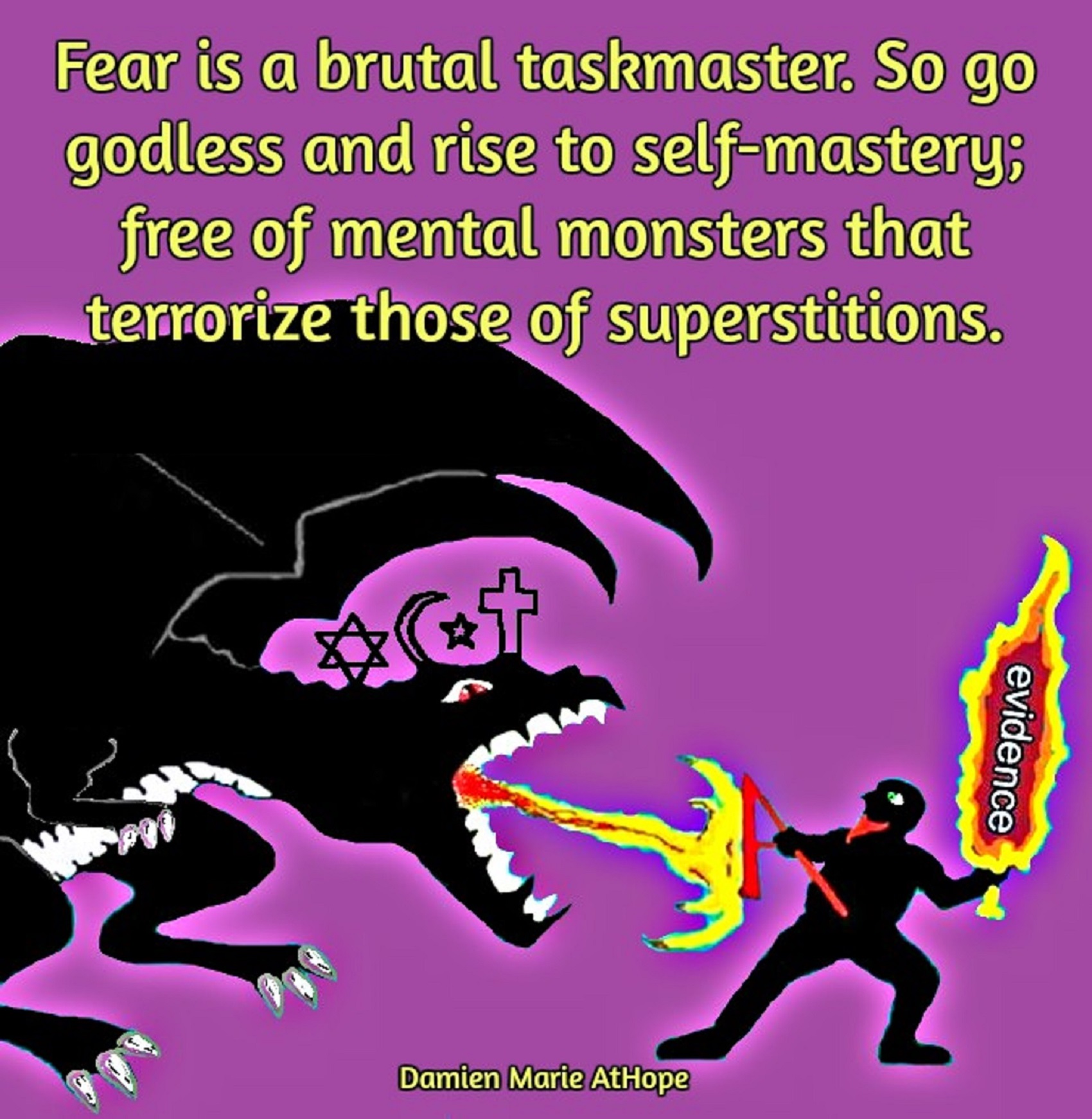
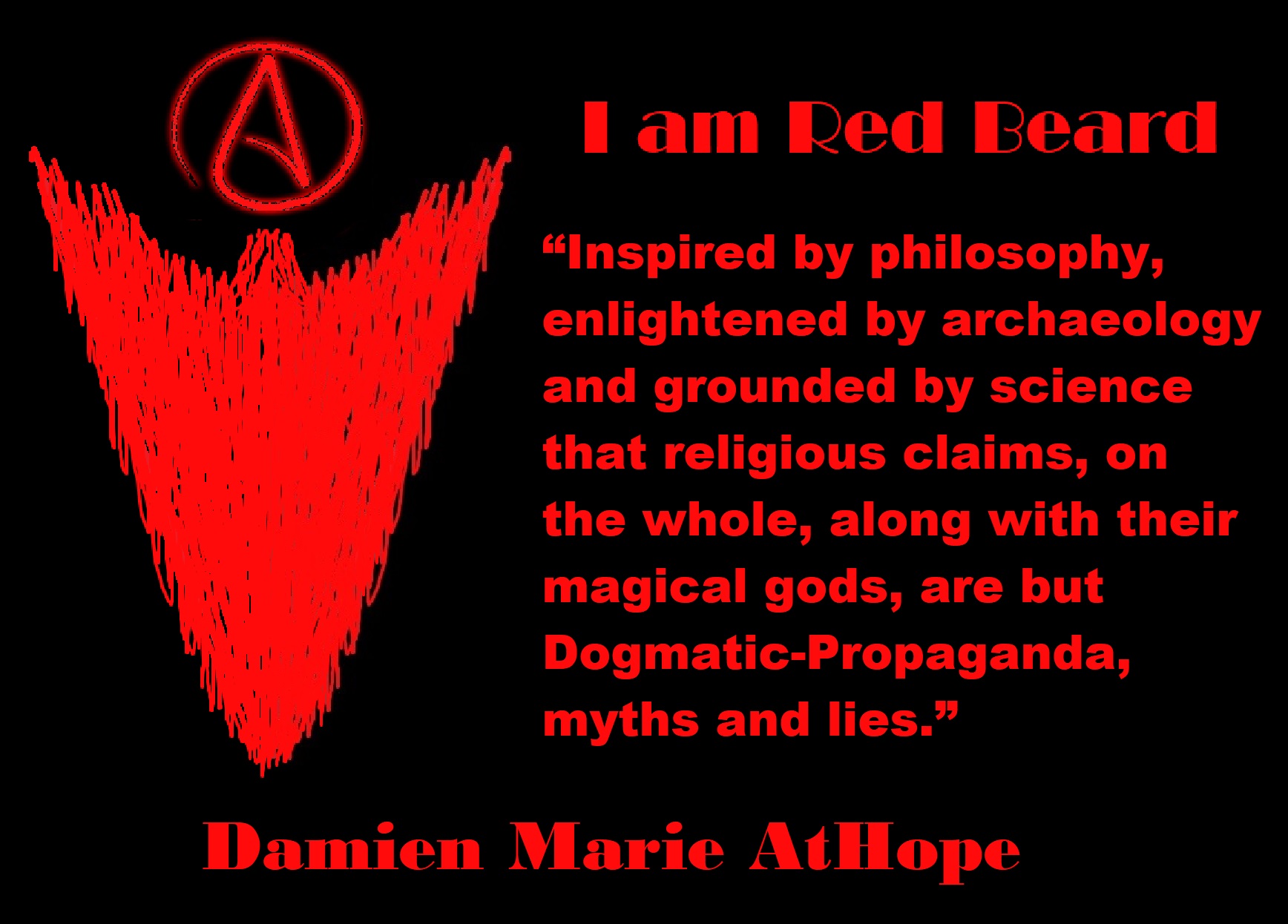
People don’t commonly teach religious history, even that of their own claimed religion. No, rather they teach a limited “pro their religion” history of their religion from a religious perspective favorable to the religion of choice.
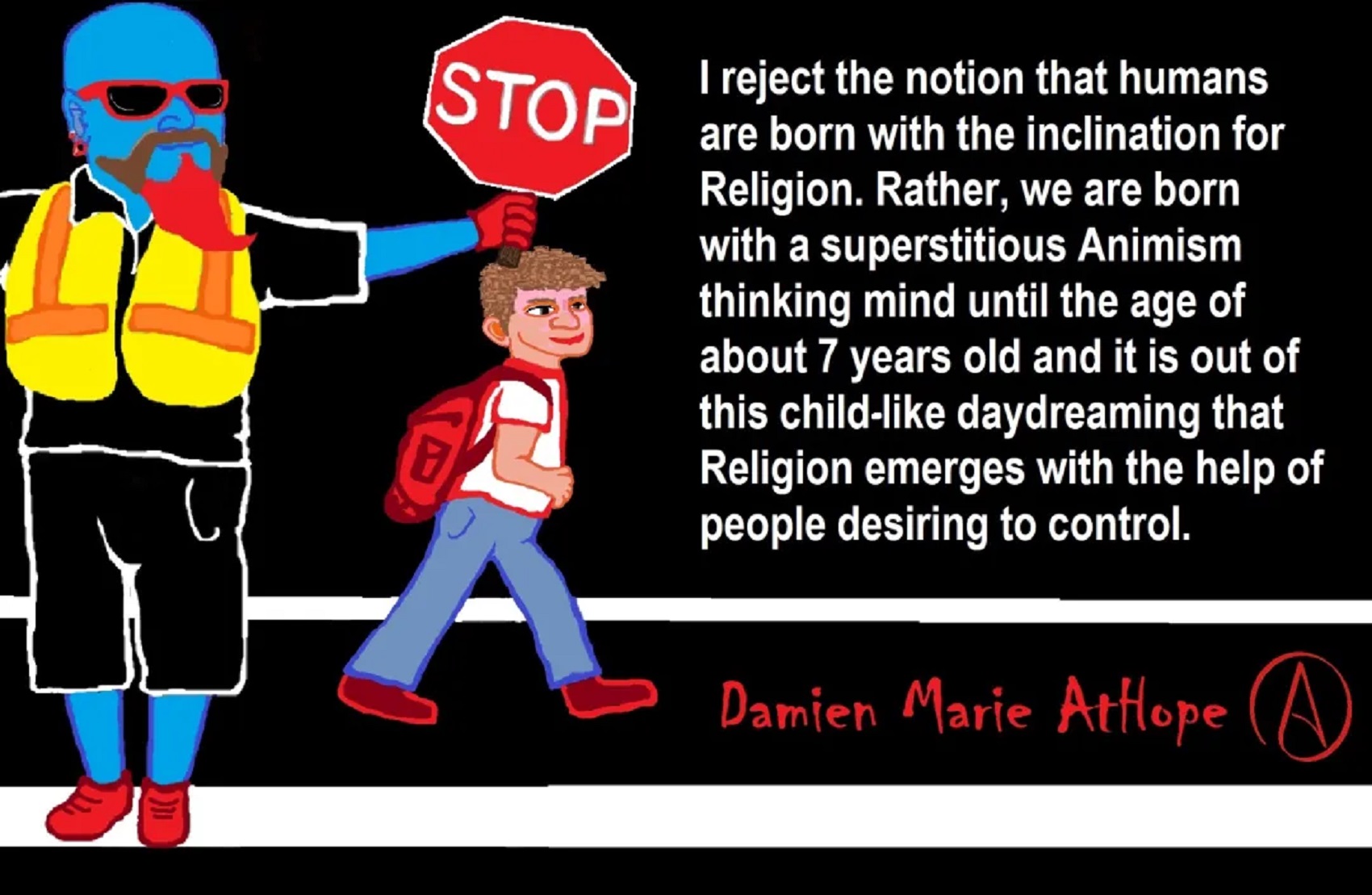
Do you truly think “Religious Belief” is only a matter of some personal choice?
Do you not see how coercive one’s world of choice is limited to the obvious hereditary belief, in most religious choices available to the child of religious parents or caregivers? Religion is more commonly like a family, culture, society, etc. available belief that limits the belief choices of the child and that is when “Religious Belief” is not only a matter of some personal choice and when it becomes hereditary faith, not because of the quality of its alleged facts or proposed truths but because everyone else important to the child believes similarly so they do as well simply mimicking authority beliefs handed to them. Because children are raised in religion rather than being presented all possible choices but rather one limited dogmatic brand of “Religious Belief” where children only have a choice of following the belief as instructed, and then personally claim the faith hereditary belief seen in the confirming to the belief they have held themselves all their lives. This is obvious in statements asked and answered by children claiming a faith they barely understand but they do understand that their family believes “this or that” faith, so they feel obligated to believe it too. While I do agree that “Religious Belief” should only be a matter of some personal choice, it rarely is… End Hereditary Religion!
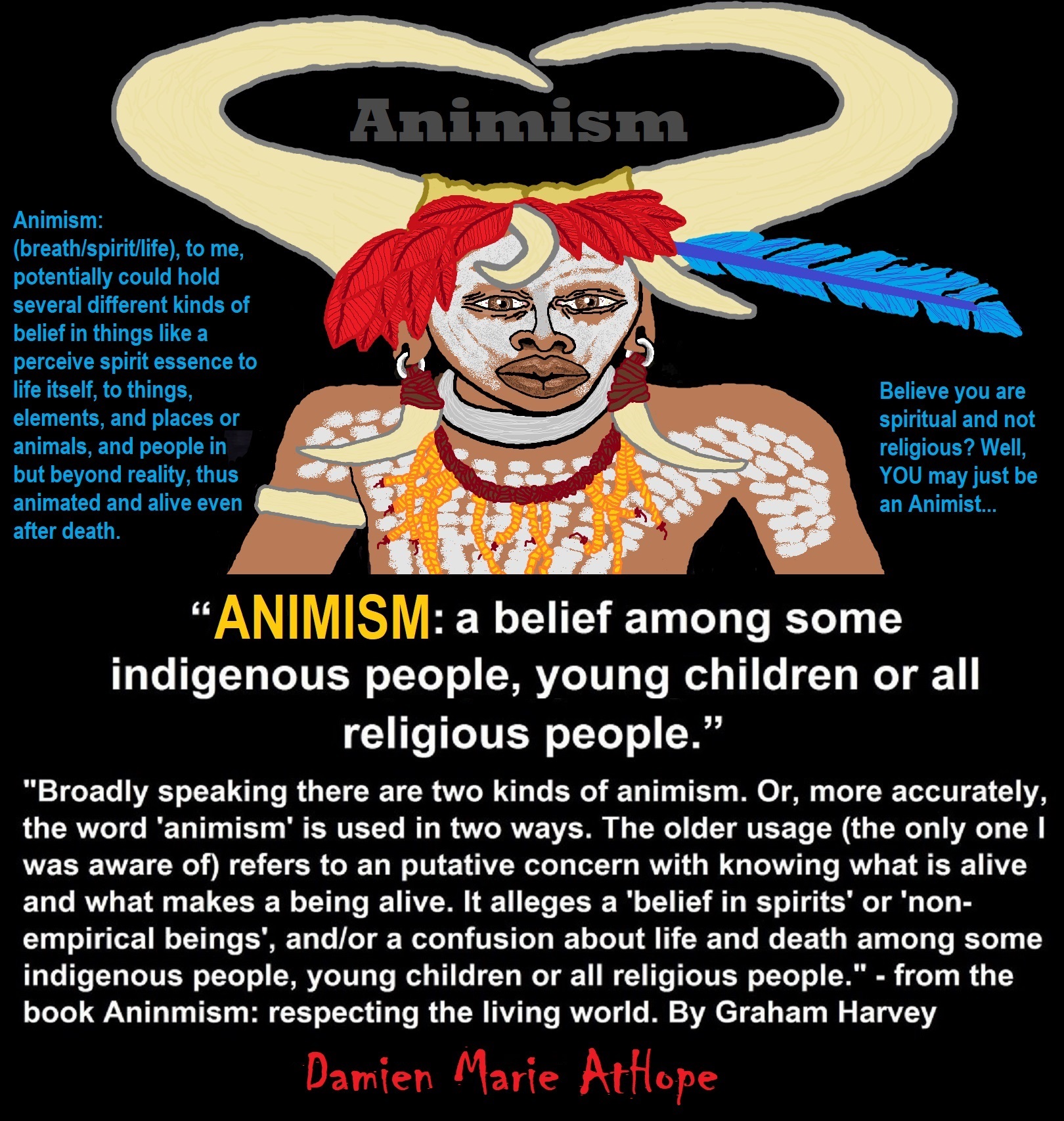
Animism: Respecting the Living World by Graham Harvey
“How have human cultures engaged with and thought about animals, plants, rocks, clouds, and other elements in their natural surroundings? Do animals and other natural objects have a spirit or soul? What is their relationship to humans? In this new study, Graham Harvey explores current and past animistic beliefs and practices of Native Americans, Maori, Aboriginal Australians, and eco-pagans. He considers the varieties of animism found in these cultures as well as their shared desire to live respectfully within larger natural communities. Drawing on his extensive casework, Harvey also considers the linguistic, performative, ecological, and activist implications of these different animisms.” ref
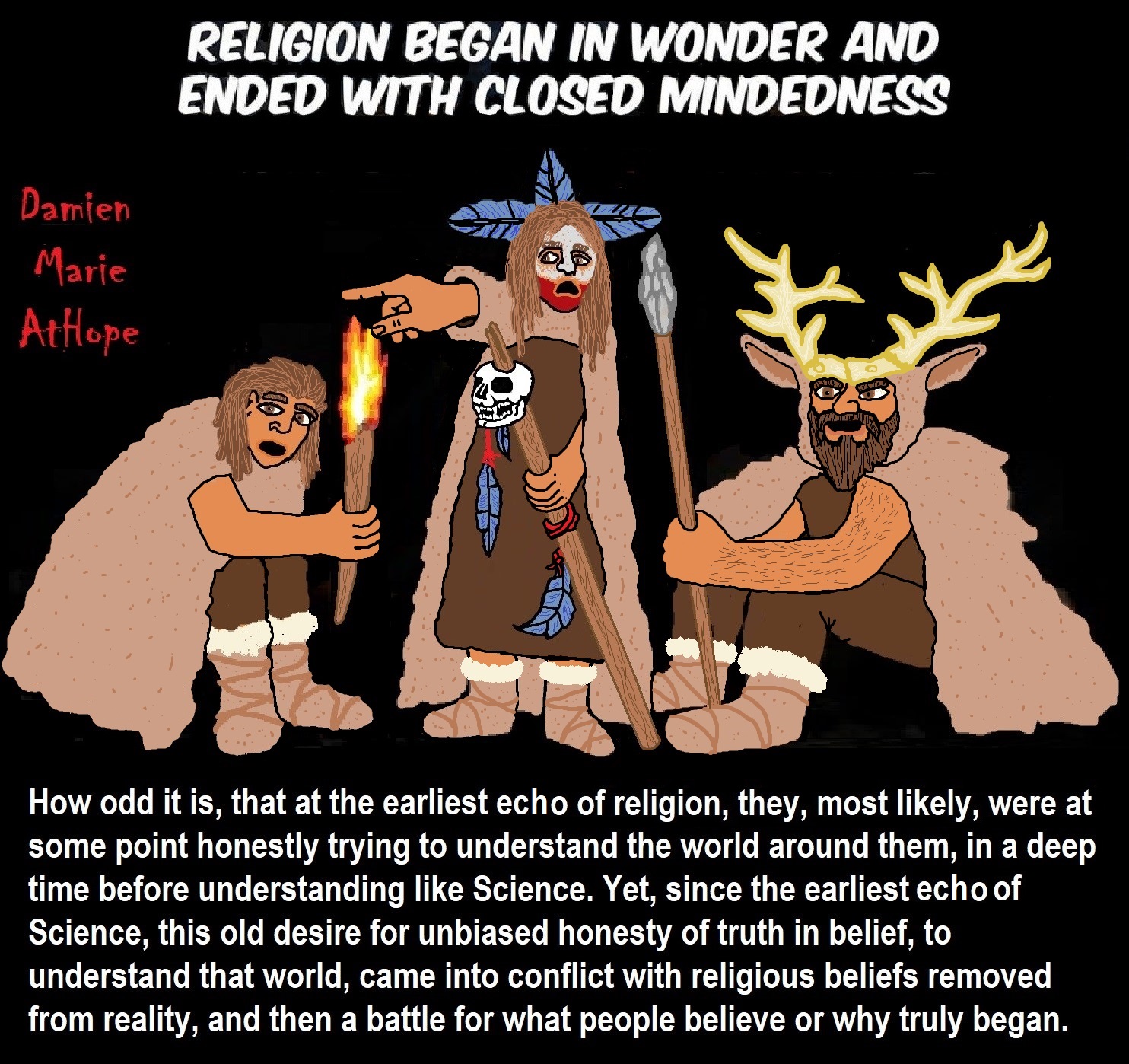
We are like believing machines we vacuum up ideas, like Velcro sticks to almost everything. We accumulate beliefs that we allow to negatively influence our lives, often without realizing it. Our willingness must be to alter skewed beliefs that impend our balance or reason, which allows us to achieve new positive thinking and accurate outcomes.

My thoughts on Religion Evolution with external links for more info:
- (Pre-Animism Africa mainly, but also Europe, and Asia at least 300,000 years ago), (Pre-Animism – Oxford Dictionaries)
- (Animism Africa around 100,000 years ago), (Animism – Britannica.com)
- (Totemism Europe around 50,000 years ago), (Totemism – Anthropology)
- (Shamanism Siberia around 30,000 years ago), (Shamanism – Britannica.com)
- (Paganism Turkey around 12,000 years ago), (Paganism – BBC Religion)
- (Progressed Organized Religion “Institutional Religion” Egypt around 5,000 years ago), (Ancient Egyptian Religion – Britannica.com)
- (CURRENT “World” RELIGIONS after 4,000 years ago) (Origin of Major Religions – Sacred Texts)
- (Early Atheistic Doubting at least by 2,600 years ago) (History of Atheism – Wikipedia)
“Religion is an Evolved Product” and Yes, Religion is Like Fear Given Wings…
Atheists talk about gods and religions for the same reason doctors talk about cancer, they are looking for a cure, or a firefighter talks about fires because they burn people and they care to stop them. We atheists too often feel a need to help the victims of mental slavery, held in the bondage that is the false beliefs of gods and the conspiracy theories of reality found in religions.
Understanding Religion Evolution:
- Pre-Animism (at least 300,000 years ago)
- Animism (Africa: 100,000 years ago)
- Totemism (Europe: 50,000 years ago)
- Shamanism (Siberia: 30,000 years ago)
- Paganism (Turkey: 12,000 years ago)
- Progressed organized religion (Egypt: 5,000 years ago), (Egypt, the First Dynasty 5,150 years ago)
- CURRENT “World” RELIGIONS (after 4,000 years ago)
- Early Atheistic Doubting (at least by 2,600 years ago)
“An Archaeological/Anthropological Understanding of Religion Evolution”
It seems ancient peoples had to survived amazing threats in a “dangerous universe (by superstition perceived as good and evil),” and human “immorality or imperfection of the soul” which was thought to affect the still living, leading to ancestor worship. This ancestor worship presumably led to the belief in supernatural beings, and then some of these were turned into the belief in gods. This feeble myth called gods were just a human conceived “made from nothing into something over and over, changing, again and again, taking on more as they evolve, all the while they are thought to be special,” but it is just supernatural animistic spirit-belief perceived as sacred.
Quick Evolution of Religion?
Pre-Animism (at least 300,000 years ago) pre-religion is a beginning that evolves into later Animism. So, Religion as we think of it, to me, all starts in a general way with Animism (Africa: 100,000 years ago) (theoretical belief in supernatural powers/spirits), then this is physically expressed in or with Totemism (Europe: 50,000 years ago) (theoretical belief in mythical relationship with powers/spirits through a totem item), which then enlists a full-time specific person to do this worship and believed interacting Shamanism (Siberia/Russia: 30,000 years ago) (theoretical belief in access and influence with spirits through ritual), and then there is the further employment of myths and gods added to all the above giving you Paganism (Turkey: 12,000 years ago) (often a lot more nature-based than most current top world religions, thus hinting to their close link to more ancient religious thinking it stems from). My hypothesis is expressed with an explanation of the building of a theatrical house (modern religions development). Progressed organized religion (Egypt: 5,000 years ago) with CURRENT “World” RELIGIONS (after 4,000 years ago).
Historically, in large city-state societies (such as Egypt or Iraq) starting around 5,000 years ago culminated to make religion something kind of new, a sociocultural-governmental-religious monarchy, where all or at least many of the people of such large city-state societies seem familiar with and committed to the existence of “religion” as the integrated life identity package of control dynamics with a fixed closed magical doctrine, but this juggernaut integrated religion identity package of Dogmatic-Propaganda certainly did not exist or if developed to an extent it was highly limited in most smaller prehistoric societies as they seem to lack most of the strong control dynamics with a fixed closed magical doctrine (magical beliefs could be at times be added or removed). Many people just want to see developed religious dynamics everywhere even if it is not. Instead, all that is found is largely fragments until the domestication of religion.
Religions, as we think of them today, are a new fad, even if they go back to around 6,000 years in the timeline of human existence, this amounts to almost nothing when seen in the long slow evolution of religion at least around 70,000 years ago with one of the oldest ritual worship. Stone Snake of South Africa: “first human worship” 70,000 years ago. This message of how religion and gods among them are clearly a man-made thing that was developed slowly as it was invented and then implemented peace by peace discrediting them all. Which seems to be a simple point some are just not grasping how devastating to any claims of truth when we can see the lie clearly in the archeological sites.
I wish people fought as hard for the actual values as they fight for the group/clan names political or otherwise they think support values. Every amount spent on war is theft to children in need of food or the homeless kept from shelter.
Here are several of my blog posts on history:
- To Find Truth You Must First Look
- (Magdalenian/Iberomaurusian) Connections to the First Paganists of the early Neolithic Near East Dating from around 17,000 to 12,000 Years Ago
- Natufians: an Ancient People at the Origins of Agriculture and Sedentary Life
- Possible Clan Leader/Special “MALE” Ancestor Totem Poles At Least 13,500 years ago?
- Jewish People with DNA at least 13,200 years old, Judaism, and the Origins of Some of its Ideas
- Baltic Reindeer Hunters: Swiderian, Lyngby, Ahrensburgian, and Krasnosillya cultures 12,020 to 11,020 years ago are evidence of powerful migratory waves during the last 13,000 years and a genetic link to Saami and the Finno-Ugric peoples.
- The Rise of Inequality: patriarchy and state hierarchy inequality
- Fertile Crescent 12,500 – 9,500 Years Ago: fertility and death cult belief system?
- 12,400 – 11,700 Years Ago – Kortik Tepe (Turkey) Pre/early-Agriculture Cultic Ritualism
- Ritualistic Bird Symbolism at Gobekli Tepe and its “Ancestor Cult”
- Male-Homosexual (female-like) / Trans-woman (female) Seated Figurine from Gobekli Tepe
- Could a 12,000-year-old Bull Geoglyph at Göbekli Tepe relate to older Bull and Female Art 25,000 years ago and Later Goddess and the Bull cults like Catal Huyuk?
- Sedentism and the Creation of goddesses around 12,000 years ago as well as male gods after 7,000 years ago.
- Alcohol, where Agriculture and Religion Become one? Such as Gobekli Tepe’s Ritualistic use of Grain as Food and Ritual Drink
- Neolithic Ritual Sites with T-Pillars and other Cultic Pillars
- Paganism: Goddesses around 12,000 years ago then Male Gods after 7,000 years ago
- First Patriarchy: Split of Women’s Status around 12,000 years ago & First Hierarchy: fall of Women’s Status around 5,000 years ago.
- Natufians: an Ancient People at the Origins of Agriculture and Sedentary Life
- J DNA and the Spread of Agricultural Religion (paganism)
- Paganism: an approximately 12,000-year-old belief system
- Paganism 12,000 years old: related to “Anarchism and Socialism” (Pre-Capitalism)
- Shaman burial in Israel 12,000 years ago and the Shamanism Phenomena
- Need to Mythicized: gods and goddesses
- 12,000 – 7,000 Years Ago – Paleo-Indian Culture (The Americas)
- 12,000 – 2,000 Years Ago – Indigenous-Scandinavians (Nordic)
- Norse did not wear helmets with horns?
- Pre-Pottery Neolithic Skull Cult around 11,500 to 8,400 Years Ago?
- 10,400 – 10,100 Years Ago, in Turkey the Nevail Cori Religious Settlement
- 9,000-6,500 Years Old Submerged Pre-Pottery/Pottery Neolithic Ritual Settlements off Israel’s Coast
- Catal Huyuk “first religious designed city” around 9,500 to 7,700 years ago (Turkey)
- Cultic Hunting at Catal Huyuk “first religious designed city”
- Special Items and Art as well as Special Elite Burials at Catal Huyuk
- New Rituals and Violence with the appearance of Pottery and People?
- Haplogroup N and its related Uralic Languages and Cultures
- Ainu people, Sámi people, Native Americans, the Ancient North Eurasians, and Paganistic-Shamanism with Totemism
- Ideas, Technology and People from Turkey, Europe, to China and Back again 9,000 to 5,000 years ago?
- First Pottery of Europe and the Related Cultures
- 9,000 years old Neolithic Artifacts Judean Desert and Hills Israel
- 9,000-7,000 years-old Sex and Death Rituals: Cult Sites in Israel, Jordan, and the Sinai
- 9,000-8500 year old Horned Female shaman Bad Dürrenberg Germany
- Neolithic Jewelry and the Spread of Farming in Europe Emerging out of West Turkey
- 8,600-year-old Tortoise Shells in Neolithic graves in central China have Early Writing and Shamanism
- Swing of the Mace: the rise of Elite, Forced Authority, and Inequality begin to Emerge 8,500 years ago?
- Migrations and Changing Europeans Beginning around 8,000 Years Ago
- My “Steppe-Anatolian-Kurgan hypothesis” 8,000/7,000 years ago
- Around 8,000-year-old Shared Idea of the Mistress of Animals, “Ritual” Motif
- Pre-Columbian Red-Paint (red ochre) Maritime Archaic Culture 8,000-3,000 years ago
- 7,522-6,522 years ago Linear Pottery culture which I think relates to Arcane Capitalism’s origins
- Arcane Capitalism: Primitive socialism, Primitive capital, Private ownership, Means of production, Market capitalism, Class discrimination, and Petite bourgeoisie (smaller capitalists)
- 7,500-4,750 years old Ritualistic Cucuteni-Trypillian culture of Moldova, Romania, and Ukraine
- Roots of a changing early society 7,200-6,700 years ago Jordan and Israel
- Agriculture religion (Paganism) with farming reached Britain between about 7,000 to 6,500 or so years ago and seemingly expressed in things like Western Europe’s Long Barrows
- My Thoughts on Possible Migrations of “R” DNA and Proto-Indo-European?
- “Millet” Spreading from China 7,022 years ago to Europe and related Language may have Spread with it leading to Proto-Indo-European
- Proto-Indo-European (PIE), ancestor of Indo-European languages: DNA, Society, Language, and Mythology
- The Dnieper–Donets culture and Asian varieties of Millet from China to the Black Sea region of Europe by 7,022 years ago
- Kurgan 6,000 years ago/dolmens 7,000 years ago: funeral, ritual, and other?
- 7,020 to 6,020-year-old Proto-Indo-European Homeland of Urheimat or proposed home of their Language and Religion
- Ancient Megaliths: Kurgan, Ziggurat, Pyramid, Menhir, Trilithon, Dolman, Kromlech, and Kromlech of Trilithons
- The Mytheme of Ancient North Eurasian Sacred-Dog belief and similar motifs are found in Indo-European, Native American, and Siberian comparative mythology
- Elite Power Accumulation: Ancient Trade, Tokens, Writing, Wealth, Merchants, and Priest-Kings
- Sacred Mounds, Mountains, Kurgans, and Pyramids may hold deep connections?
- Between 7,000-5,000 Years ago, rise of unequal hierarchy elite, leading to a “birth of the State” or worship of power, strong new sexism, oppression of non-elites, and the fall of Women’s equal status
- Paganism 7,000-5,000 years old: related to “Anarchism and Socialism” (Capitalism) (World War 0) Elite & their slaves
- Hell and Underworld mythologies starting maybe as far back as 7,000 to 5,000 years ago with the Proto-Indo-Europeans?
- The First Expression of the Male God around 7,000 years ago?
- White (light complexion skin) Bigotry and Sexism started 7,000 years ago?
- Around 7,000-year-old Shared Idea of the Divine Bird (Tutelary and/or Trickster spirit/deity), “Ritual” Motif
- Nekhbet an Ancient Egyptian Vulture Goddess and Tutelary Deity
- 6,720 to 4,920 years old Ritualistic Hongshan Culture of Inner Mongolia with 5,000-year-old Pyramid Mounds and Temples
- First proto-king in the Balkans, Varna culture around 6,500 years ago?
- 6,500–5,800 years ago in Israel Late Chalcolithic (Copper Age) Period in the Southern Levant Seems to Express Northern Levant Migrations, Cultural and Religious Transfer
- KING OF BEASTS: Master of Animals “Ritual” Motif, around 6,000 years old or older…
- Around 6000-year-old Shared Idea of the Solid Wheel & the Spoked Wheel-Shaped Ritual Motif
- “The Ghassulian Star,” a mysterious 6,000-year-old mural from Jordan; a Proto-Star of Ishtar, Star of Inanna or Star of Venus?
- Religious/Ritual Ideas, including goddesses and gods as well as ritual mounds or pyramids from Northeastern Asia at least 6,000 years old, seemingly filtering to Iran, Iraq, the Mediterranean, Europe, Egypt, and the Americas?
- Maykop (5,720–5,020 years ago) Caucasus region Bronze Age culture-related to Copper Age farmers from the south, influenced by the Ubaid period and Leyla-Tepe culture, as well as influencing the Kura-Araxes culture
- 5-600-year-old Tomb, Mummy, and First Bearded Male Figurine in a Grave
- Kura-Araxes Cultural 5,520 to 4,470 years old DNA traces to the Canaanites, Arabs, and Jews
- Minoan/Cretan (Keftiu) Civilization and Religion around 5,520 to 3,120 years ago
- Evolution Of Science at least by 5,500 years ago
- 5,500 Years old birth of the State, the rise of Hierarchy, and the fall of Women’s status
- “Jiroft culture” 5,100 – 4,200 years ago and the History of Iran
- Stonehenge: Paganistic Burial and Astrological Ritual Complex, England (5,100-3,600 years ago)
- Around 5,000-year-old Shared Idea of the “Tree of Life” Ritual Motif
- Complex rituals for elite, seen from China to Egypt, at least by 5,000 years ago
- Around 5,000 years ago: “Birth of the State” where Religion gets Military Power and Influence
- The Center of the World “Axis Mundi” and/or “Sacred Mountains” Mythology Could Relate to the Altai Mountains, Heart of the Steppe
- Progressed organized religion starts, an approximately 5,000-year-old belief system
- China’s Civilization between 5,000-3,000 years ago, was a time of war and class struggle, violent transition from free clans to a Slave or Elite society
- Origin of Logics is Naturalistic Observation at least by around 5,000 years ago.
- Paganism 5,000 years old: progressed organized religion and the state: related to “Anarchism and Socialism” (Kings and the Rise of the State)
- Ziggurats (multi-platform temples: 4,900 years old) to Pyramids (multi-platform tombs: 4,700 years old)
- Did a 4,520–4,420-year-old Volcano In Turkey Inspire the Bible God?
- Finland’s Horned Shaman and Pre-Horned-God at least 4,500 years ago?
- 4,000-year-Old Dolmens in Israel: A Connected Dolmen Religious Phenomenon?
- Creation myths: From chaos, Ex nihilo, Earth-diver, Emergence, World egg, and World parent
- Bronze Age “Ritual” connections of the Bell Beaker culture with the Corded Ware/Single Grave culture, which were related to the Yamnaya culture and Proto-Indo-European Languages/Religions
- Low Gods (Earth/ Tutelary deity), High Gods (Sky/Supreme deity), and Moralistic Gods (Deity enforcement/divine order)
- The exchange of people, ideas, and material-culture including, to me, the new god (Sky Father) and goddess (Earth Mother) religion between the Cucuteni-Trypillians and others which is then spread far and wide
- Koryaks: Indigenous People of the Russian Far East and Big Raven myths also found in Tlingit, Haida, Tsimshian, and other Indigenous People of North America
- 42 Principles Of Maat (Egyptian Goddess of the justice) around 4,400 years ago, 2000 Years Before Ten Commandments
- “Happy Easter” Well Happy Eostre/Ishter
- 4,320-3,820 years old “Shimao” (North China) site with Totemistic-Shamanistic Paganism and a Stepped Pyramid
- 4,250 to 3,400 Year old Stonehenge from Russia: Arkaim?
- 4,100-year-old beaker with medicinal & flowering plants in a grave of a woman in Scotland
- Early European Farmer ancestry, Kelif el Boroud people with the Cardial Ware culture, and the Bell Beaker culture Paganists too, spread into North Africa, then to the Canary Islands off West Africa
- Flood Accounts: Gilgamesh epic (4,100 years ago) Noah in Genesis (2,600 years ago)
- Paganism 4,000 years old: related to “Anarchism and Socialism” (First Moralistic gods, then the Origin time of Monotheism)
- When was the beginning: TIMELINE OF CURRENT RELIGIONS, which start around 4,000 years ago.
- Early Religions Thought to Express Proto-Monotheistic Systems around 4,000 years ago
- Kultepe? An archaeological site with a 4,000 years old women’s rights document.
- Single God Religions (Monotheism) = “Man-o-theism” started around 4,000 years ago with the Great Sky Spirit/God Tiān (天)?
- Confucianism’s Tiān (Shangdi god 4,000 years old): Supernaturalism, Pantheism or Theism?
- Yes, Your Male God is Ridiculous
- Mythology, a Lunar Deity is a Goddess or God of the Moon
- Sacred Land, Hills, and Mountains: Sami Mythology (Paganistic Shamanism)
- Horse Worship/Sacrifice: mythical union of Ruling Elite/Kingship and the Horse
- The Amorite/Amurru people’s God Amurru “Lord of the Steppe”, relates to the Origins of the Bible God?
- Bronze Age Exotic Trade Routes Spread Quite Far as well as Spread Religious Ideas with Them
- Sami and the Northern Indigenous Peoples Landscape, Language, and its Connection to Religion
- Prototype of Ancient Analemmatic Sundials around 3,900-3,150 years ago and a Possible Solar Connection to gods?
- Judaism is around 3,450 or 3,250 years old. (“Paleo-Hebrew” 3,000 years ago and Torah 2,500 years ago)
- The Weakening of Ancient Trade and the Strengthening of Religions around 3000 years ago?
- Are you aware that there are religions that worship women gods, explain now religion tears women down?
- Animistic, Totemistic, and Paganistic Superstition Origins of bible god and the bible’s Religion.
- Myths and Folklore: “Trickster gods and goddesses”
- Jews, Judaism, and the Origins of Some of its Ideas
- An Old Branch of Religion Still Giving Fruit: Sacred Trees
- Dating the BIBLE: naming names and telling times (written less than 3,000 years ago, provable to 2,200 years ago)
- Did a Volcano Inspire the bible god?
- Dené–Yeniseian language, Old Copper Complex, and Pre-Columbian Mound Builders?
- No “dinosaurs and humans didn’t exist together just because some think they are in the bible itself”
- Sacred Shit and Sacred Animals?
- Everyone Killed in the Bible Flood? “Nephilim” (giants)?
- Hey, Damien dude, I have a question for you regarding “the bible” Exodus.
- Archaeology Disproves the Bible
- Bible Battle, Just More, Bible Babble
- The Jericho Conquest lie?
- Canaanites and Israelites?
- Accurate Account on how did Christianity Began?
- Let’s talk about Christianity.
- So the 10 commandments isn’t anything to go by either right?
- Misinformed christian
- Debunking Jesus?
- Paulism vs Jesus
- Ok, you seem confused so let’s talk about Buddhism.
- Unacknowledged Buddhism: Gods, Savior, Demons, Rebirth, Heavens, Hells, and Terrorism
- His Foolishness The Dalai Lama
- Yin and Yang is sexist with an ORIGIN around 2,300 years ago?
- I Believe Archaeology, not Myths & Why Not, as the Religious Myths Already Violate Reason!
- Archaeological, Scientific, & Philosophic evidence shows the god myth is man-made nonsense.
- Aquatic Ape Theory/Hypothesis? As Always, Just Pseudoscience.
- Ancient Aliens Conspiracy Theorists are Pseudohistorians
- The Pseudohistoric and Pseudoscientific claims about “Bakoni Ruins” of South Africa
- Why do people think Religion is much more than supernaturalism and superstitionism?
- Religion is an Evolved Product
- Was the Value of Ancient Women Different?
- 1000 to 1100 CE, human sacrifice Cahokia Mounds a pre-Columbian Native American site
- Feminist atheists as far back as the 1800s?
- Promoting Religion as Real is Mentally Harmful to a Flourishing Humanity
- Screw All Religions and Their Toxic lies, they are all fraud
- Forget Religions’ Unfounded Myths, I Have Substantiated “Archaeology Facts.”
- Religion Dispersal throughout the World
- I Hate Religion Just as I Hate all Pseudoscience
- Exposing Scientology, Eckankar, Wicca and Other Nonsense?
- Main deity or religious belief systems
- Quit Trying to Invent Your God From the Scraps of Science.
- Archaeological, Scientific, & Philosophic evidence shows the god myth is man-made nonsense.
- Ancient Alien Conspiracy Theorists: Misunderstanding, Rhetoric, Misinformation, Fabrications, and Lies
- Misinformation, Distortion, and Pseudoscience in Talking with a Christian Creationist
- Judging the Lack of Goodness in Gods, Even the Norse God Odin
- Challenging the Belief in God-like Aliens and Gods in General
- A Challenge to Christian use of Torture Devices?
- Yes, Hinduism is a Religion
- Trump is One of the Most Reactionary Forces of Far-right Christian Extremism
- Was the Bull Head a Symbol of God? Yes!
- Primate Death Rituals
- Christian – “God and Christianity are objectively true”
- Australopithecus afarensis Death Ritual?
- You Claim Global Warming is a Hoax?
- Doubter of Science and Defamer of Atheists?
- I think that sounds like the Bible?
- History of the Antifa (“anti-fascist”) Movements
- Indianapolis Anti-Blasphemy Laws #Free Soheil Rally
- Damien, you repeat the golden rule in so many forms then you say religion is dogmatic?
- Science is a Trustable Methodology whereas Faith is not Trustable at all!
- Was I ever a believer, before I was an atheist?
- Atheists rise in reason
- Mistrust of science?
- Open to Talking About the Definition of ‘God’? But first, we address Faith.
- ‘United Monarchy’ full of splendor and power – Saul, David, and Solomon? Most likely not.
- Is there EXODUS ARCHAEOLOGY? The short answer is “no.”
- Lacking Proof of Bigfoots, Unicorns, and Gods is Just a Lack of Research?
- Religion and Politics: Faith Beliefs vs. Rational Thinking
- Hammer of Truth that lying pig RELIGION: challenged by an archaeologist
- “The Hammer of Truth” -ontology question- What do You Mean by That?
- Navigation of a bad argument: Ad Hominem vs. Attack
- Why is it Often Claimed that Gods have a Gender?
- Why are basically all monotheistic religions ones that have a male god?
- Shifting through the Claims in support of Faith
- Dear Mr. AtHope, The 20th Century is an Indictment of Secularism and a Failed Atheist Century
- An Understanding of the Worldwide Statistics and Dynamics of Terrorist Incidents and Suicide Attacks
- Intoxication and Evolution? Addressing and Assessing the “Stoned Ape” or “Drunken Monkey” Theories as Catalysts in Human Evolution
- Sacred Menstrual cloth? Inanna’s knot, Isis knot, and maybe Ma’at’s feather?
- Damien, why don’t the Hebrews accept the bible stories?
- Dealing with a Troll and Arguing Over Word Meaning
- Knowledge without Belief? Justified beliefs or disbeliefs worthy of Knowledge?
- Afrocentrism and African Religions
- Crecganford @crecganford offers history & stories of the people, places, gods, & culture
- Empiricism-Denier?
I am not an academic. I am a revolutionary that teaches in public, in places like social media, and in the streets. I am not a leader by some title given but from my commanding leadership style of simply to start teaching everywhere to everyone, all manner of positive education.
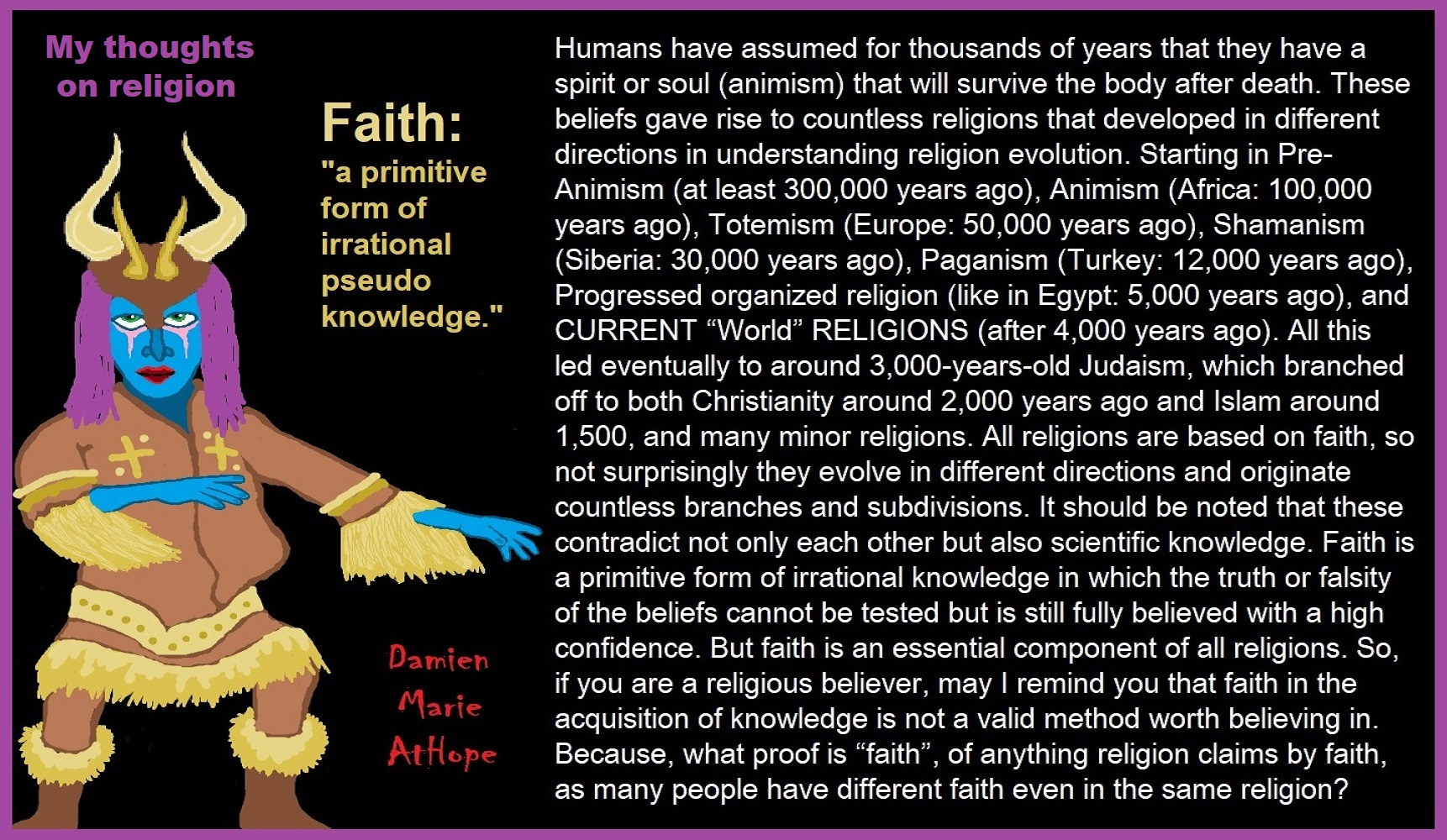
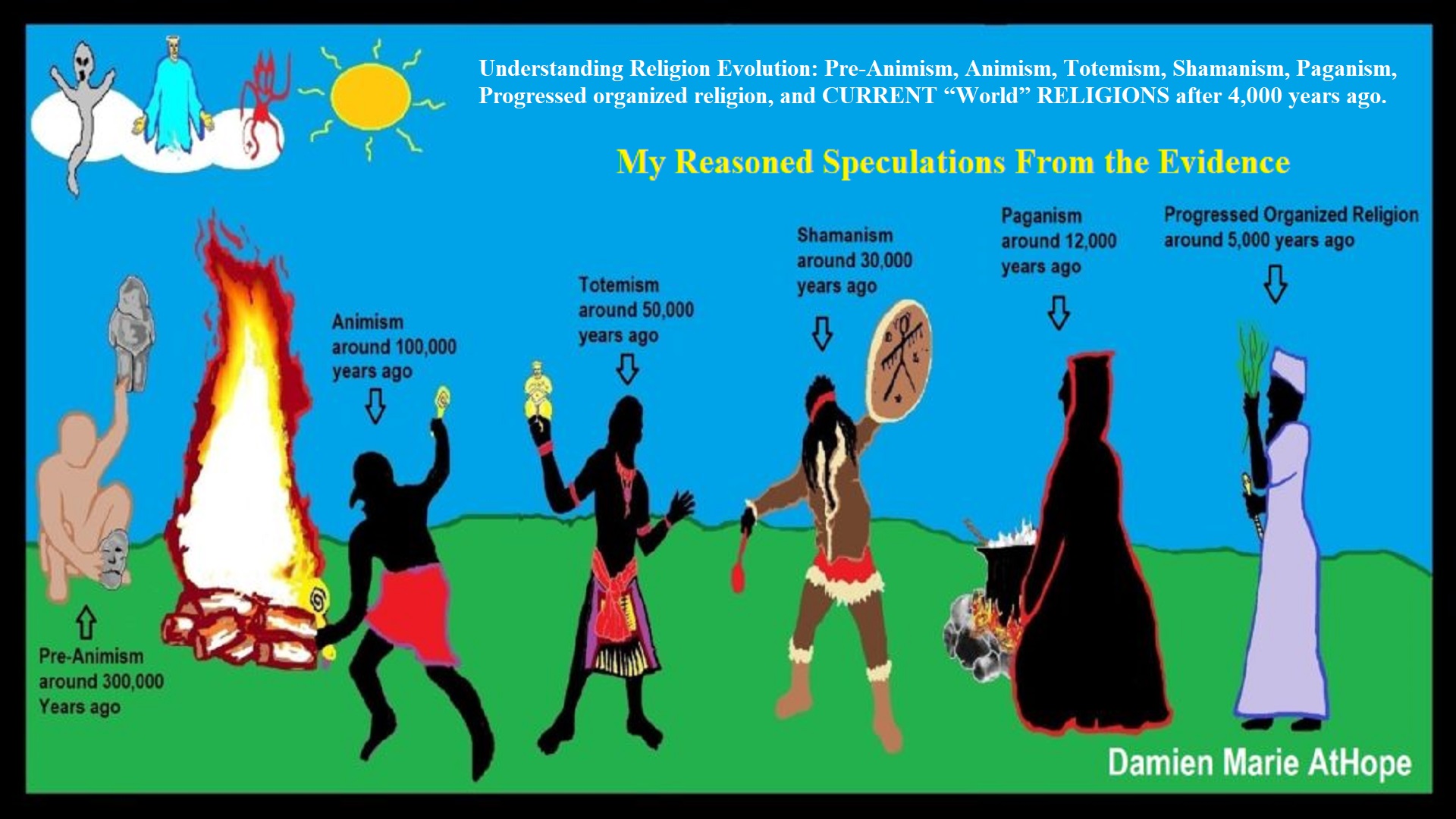
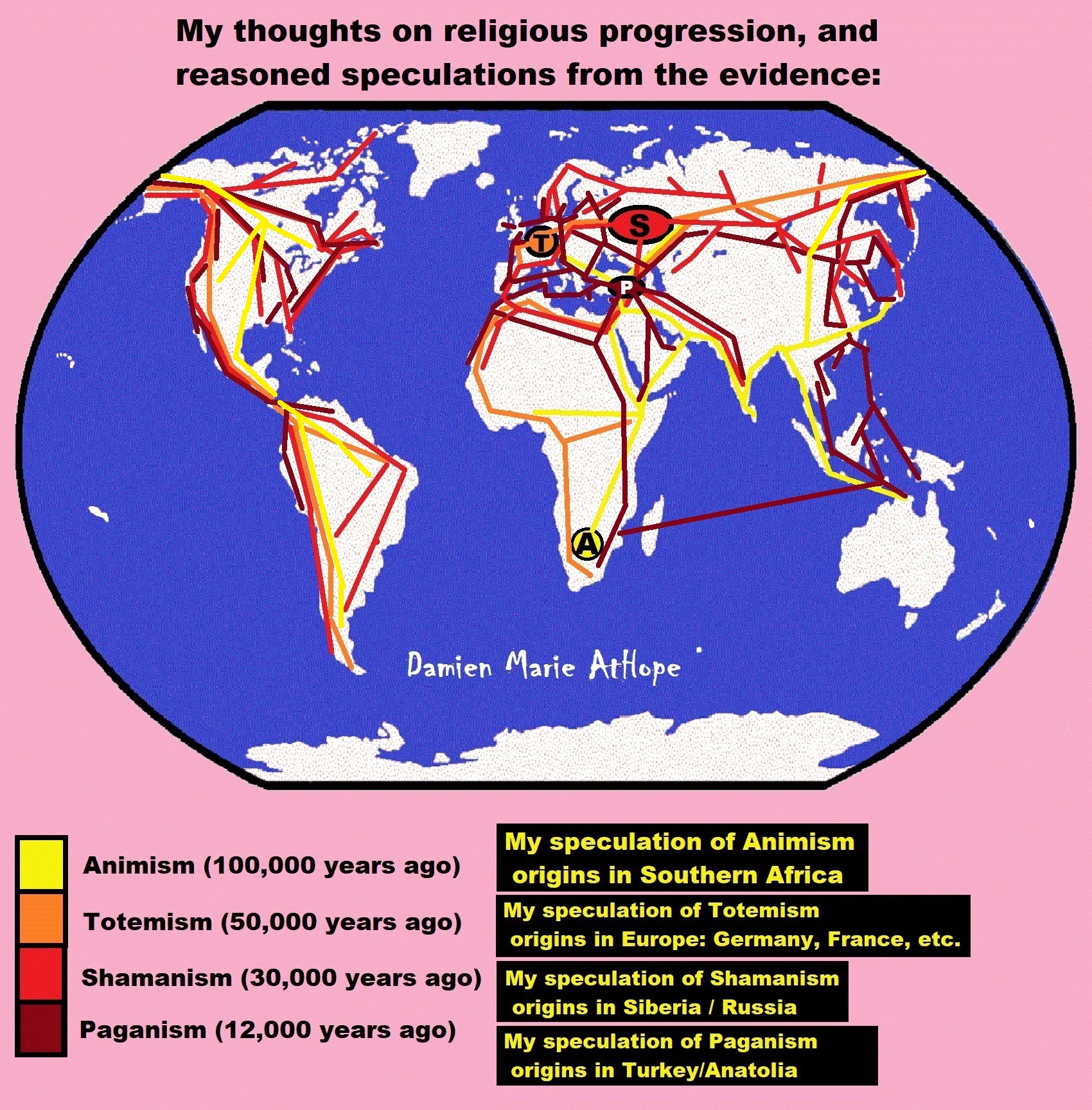
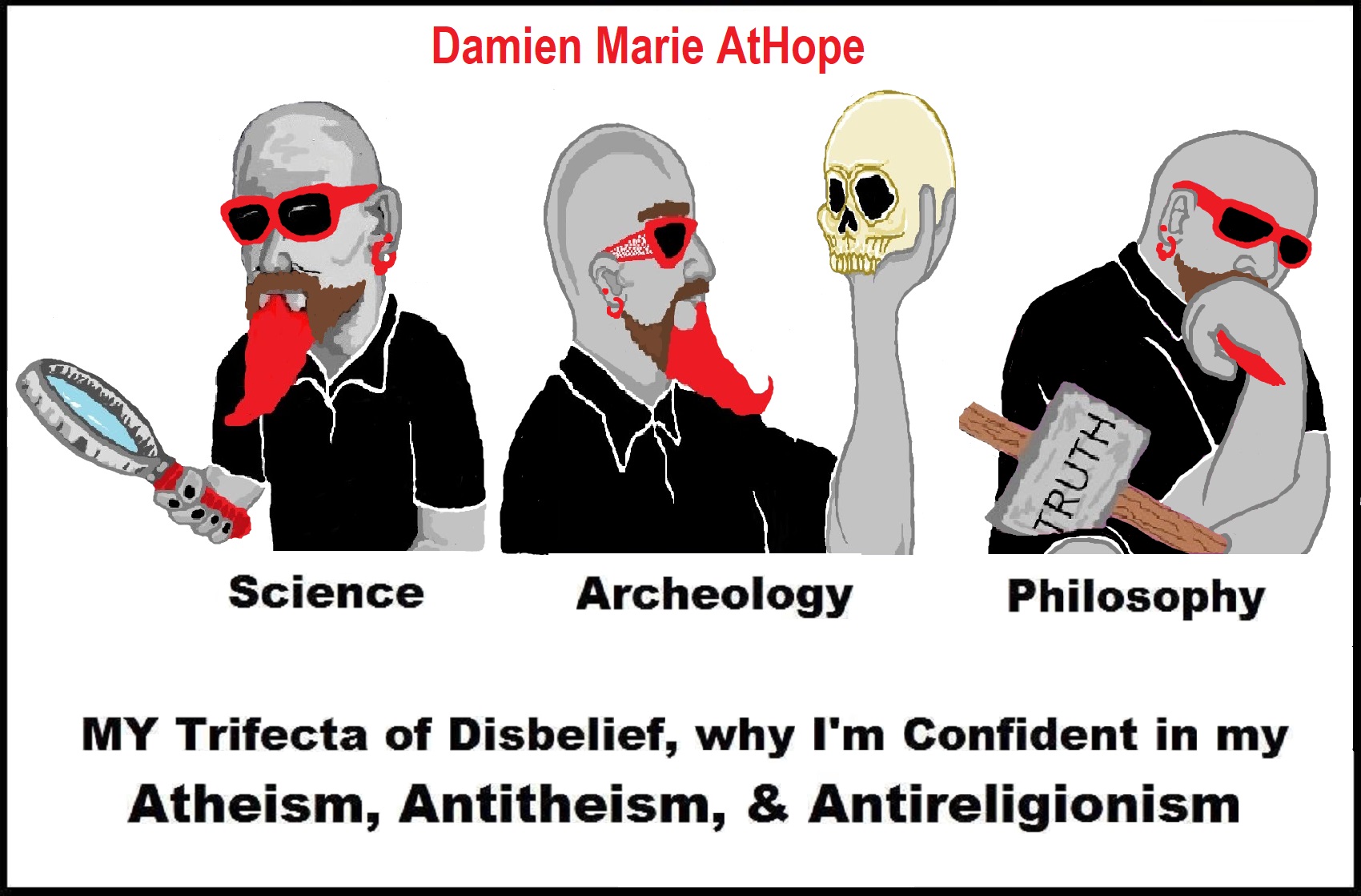
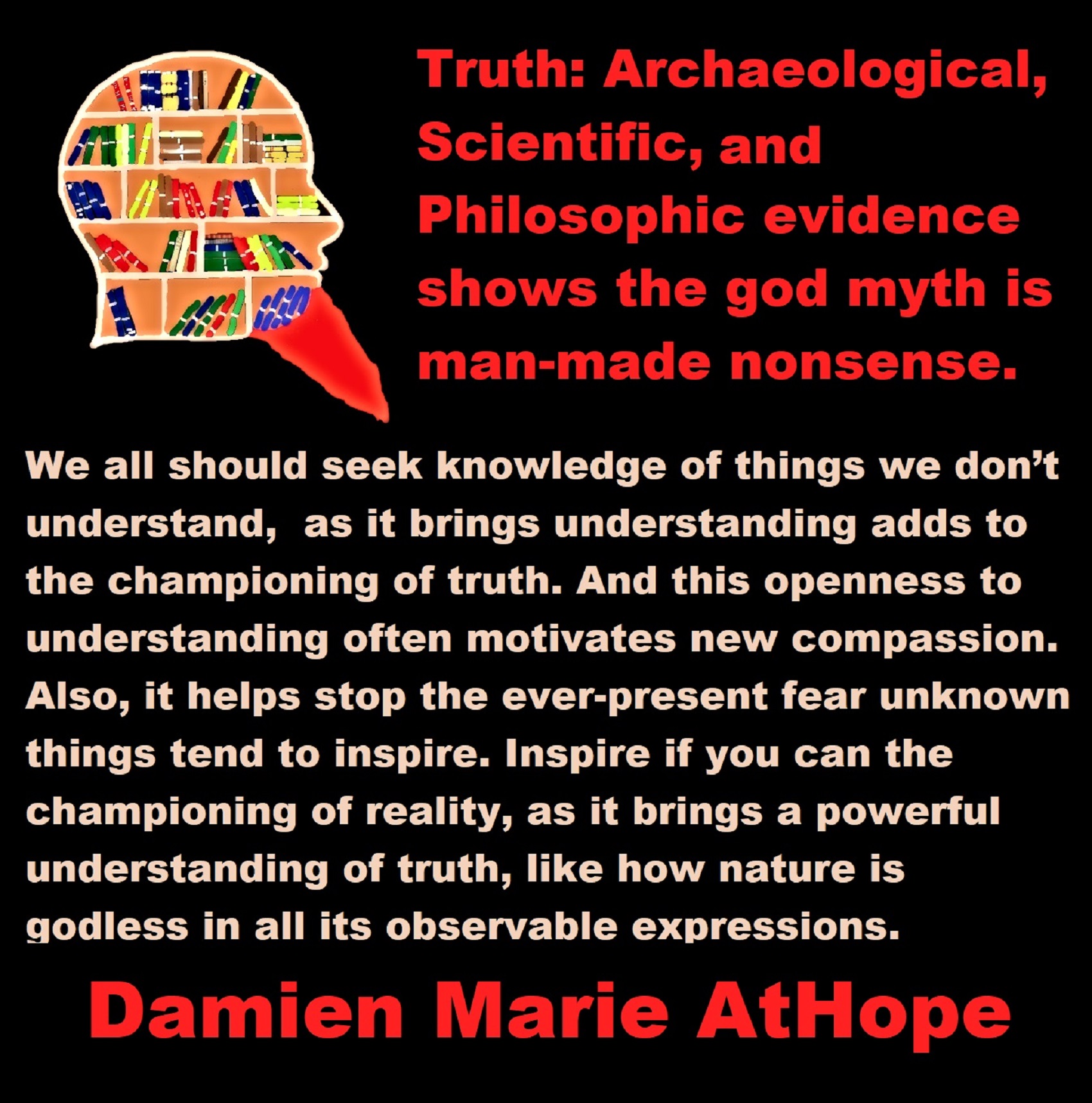
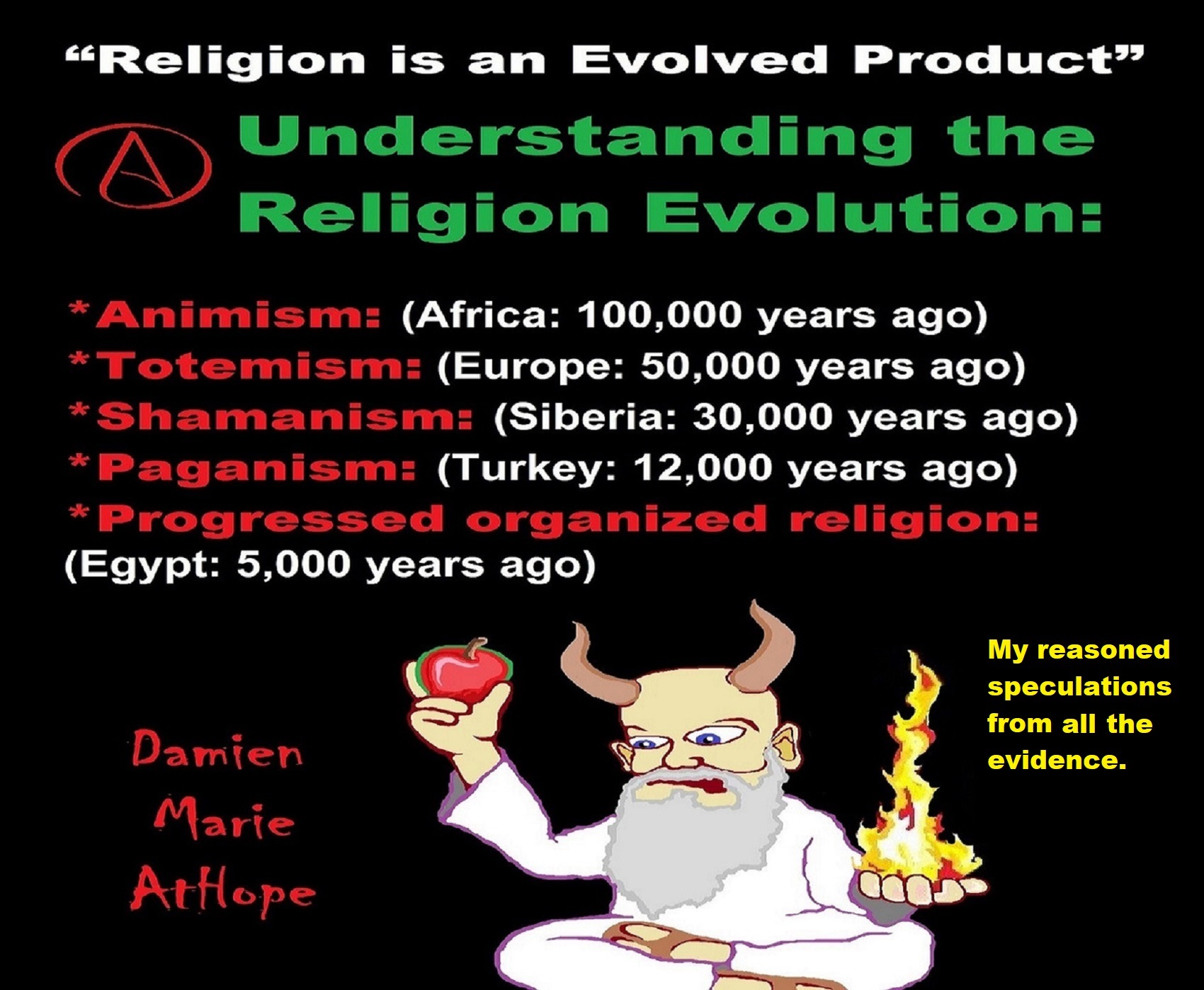
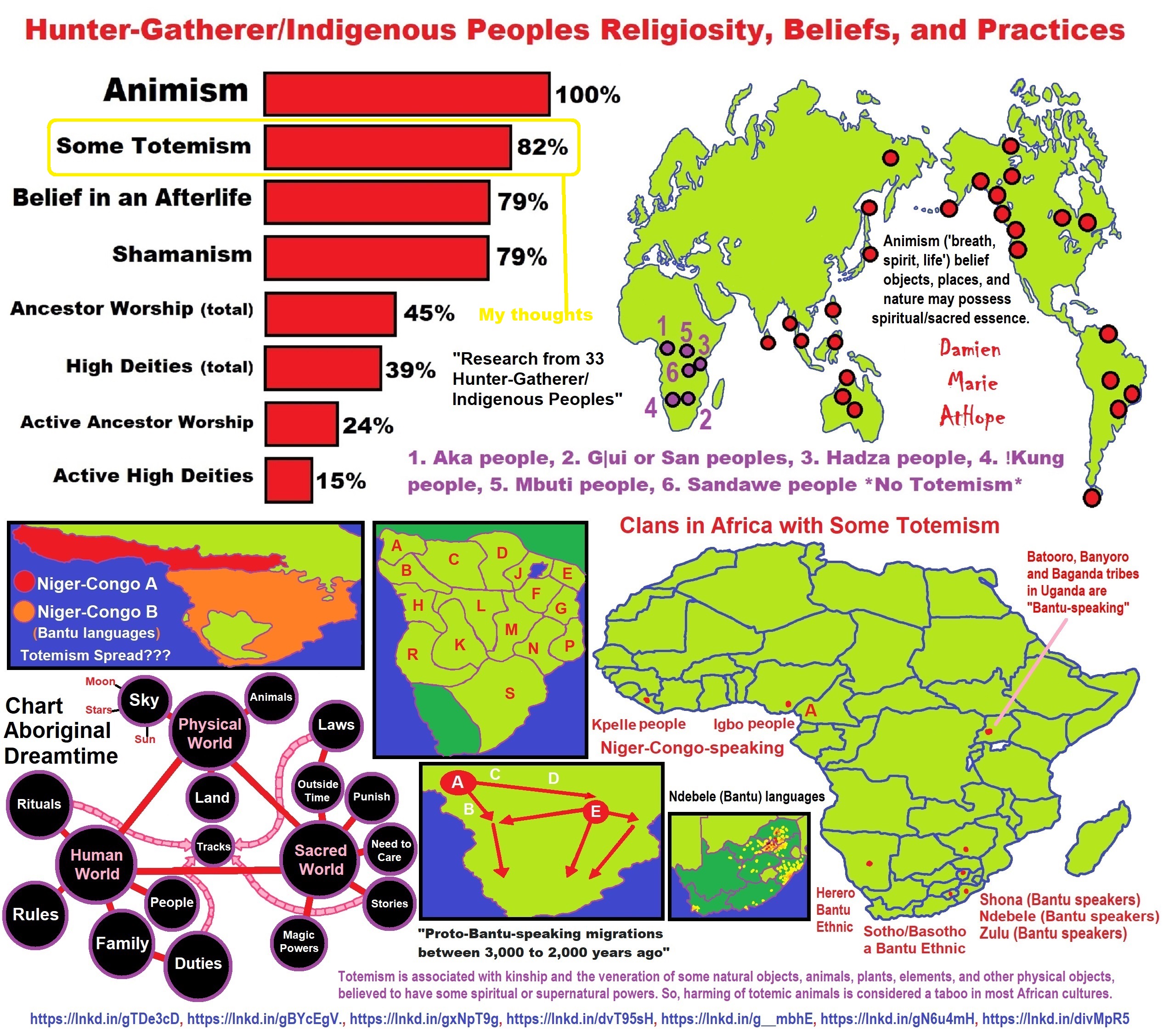
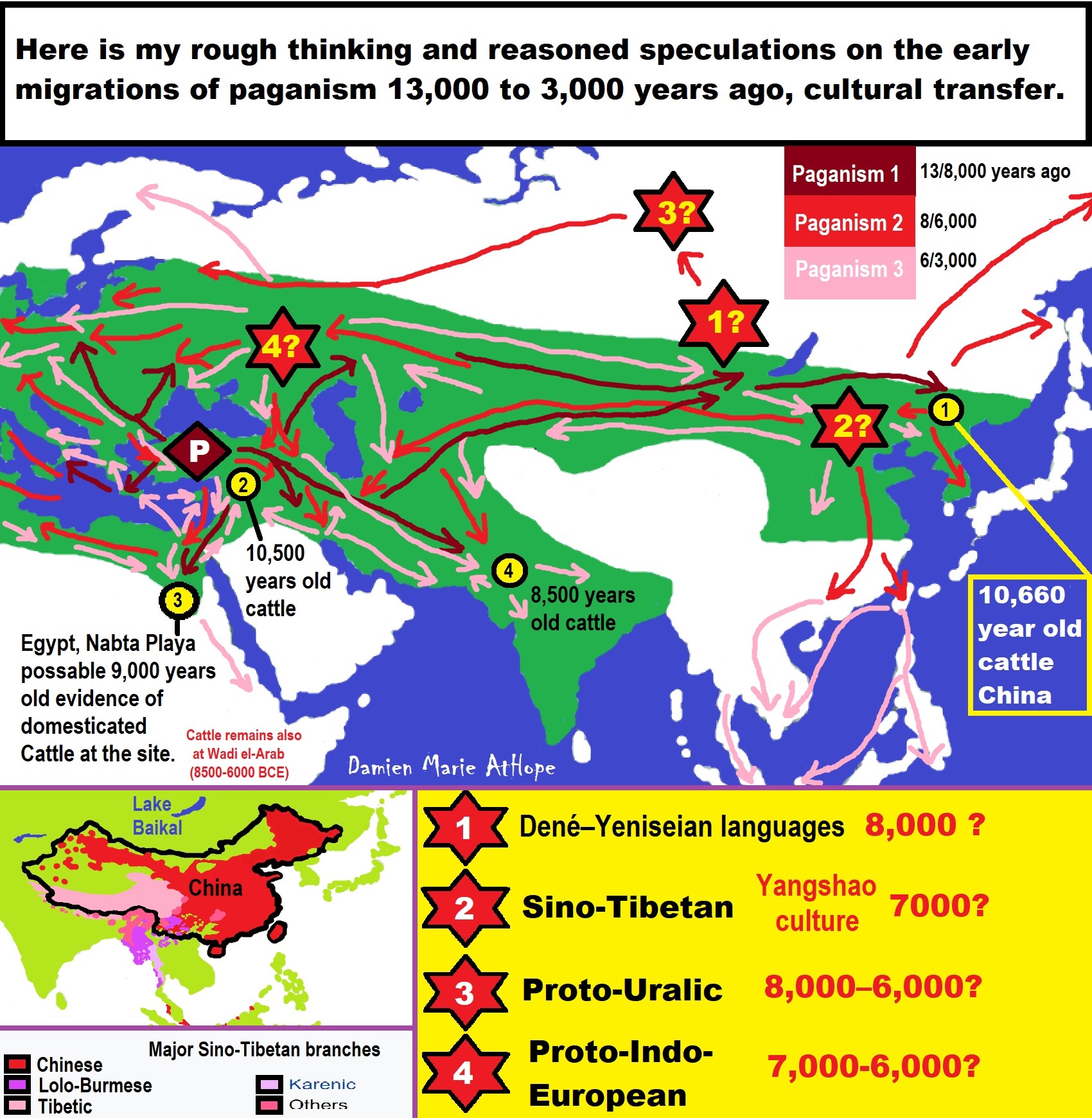

ref, ref, ref, ref, ref, ref, ref, ref, ref, ref, ref, ref, ref, ref, ref, ref, ref, ref, ref, ref, ref
Low Gods “Earth” or Tutelary deity and High Gods “Sky” or Supreme deity
“An Earth goddess is a deification of the Earth. Earth goddesses are often associated with the “chthonic” deities of the underworld. Ki and Ninhursag are Mesopotamian earth goddesses. In Greek mythology, the Earth is personified as Gaia, corresponding to Roman Terra, Indic Prithvi/Bhūmi, etc. traced to an “Earth Mother” complementary to the “Sky Father” in Proto-Indo-European religion. Egyptian mythology exceptionally has a sky goddess and an Earth god.” ref
“A mother goddess is a goddess who represents or is a personification of nature, motherhood, fertility, creation, destruction or who embodies the bounty of the Earth. When equated with the Earth or the natural world, such goddesses are sometimes referred to as Mother Earth or as the Earth Mother. In some religious traditions or movements, Heavenly Mother (also referred to as Mother in Heaven or Sky Mother) is the wife or feminine counterpart of the Sky father or God the Father.” ref
“Any masculine sky god is often also king of the gods, taking the position of patriarch within a pantheon. Such king gods are collectively categorized as “sky father” deities, with a polarity between sky and earth often being expressed by pairing a “sky father” god with an “earth mother” goddess (pairings of a sky mother with an earth father are less frequent). A main sky goddess is often the queen of the gods and may be an air/sky goddess in her own right, though she usually has other functions as well with “sky” not being her main. In antiquity, several sky goddesses in ancient Egypt, Mesopotamia, and the Near East were called Queen of Heaven. Neopagans often apply it with impunity to sky goddesses from other regions who were never associated with the term historically. The sky often has important religious significance. Many religions, both polytheistic and monotheistic, have deities associated with the sky.” ref
“In comparative mythology, sky father is a term for a recurring concept in polytheistic religions of a sky god who is addressed as a “father”, often the father of a pantheon and is often either a reigning or former King of the Gods. The concept of “sky father” may also be taken to include Sun gods with similar characteristics, such as Ra. The concept is complementary to an “earth mother“. “Sky Father” is a direct translation of the Vedic Dyaus Pita, etymologically descended from the same Proto-Indo-European deity name as the Greek Zeûs Pater and Roman Jupiter and Germanic Týr, Tir or Tiwaz, all of which are reflexes of the same Proto-Indo-European deity’s name, *Dyēus Ph₂tḗr. While there are numerous parallels adduced from outside of Indo-European mythology, there are exceptions (e.g. In Egyptian mythology, Nut is the sky mother and Geb is the earth father).” ref
Tutelary deity
“A tutelary (also tutelar) is a deity or spirit who is a guardian, patron, or protector of a particular place, geographic feature, person, lineage, nation, culture, or occupation. The etymology of “tutelary” expresses the concept of safety and thus of guardianship. In late Greek and Roman religion, one type of tutelary deity, the genius, functions as the personal deity or daimon of an individual from birth to death. Another form of personal tutelary spirit is the familiar spirit of European folklore.” ref
“A tutelary (also tutelar) in Korean shamanism, jangseung and sotdae were placed at the edge of villages to frighten off demons. They were also worshiped as deities. Seonangshin is the patron deity of the village in Korean tradition and was believed to embody the Seonangdang. In Philippine animism, Diwata or Lambana are deities or spirits that inhabit sacred places like mountains and mounds and serve as guardians. Such as: Maria Makiling is the deity who guards Mt. Makiling and Maria Cacao and Maria Sinukuan. In Shinto, the spirits, or kami, which give life to human bodies come from nature and return to it after death. Ancestors are therefore themselves tutelaries to be worshiped. And similarly, Native American beliefs such as Tonás, tutelary animal spirit among the Zapotec and Totems, familial or clan spirits among the Ojibwe, can be animals.” ref
“A tutelary (also tutelar) in Austronesian beliefs such as: Atua (gods and spirits of the Polynesian peoples such as the Māori or the Hawaiians), Hanitu (Bunun of Taiwan‘s term for spirit), Hyang (Kawi, Sundanese, Javanese, and Balinese Supreme Being, in ancient Java and Bali mythology and this spiritual entity, can be either divine or ancestral), Kaitiaki (New Zealand Māori term used for the concept of guardianship, for the sky, the sea, and the land), Kawas (mythology) (divided into 6 groups: gods, ancestors, souls of the living, spirits of living things, spirits of lifeless objects, and ghosts), Tiki (Māori mythology, Tiki is the first man created by either Tūmatauenga or Tāne and represents deified ancestors found in most Polynesian cultures). ” ref, ref, ref, ref, ref, ref, ref
Mesopotamian Tutelary Deities can be seen as ones related to City-States
“Historical city-states included Sumerian cities such as Uruk and Ur; Ancient Egyptian city-states, such as Thebes and Memphis; the Phoenician cities (such as Tyre and Sidon); the five Philistine city-states; the Berber city-states of the Garamantes; the city-states of ancient Greece (the poleis such as Athens, Sparta, Thebes, and Corinth); the Roman Republic (which grew from a city-state into a vast empire); the Italian city-states from the Middle Ages to the early modern period, such as Florence, Siena, Ferrara, Milan (which as they grew in power began to dominate neighboring cities) and Genoa and Venice, which became powerful thalassocracies; the Mayan and other cultures of pre-Columbian Mesoamerica (including cities such as Chichen Itza, Tikal, Copán and Monte Albán); the central Asian cities along the Silk Road; the city-states of the Swahili coast; Ragusa; states of the medieval Russian lands such as Novgorod and Pskov; and many others.” ref
“The Uruk period (ca. 4000 to 3100 BCE; also known as Protoliterate period) of Mesopotamia, named after the Sumerian city of Uruk, this period saw the emergence of urban life in Mesopotamia and the Sumerian civilization. City-States like Uruk and others had a patron tutelary City Deity along with a Priest-King.” ref
“Chinese folk religion, both past, and present, includes myriad tutelary deities. Exceptional individuals, highly cultivated sages, and prominent ancestors can be deified and honored after death. Lord Guan is the patron of military personnel and police, while Mazu is the patron of fishermen and sailors. Such as Tu Di Gong (Earth Deity) is the tutelary deity of a locality, and each individual locality has its own Earth Deity and Cheng Huang Gong (City God) is the guardian deity of an individual city, worshipped by local officials and locals since imperial times.” ref
“A tutelary (also tutelar) in Hinduism, personal tutelary deities are known as ishta-devata, while family tutelary deities are known as Kuladevata. Gramadevata are guardian deities of villages. Devas can also be seen as tutelary. Shiva is the patron of yogis and renunciants. City goddesses include: Mumbadevi (Mumbai), Sachchika (Osian); Kuladevis include: Ambika (Porwad), and Mahalakshmi. In NorthEast India Meitei mythology and religion (Sanamahism) of Manipur, there are various types of tutelary deities, among which Lam Lais are the most predominant ones. Tibetan Buddhism has Yidam as a tutelary deity. Dakini is the patron of those who seek knowledge.” ref
“A tutelary (also tutelar) The Greeks also thought deities guarded specific places: for instance, Athena was the patron goddess of the city of Athens. Socrates spoke of hearing the voice of his personal spirit or daimonion:
You have often heard me speak of an oracle or sign which comes to me … . This sign I have had ever since I was a child. The sign is a voice which comes to me and always forbids me to do something which I am going to do, but never commands me to do anything, and this is what stands in the way of my being a politician.” ref
“Tutelary deities who guard and preserve a place or a person are fundamental to ancient Roman religion. The tutelary deity of a man was his Genius, that of a woman her Juno. In the Imperial era, the Genius of the Emperor was a focus of Imperial cult. An emperor might also adopt a major deity as his personal patron or tutelary, as Augustus did Apollo. Precedents for claiming the personal protection of a deity were established in the Republican era, when for instance the Roman dictator Sulla advertised the goddess Victory as his tutelary by holding public games (ludi) in her honor.” ref
“Each town or city had one or more tutelary deities, whose protection was considered particularly vital in time of war and siege. Rome itself was protected by a goddess whose name was to be kept ritually secret on pain of death (for a supposed case, see Quintus Valerius Soranus). The Capitoline Triad of Juno, Jupiter, and Minerva were also tutelaries of Rome. The Italic towns had their own tutelary deities. Juno often had this function, as at the Latin town of Lanuvium and the Etruscan city of Veii, and was often housed in an especially grand temple on the arx (citadel) or other prominent or central location. The tutelary deity of Praeneste was Fortuna, whose oracle was renowned.” ref
“The Roman ritual of evocatio was premised on the belief that a town could be made vulnerable to military defeat if the power of its tutelary deity were diverted outside the city, perhaps by the offer of superior cult at Rome. The depiction of some goddesses such as the Magna Mater (Great Mother, or Cybele) as “tower-crowned” represents their capacity to preserve the city. A town in the provinces might adopt a deity from within the Roman religious sphere to serve as its guardian, or syncretize its own tutelary with such; for instance, a community within the civitas of the Remi in Gaul adopted Apollo as its tutelary, and at the capital of the Remi (present-day Rheims), the tutelary was Mars Camulus.” ref
Household deity (a kind of or related to a Tutelary deity)
“A household deity is a deity or spirit that protects the home, looking after the entire household or certain key members. It has been a common belief in paganism as well as in folklore across many parts of the world. Household deities fit into two types; firstly, a specific deity – typically a goddess – often referred to as a hearth goddess or domestic goddess who is associated with the home and hearth, such as the ancient Greek Hestia.” ref
“The second type of household deities are those that are not one singular deity, but a type, or species of animistic deity, who usually have lesser powers than major deities. This type was common in the religions of antiquity, such as the Lares of ancient Roman religion, the Gashin of Korean shamanism, and Cofgodas of Anglo-Saxon paganism. These survived Christianisation as fairy-like creatures existing in folklore, such as the Anglo-Scottish Brownie and Slavic Domovoy.” ref
“Household deities were usually worshipped not in temples but in the home, where they would be represented by small idols (such as the teraphim of the Bible, often translated as “household gods” in Genesis 31:19 for example), amulets, paintings, or reliefs. They could also be found on domestic objects, such as cosmetic articles in the case of Tawaret. The more prosperous houses might have a small shrine to the household god(s); the lararium served this purpose in the case of the Romans. The gods would be treated as members of the family and invited to join in meals, or be given offerings of food and drink.” ref
“In many religions, both ancient and modern, a god would preside over the home. Certain species, or types, of household deities, existed. An example of this was the Roman Lares. Many European cultures retained house spirits into the modern period. Some examples of these include:
- Brownie (Scotland and England) or Hob (England) / Kobold (Germany) / Goblin / Hobgoblin
- Domovoy (Slavic)
- Nisse (Norwegian or Danish) / Tomte (Swedish) / Tonttu (Finnish)
- Húsvættir (Norse)” ref
“Although the cosmic status of household deities was not as lofty as that of the Twelve Olympians or the Aesir, they were also jealous of their dignity and also had to be appeased with shrines and offerings, however humble. Because of their immediacy they had arguably more influence on the day-to-day affairs of men than the remote gods did. Vestiges of their worship persisted long after Christianity and other major religions extirpated nearly every trace of the major pagan pantheons. Elements of the practice can be seen even today, with Christian accretions, where statues to various saints (such as St. Francis) protect gardens and grottos. Even the gargoyles found on older churches, could be viewed as guardians partitioning a sacred space.” ref
“For centuries, Christianity fought a mop-up war against these lingering minor pagan deities, but they proved tenacious. For example, Martin Luther‘s Tischreden have numerous – quite serious – references to dealing with kobolds. Eventually, rationalism and the Industrial Revolution threatened to erase most of these minor deities, until the advent of romantic nationalism rehabilitated them and embellished them into objects of literary curiosity in the 19th century. Since the 20th century this literature has been mined for characters for role-playing games, video games, and other fantasy personae, not infrequently invested with invented traits and hierarchies somewhat different from their mythological and folkloric roots.” ref
“In contradistinction to both Herbert Spencer and Edward Burnett Tylor, who defended theories of animistic origins of ancestor worship, Émile Durkheim saw its origin in totemism. In reality, this distinction is somewhat academic, since totemism may be regarded as a particularized manifestation of animism, and something of a synthesis of the two positions was attempted by Sigmund Freud. In Freud’s Totem and Taboo, both totem and taboo are outward expressions or manifestations of the same psychological tendency, a concept which is complementary to, or which rather reconciles, the apparent conflict. Freud preferred to emphasize the psychoanalytic implications of the reification of metaphysical forces, but with particular emphasis on its familial nature. This emphasis underscores, rather than weakens, the ancestral component.” ref
“William Edward Hearn, a noted classicist, and jurist, traced the origin of domestic deities from the earliest stages as an expression of animism, a belief system thought to have existed also in the neolithic, and the forerunner of Indo-European religion. In his analysis of the Indo-European household, in Chapter II “The House Spirit”, Section 1, he states:
The belief which guided the conduct of our forefathers was … the spirit rule of dead ancestors.” ref
“In Section 2 he proceeds to elaborate:
It is thus certain that the worship of deceased ancestors is a vera causa, and not a mere hypothesis. …
In the other European nations, the Slavs, the Teutons, and the Kelts, the House Spirit appears with no less distinctness. … [T]he existence of that worship does not admit of doubt. … The House Spirits had a multitude of other names which it is needless here to enumerate, but all of which are more or less expressive of their friendly relations with man. … In [England] … [h]e is the Brownie. … In Scotland this same Brownie is well known. He is usually described as attached to particular families, with whom he has been known to reside for centuries, threshing the corn, cleaning the house, and performing similar household tasks. His favorite gratification was milk and honey.” ref
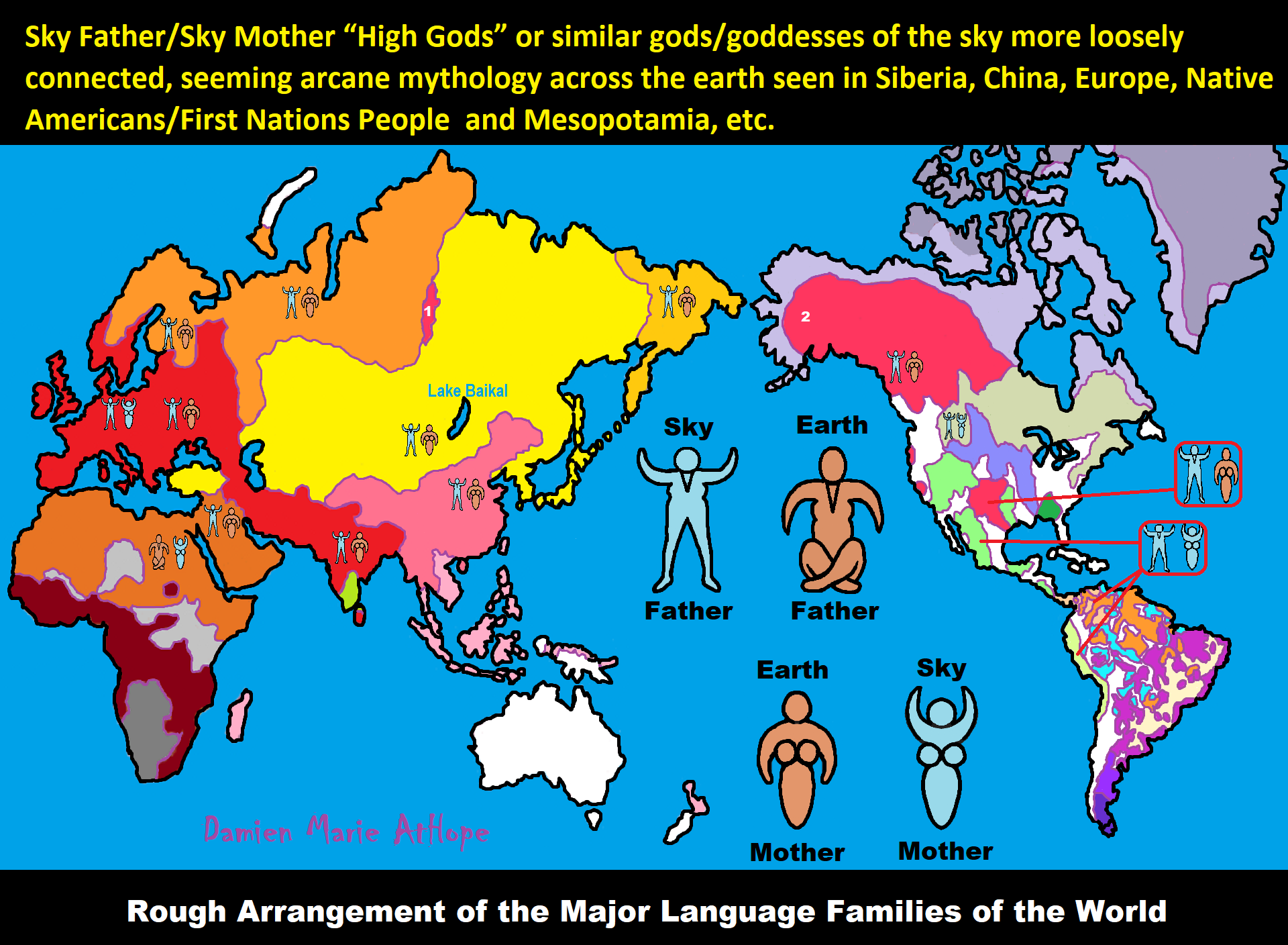
ref, ref, ref, ref, ref, ref, ref, ref, ref, ref, ref, ref, ref, ref, ref, ref, ref
“These ideas are my speculations from the evidence.”
I am still researching the “god‘s origins” all over the world. So you know, it is very complicated but I am smart and willing to look, DEEP, if necessary, which going very deep does seem to be needed here, when trying to actually understand the evolution of gods and goddesses. I am sure of a few things and less sure of others, but even in stuff I am not fully grasping I still am slowly figuring it out, to explain it to others. But as I research more I am understanding things a little better, though I am still working on understanding it all or something close and thus always figuring out more.
Sky Father/Sky God?
“Egyptian: (Nut) Sky Mother and (Geb) Earth Father” (Egypt is different but similar)
Turkic/Mongolic: (Tengri/Tenger Etseg) Sky Father and (Eje/Gazar Eej) Earth Mother *Transeurasian*
Hawaiian: (Wākea) Sky Father and (Papahānaumoku) Earth Mother *Austronesian*
New Zealand/ Māori: (Ranginui) Sky Father and (Papatūānuku) Earth Mother *Austronesian*
Proto-Indo-European: (Dyḗus/Dyḗus ph₂tḗr) Sky Father and (Dʰéǵʰōm/Pleth₂wih₁) Earth Mother
Indo-Aryan: (Dyaus Pita) Sky Father and (Prithvi Mata) Earth Mother *Indo-European*
Italic: (Jupiter) Sky Father and (Juno) Sky Mother *Indo-European*
Etruscan: (Tinia) Sky Father and (Uni) Sky Mother *Tyrsenian/Italy Pre–Indo-European*
Hellenic/Greek: (Zeus) Sky Father and (Hera) Sky Mother who started as an “Earth Goddess” *Indo-European*
Nordic: (Dagr) Sky Father and (Nótt) Sky Mother *Indo-European*
Slavic: (Perun) Sky Father and (Mokosh) Earth Mother *Indo-European*
Illyrian: (Deipaturos) Sky Father and (Messapic Damatura’s “earth-mother” maybe) Earth Mother *Indo-European*
Albanian: (Zojz) Sky Father and (?) *Indo-European*
Baltic: (Perkūnas) Sky Father and (Saulė) Sky Mother *Indo-European*
Germanic: (Týr) Sky Father and (?) *Indo-European*
Colombian-Muisca: (Bochica) Sky Father and (Huythaca) Sky Mother *Chibchan*
Aztec: (Quetzalcoatl) Sky Father and (Xochiquetzal) Sky Mother *Uto-Aztecan*
Incan: (Viracocha) Sky Father and (Mama Runtucaya) Sky Mother *Quechuan*
China: (Tian/Shangdi) Sky Father and (Dì) Earth Mother *Sino-Tibetan*
Sumerian, Assyrian and Babylonian: (An/Anu) Sky Father and (Ki) Earth Mother
Finnish: (Ukko) Sky Father and (Akka) Earth Mother *Finno-Ugric*
Sami: (Horagalles) Sky Father and (Ravdna) Earth Mother *Finno-Ugric*
Puebloan-Zuni: (Ápoyan Ta’chu) Sky Father and (Áwitelin Tsíta) Earth Mother
Puebloan-Hopi: (Tawa) Sky Father and (Kokyangwuti/Spider Woman/Grandmother) Earth Mother *Uto-Aztecan*
Puebloan-Navajo: (Tsohanoai) Sky Father and (Estsanatlehi) Earth Mother *Na-Dene*
ref, ref, ref, ref, ref, ref, ref, ref, ref, ref, ref, ref, ref, ref, ref, ref, ref, ref, ref, ref, ref, ref, ref, ref, ref, ref, ref
Hinduism around 3,700 to 3,500 years old. ref
Judaism around 3,450 or 3,250 years old. (The first writing in the bible was “Paleo-Hebrew” dated to around 3,000 years ago Khirbet Qeiyafa is the site of an ancient fortress city overlooking the Elah Valley. And many believe the religious Jewish texts were completed around 2,500) ref, ref
Judaism is around 3,450 or 3,250 years old. (“Paleo-Hebrew” 3,000 years ago and Torah 2,500 years ago)
“Judaism is an Abrahamic, its roots as an organized religion in the Middle East during the Bronze Age. Some scholars argue that modern Judaism evolved from Yahwism, the religion of ancient Israel and Judah, by the late 6th century BCE, and is thus considered to be one of the oldest monotheistic religions.” ref
“Yahwism is the name given by modern scholars to the religion of ancient Israel, essentially polytheistic, with a plethora of gods and goddesses. Heading the pantheon was Yahweh, the national god of the Israelite kingdoms of Israel and Judah, with his consort, the goddess Asherah; below them were second-tier gods and goddesses such as Baal, Shamash, Yarikh, Mot, and Astarte, all of whom had their own priests and prophets and numbered royalty among their devotees, and a third and fourth tier of minor divine beings, including the mal’ak, the messengers of the higher gods, who in later times became the angels of Judaism, Christianity and Islam. Yahweh, however, was not the ‘original’ god of Israel “Isra-El”; it is El, the head of the Canaanite pantheon, whose name forms the basis of the name “Israel”, and none of the Old Testament patriarchs, the tribes of Israel, the Judges, or the earliest monarchs, have a Yahwistic theophoric name (i.e., one incorporating the name of Yahweh).” ref
“El is a Northwest Semitic word meaning “god” or “deity“, or referring (as a proper name) to any one of multiple major ancient Near Eastern deities. A rarer form, ‘ila, represents the predicate form in Old Akkadian and in Amorite. The word is derived from the Proto-Semitic *ʔil-, meaning “god”. Specific deities known as ‘El or ‘Il include the supreme god of the ancient Canaanite religion and the supreme god of East Semitic speakers in Mesopotamia’s Early Dynastic Period. ʼĒl is listed at the head of many pantheons. In some Canaanite and Ugaritic sources, ʼĒl played a role as father of the gods, of creation, or both. For example, in the Ugaritic texts, ʾil mlk is understood to mean “ʼĒl the King” but ʾil hd as “the god Hadad“. The Semitic root ʾlh (Arabic ʾilāh, Aramaic ʾAlāh, ʾElāh, Hebrew ʾelōah) may be ʾl with a parasitic h, and ʾl may be an abbreviated form of ʾlh. In Ugaritic the plural form meaning “gods” is ʾilhm, equivalent to Hebrew ʾelōhîm “powers”. In the Hebrew texts this word is interpreted as being semantically singular for “god” by biblical commentators. However the documentary hypothesis for the Old Testament (corresponds to the Jewish Torah) developed originally in the 1870s, identifies these that different authors – the Jahwist, Elohist, Deuteronomist, and the Priestly source – were responsible for editing stories from a polytheistic religion into those of a monotheistic religion. Inconsistencies that arise between monotheism and polytheism in the texts are reflective of this hypothesis.” ref
Jainism around 2,599 – 2,527 years old. ref
Confucianism around 2,600 – 2,551 years old. ref
Buddhism around 2,563/2,480 – 2,483/2,400 years old. ref
Christianity around 2,o00 years old. ref
Shinto around 1,305 years old. ref
Islam around 1407–1385 years old. ref

Knowledge to Ponder:
Stars/Astrology:
- Possibly, around 30,000 years ago (in simpler form) to 6,000 years ago, Stars/Astrology are connected to Ancestors, Spirit Animals, and Deities.
- The star also seems to be a possible proto-star for Star of Ishtar, Star of Inanna, or Star of Venus.
- Around 7,000 to 6,000 years ago, Star Constellations/Astrology have connections to the “Kurgan phenomenon” of below-ground “mound” stone/wood burial structures and “Dolmen phenomenon” of above-ground stone burial structures.
- Around 6,500–5,800 years ago, The Northern Levant migrations into Jordon and Israel in the Southern Levant brought new cultural and religious transfer from Turkey and Iran.
- “The Ghassulian Star,” a mysterious 6,000-year-old mural from Jordan may have connections to the European paganstic kurgan/dolmens phenomenon.
“Astrology is a range of divinatory practices, recognized as pseudoscientific since the 18th century, that claim to discern information about human affairs and terrestrial events by studying the apparent positions of celestial objects. Different cultures have employed forms of astrology since at least the 2nd millennium BCE, these practices having originated in calendrical systems used to predict seasonal shifts and to interpret celestial cycles as signs of divine communications. Most, if not all, cultures have attached importance to what they observed in the sky, and some—such as the Hindus, Chinese, and the Maya—developed elaborate systems for predicting terrestrial events from celestial observations. Western astrology, one of the oldest astrological systems still in use, can trace its roots to 19th–17th century BCE Mesopotamia, from where it spread to Ancient Greece, Rome, the Islamicate world and eventually Central and Western Europe. Contemporary Western astrology is often associated with systems of horoscopes that purport to explain aspects of a person’s personality and predict significant events in their lives based on the positions of celestial objects; the majority of professional astrologers rely on such systems.” ref
Around 5,500 years ago, Science evolves, The first evidence of science was 5,500 years ago and was demonstrated by a body of empirical, theoretical, and practical knowledge about the natural world. ref
Around 5,000 years ago, Origin of Logics is a Naturalistic Observation (principles of valid reasoning, inference, & demonstration) ref
Around 4,150 to 4,000 years ago: The earliest surviving versions of the Sumerian Epic of Gilgamesh, which was originally titled “He who Saw the Deep” (Sha naqba īmuru) or “Surpassing All Other Kings” (Shūtur eli sharrī) were written. ref
Hinduism:
- 3,700 years ago or so, the oldest of the Hindu Vedas (scriptures), the Rig Veda was composed.
- 3,500 years ago or so, the Vedic Age began in India after the collapse of the Indus Valley Civilization.
Judaism:
- around 3,000 years ago, the first writing in the bible was “Paleo-Hebrew”
- around 2,500 years ago, many believe the religious Jewish texts were completed
Myths: The bible inspired religion is not just one religion or one myth but a grouping of several religions and myths
- Around 3,450 or 3,250 years ago, according to legend, is the traditionally accepted period in which the Israelite lawgiver, Moses, provided the Ten Commandments.
- Around 2,500 to 2,400 years ago, a collection of ancient religious writings by the Israelites based primarily upon the Hebrew Bible, Tanakh, or Old Testament is the first part of Christianity’s bible.
- Around 2,400 years ago, the most accepted hypothesis is that the canon was formed in stages, first the Pentateuch (Torah).
- Around 2,140 to 2,116 years ago, the Prophets was written during the Hasmonean dynasty, and finally the remaining books.
- Christians traditionally divide the Old Testament into four sections:
- The first five books or Pentateuch (Torah).
- The proposed history books telling the history of the Israelites from their conquest of Canaan to their defeat and exile in Babylon.
- The poetic and proposed “Wisdom books” dealing, in various forms, with questions of good and evil in the world.
- The books of the biblical prophets, warning of the consequences of turning away from God:
- Henotheism:
- Exodus 20:23 “You shall not make other gods besides Me (not saying there are no other gods just not to worship them); gods of silver or gods of gold, you shall not make for yourselves.”
- Polytheism:
- Judges 10:6 “Then the sons of Israel again did evil in the sight of the LORD, served the Baals and the Ashtaroth, the gods of Aram, the gods of Sidon, the gods of Moab, the gods of the sons of Ammon, and the gods of the Philistines; thus they forsook the LORD and did not serve Him.”
- 1 Corinthians 8:5 “For even if there are so-called gods whether in heaven or on earth, as indeed there are many gods and many lords.”
- Monotheism:
- Isaiah 43:10 “You are my witnesses,” declares the LORD, “and my servant whom I have chosen, so that you may know and believe me and understand that I am he. Before me no god was formed, nor will there be one after me.
Around 2,570 to 2,270 Years Ago, there is a confirmation of atheistic doubting as well as atheistic thinking, mainly by Greek philosophers. However, doubting gods is likely as old as the invention of gods and should destroy the thinking that belief in god(s) is the “default belief”. The Greek word is apistos (a “not” and pistos “faithful,”), thus not faithful or faithless because one is unpersuaded and unconvinced by a god(s) claim. Short Definition: unbelieving, unbeliever, or unbelief.

Expressions of Atheistic Thinking:
- Around 2,600 years ago, Ajita Kesakambali, ancient Indian philosopher, who is the first known proponent of Indian materialism. ref
- Around 2,535 to 2,475 years ago, Heraclitus, Greek pre-Socratic philosopher, a native of the Greek city Ephesus, Ionia, on the coast of Anatolia, also known as Asia Minor or modern Turkey. ref
- Around 2,500 to 2,400 years ago, according to The Story of Civilization book series certain African pygmy tribes have no identifiable gods, spirits, or religious beliefs or rituals, and even what burials accrue are without ceremony. ref
- Around 2,490 to 2,430 years ago, Empedocles, Greek pre-Socratic philosopher and a citizen of Agrigentum, a Greek city in Sicily. ref
- Around 2,460 to 2,370 years ago, Democritus, Greek pre-Socratic philosopher considered to be the “father of modern science” possibly had some disbelief amounting to atheism. ref
- Around 2,399 years ago or so, Socrates, a famous Greek philosopher was tried for sinfulness by teaching doubt of state gods. ref
- Around 2,341 to 2,270 years ago, Epicurus, a Greek philosopher known for composing atheistic critics and famously stated, “Is God willing to prevent evil, but not able? Then he is not omnipotent. Is he able, but not willing? Then he is malevolent. Is he both able and willing? Then whence cometh evil? Is he neither able nor willing? Then why call him god?” ref
This last expression by Epicurus, seems to be an expression of Axiological Atheism. To understand and utilize value or actually possess “Value Conscious/Consciousness” to both give a strong moral “axiological” argument (the problem of evil) as well as use it to fortify humanism and positive ethical persuasion of human helping and care responsibilities. Because value-blindness gives rise to sociopathic/psychopathic evil.
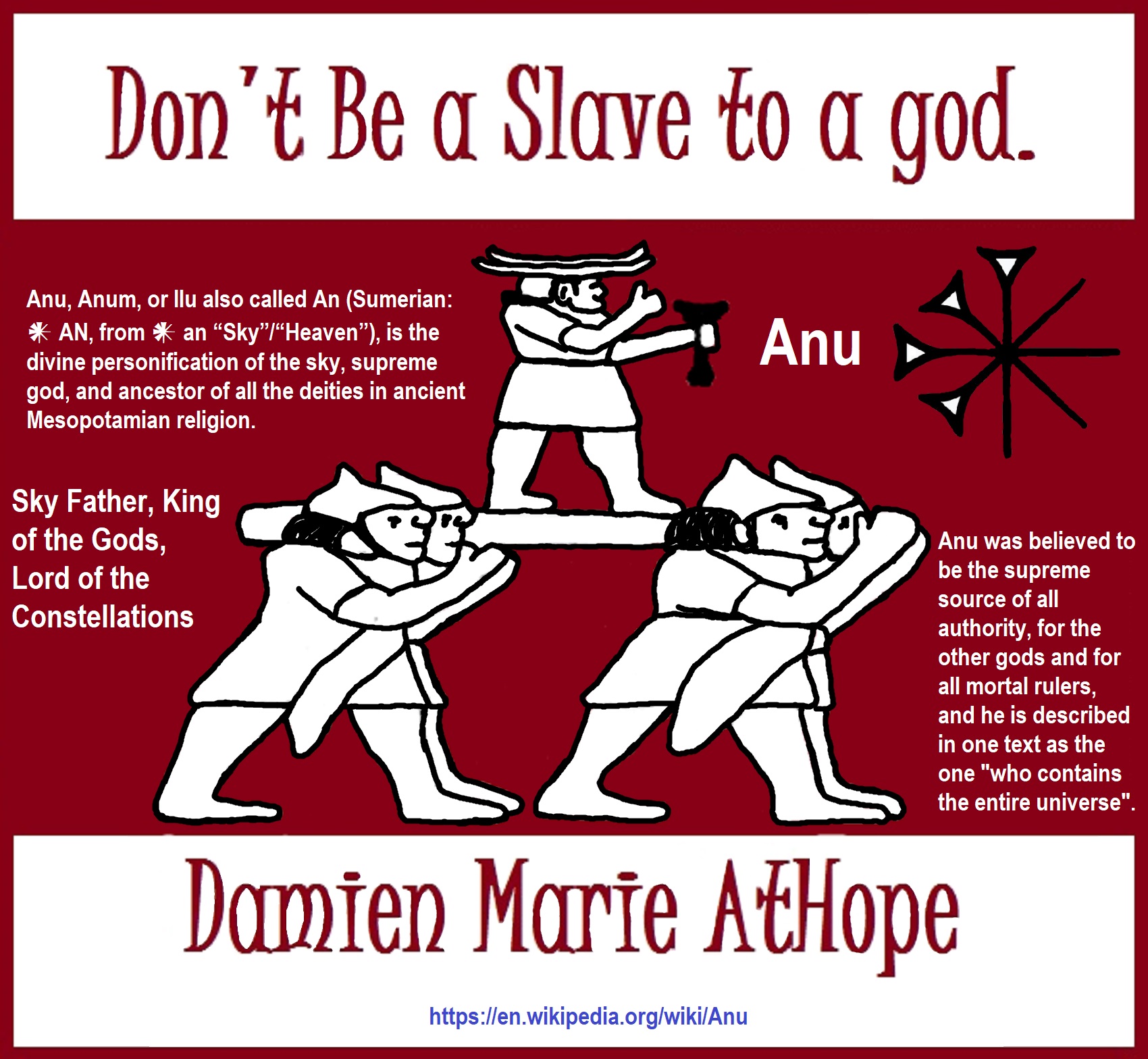
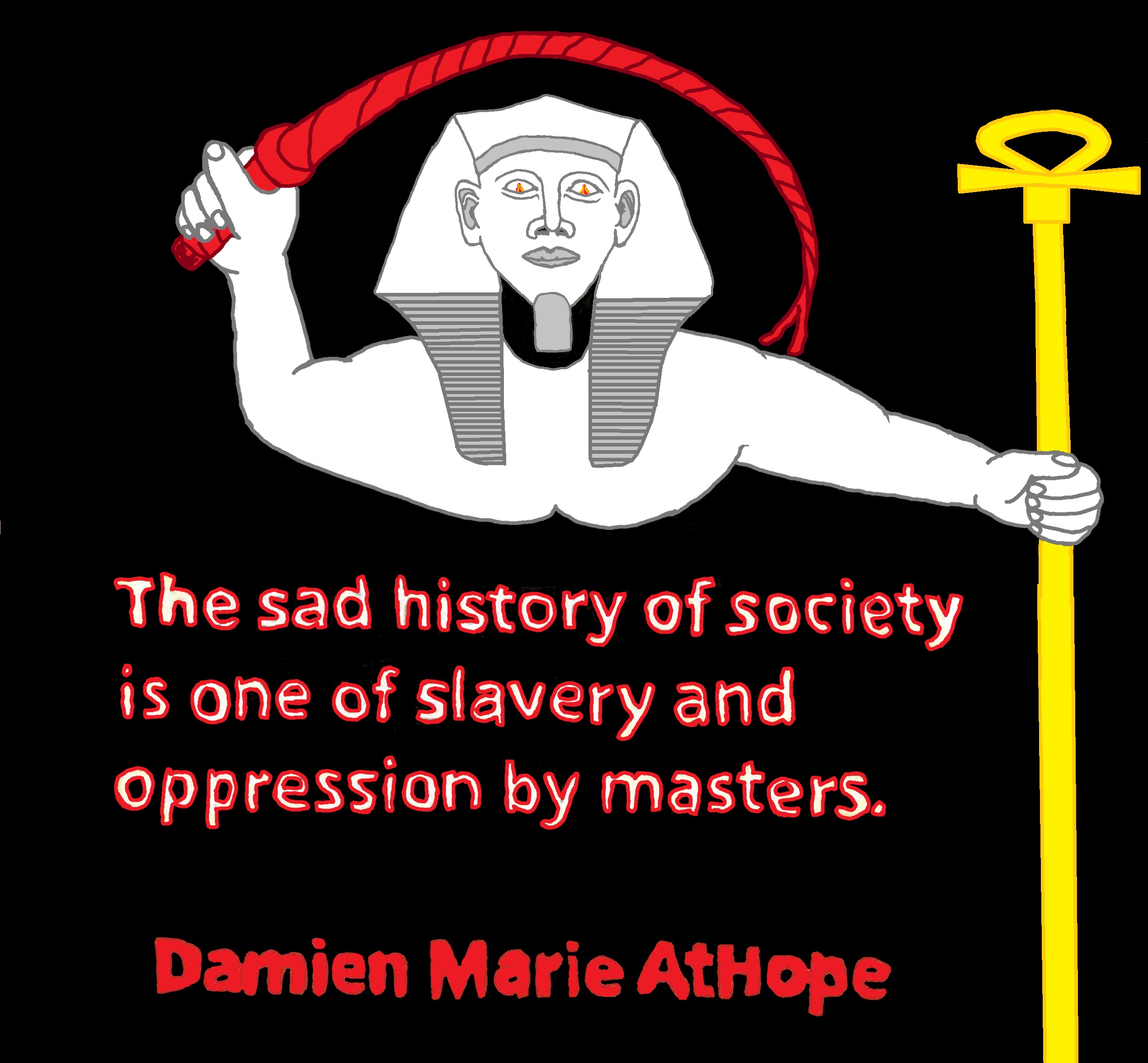
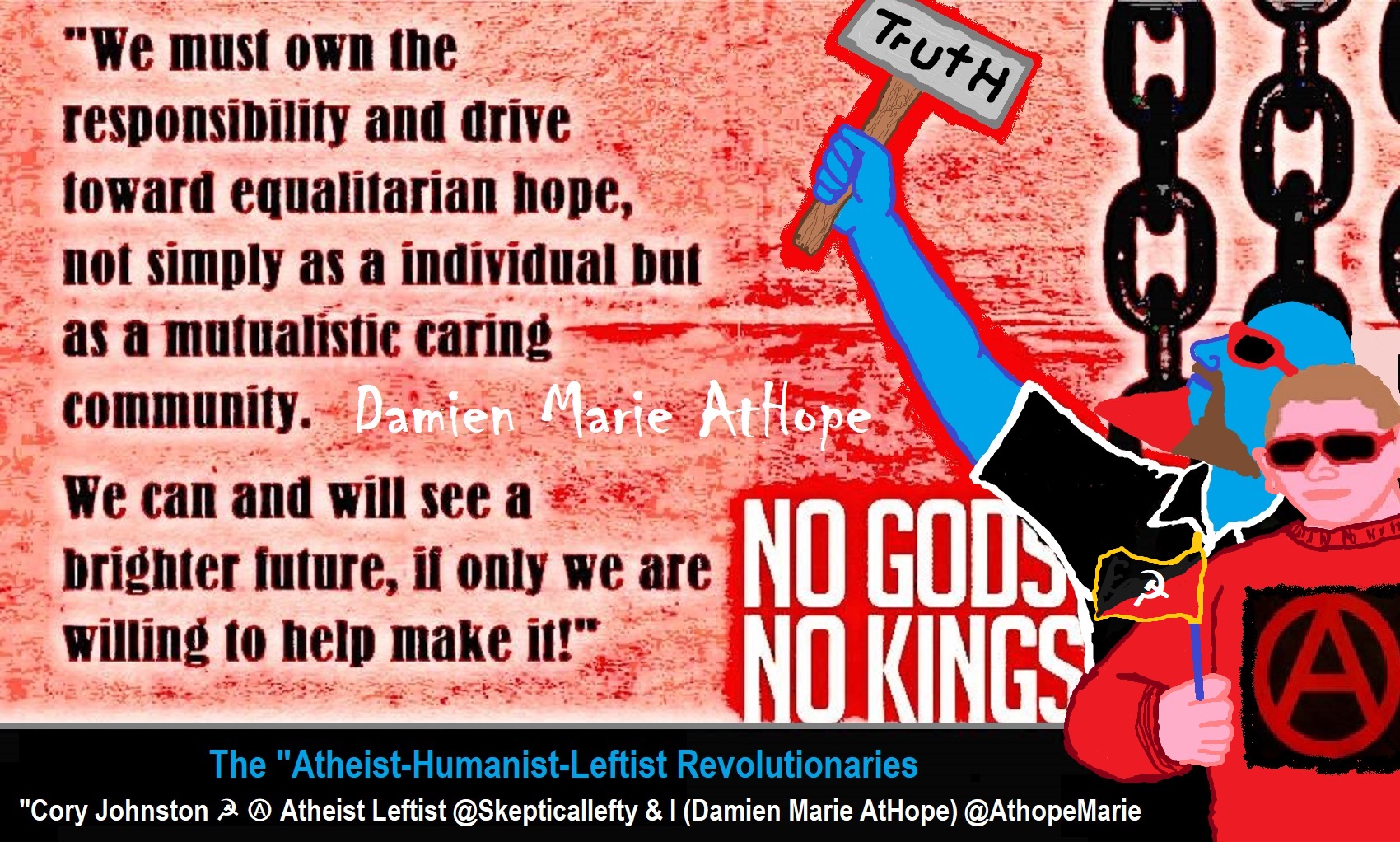
While hallucinogens are associated with shamanism, it is alcohol that is associated with paganism.
The Atheist-Humanist-Leftist Revolutionaries Shows in the prehistory series:
Show two: Pre-animism 300,000 years old and animism 100,000 years old: related to “Anarchism and Socialism”
Show tree: Totemism 50,000 years old: related to “Anarchism and Socialism”
Show four: Shamanism 30,000 years old: related to “Anarchism and Socialism”
Show five: Paganism 12,000 years old: related to “Anarchism and Socialism”
Show six: Emergence of hierarchy, sexism, slavery, and the new male god dominance: Paganism 7,000-5,000 years old: related to “Anarchism and Socialism” (Capitalism) (World War 0) Elite and their slaves!
Prehistory: related to “Anarchism and Socialism” the division of labor, power, rights, and recourses: VIDEO
Pre-animism 300,000 years old and animism 100,000 years old: related to “Anarchism and Socialism”: VIDEO
Totemism 50,000 years old: related to “Anarchism and Socialism”: VIDEO
Shamanism 30,000 years old: related to “Anarchism and Socialism”: VIDEO
Paganism 12,000 years old: related to “Anarchism and Socialism” (Pre-Capitalism): VIDEO
Paganism 7,000-5,000 years old: related to “Anarchism and Socialism” (Capitalism) (World War 0) Elite and their slaves: VIEDO
Paganism 5,000 years old: progressed organized religion and the state: related to “Anarchism and Socialism” (Kings and the Rise of the State): VIEDO
Paganism 4,000 years old: related to “Anarchism and Socialism” (First Moralistic gods, then the Origin time of Monotheism): VIEDO
I do not hate simply because I challenge and expose myths or lies any more than others being thought of as loving simply because of the protection and hiding from challenge their favored myths or lies.
The truth is best championed in the sunlight of challenge.
An archaeologist once said to me “Damien religion and culture are very different”
My response, So are you saying that was always that way, such as would you say Native Americans’ cultures are separate from their religions? And do you think it always was the way you believe?
I had said that religion was a cultural product. That is still how I see it and there are other archaeologists that think close to me as well. Gods too are the myths of cultures that did not understand science or the world around them, seeing magic/supernatural everywhere.
I personally think there is a goddess and not enough evidence to support a male god at Çatalhöyük but if there was both a male and female god and goddess then I know the kind of gods they were like Proto-Indo-European mythology.
This series idea was addressed in, Anarchist Teaching as Free Public Education or Free Education in the Public: VIDEO
Our 12 video series: Organized Oppression: Mesopotamian State Force and the Politics of power (9,000-4,000 years ago), is adapted from: The Complete and Concise History of the Sumerians and Early Bronze Age Mesopotamia (7000-2000 BC): https://www.youtube.com/watch?v=szFjxmY7jQA by “History with Cy“
Show #1: Mesopotamian State Force and the Politics of Power (Samarra, Halaf, Ubaid)
Show #2: Mesopotamian State Force and the Politics of Power
Show #3: Mesopotamian State Force and the Politics of Power (Uruk and the First Cities)
Show #4: Mesopotamian State Force and the Politics of Power (First Kings)
Show #5: Mesopotamian State Force and the Politics of Power (Early Dynastic Period)
Show #6: Mesopotamian State Force and the Politics of Power
Show #7: Mesopotamian State Force and the Politics of Power (Sargon and Akkadian Rule)
Show #9: Mesopotamian State Force and the Politics of Power (Gudea of Lagash and Utu-hegal)
Show #12: Mesopotamian State Force and the Politics of Power (Aftermath and Legacy of Sumer)
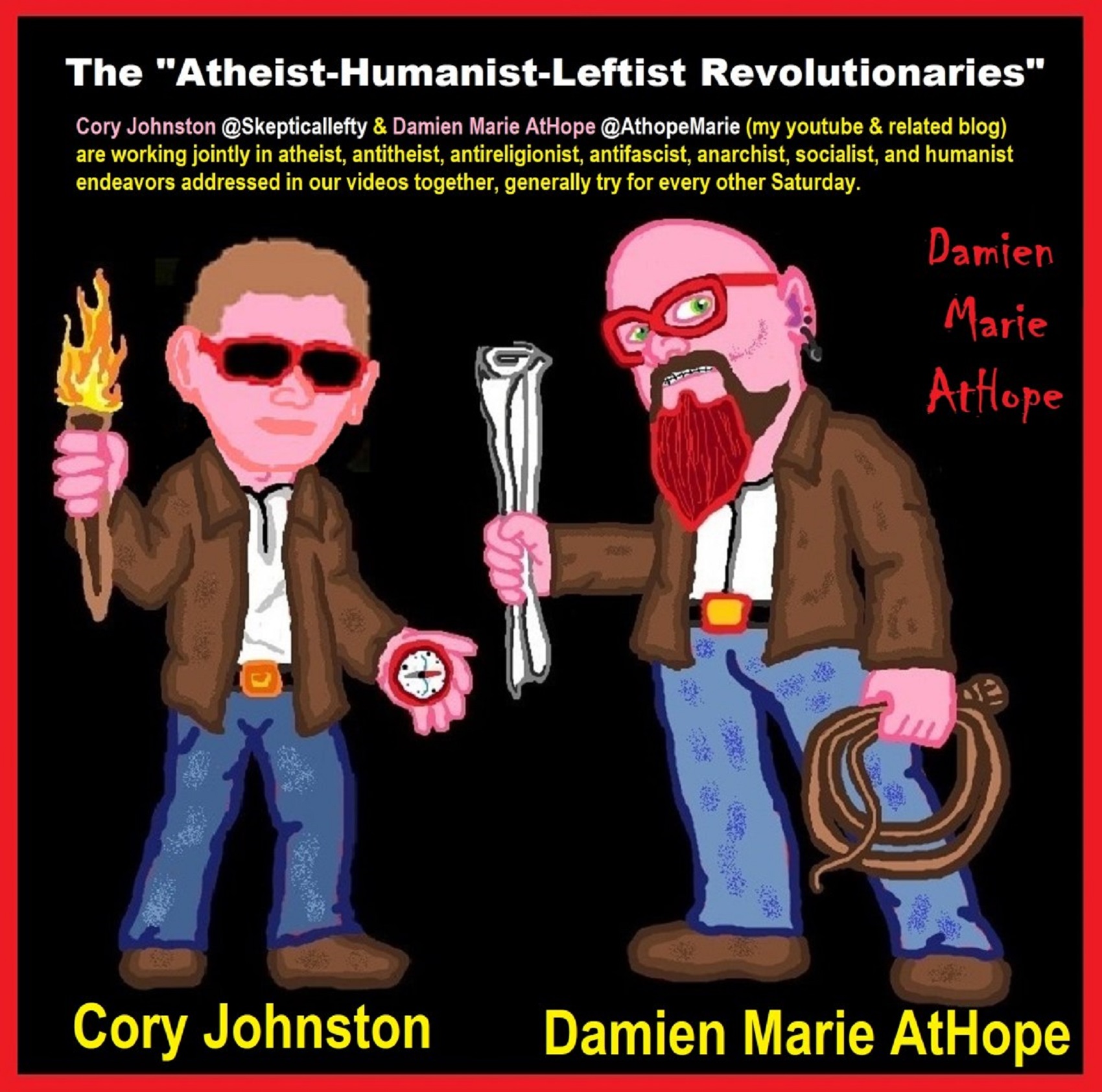
The “Atheist-Humanist-Leftist Revolutionaries”
Cory Johnston ☭ Ⓐ Atheist Leftist @Skepticallefty & I (Damien Marie AtHope) @AthopeMarie (my YouTube & related blog) are working jointly in atheist, antitheist, antireligionist, antifascist, anarchist, socialist, and humanist endeavors in our videos together, generally, every other Saturday.
Why Does Power Bring Responsibility?
Think, how often is it the powerless that start wars, oppress others, or commit genocide? So, I guess the question is to us all, to ask, how can power not carry responsibility in a humanity concept? I know I see the deep ethical responsibility that if there is power their must be a humanistic responsibility of ethical and empathic stewardship of that power. Will I be brave enough to be kind? Will I possess enough courage to be compassionate? Will my valor reach its height of empathy? I as everyone, earns our justified respect by our actions, that are good, ethical, just, protecting, and kind. Do I have enough self-respect to put my love for humanity’s flushing, over being brought down by some of its bad actors? May we all be the ones doing good actions in the world, to help human flourishing.
I create the world I want to live in, striving for flourishing. Which is not a place but a positive potential involvement and promotion; a life of humanist goal precision. To master oneself, also means mastering positive prosocial behaviors needed for human flourishing. I may have lost a god myth as an atheist, but I am happy to tell you, my friend, it is exactly because of that, leaving the mental terrorizer, god belief, that I truly regained my connected ethical as well as kind humanity.
Cory and I will talk about prehistory and theism, addressing the relevance to atheism, anarchism, and socialism.
At the same time as the rise of the male god, 7,000 years ago, there was also the very time there was the rise of violence, war, and clans to kingdoms, then empires, then states. It is all connected back to 7,000 years ago, and it moved across the world.
Cory Johnston: https://damienmarieathope.com/2021/04/cory-johnston-mind-of-a-skeptical-leftist/?v=32aec8db952d
The Mind of a Skeptical Leftist (YouTube)
Cory Johnston: Mind of a Skeptical Leftist @Skepticallefty
The Mind of a Skeptical Leftist By Cory Johnston: “Promoting critical thinking, social justice, and left-wing politics by covering current events and talking to a variety of people. Cory Johnston has been thoughtfully talking to people and attempting to promote critical thinking, social justice, and left-wing politics.” http://anchor.fm/skepticalleft
Cory needs our support. We rise by helping each other.
Cory Johnston ☭ Ⓐ @Skepticallefty Evidence-based atheist leftist (he/him) Producer, host, and co-host of 4 podcasts @skeptarchy @skpoliticspod and @AthopeMarie
Damien Marie AtHope (“At Hope”) Axiological Atheist, Anti-theist, Anti-religionist, Secular Humanist. Rationalist, Writer, Artist, Poet, Philosopher, Advocate, Activist, Psychology, and Armchair Archaeology/Anthropology/Historian.
Damien is interested in: Freedom, Liberty, Justice, Equality, Ethics, Humanism, Science, Atheism, Antiteism, Antireligionism, Ignosticism, Left-Libertarianism, Anarchism, Socialism, Mutualism, Axiology, Metaphysics, LGBTQI, Philosophy, Advocacy, Activism, Mental Health, Psychology, Archaeology, Social Work, Sexual Rights, Marriage Rights, Woman’s Rights, Gender Rights, Child Rights, Secular Rights, Race Equality, Ageism/Disability Equality, Etc. And a far-leftist, “Anarcho-Humanist.”
I am not a good fit in the atheist movement that is mostly pro-capitalist, I am anti-capitalist. Mostly pro-skeptic, I am a rationalist not valuing skepticism. Mostly pro-agnostic, I am anti-agnostic. Mostly limited to anti-Abrahamic religions, I am an anti-religionist.
To me, the “male god” seems to have either emerged or become prominent around 7,000 years ago, whereas the now favored monotheism “male god” is more like 4,000 years ago or so. To me, the “female goddess” seems to have either emerged or become prominent around 11,000-10,000 years ago or so, losing the majority of its once prominence around 2,000 years ago due largely to the now favored monotheism “male god” that grow in prominence after 4,000 years ago or so.
My Thought on the Evolution of Gods?
Animal protector deities from old totems/spirit animal beliefs come first to me, 13,000/12,000 years ago, then women as deities 11,000/10,000 years ago, then male gods around 7,000/8,000 years ago. Moralistic gods around 5,000/4,000 years ago, and monotheistic gods around 4,000/3,000 years ago.
To me, animal gods were likely first related to totemism animals around 13,000 to 12,000 years ago or older. Female as goddesses was next to me, 11,000 to 10,000 years ago or so with the emergence of agriculture. Then male gods come about 8,000 to 7,000 years ago with clan wars. Many monotheism-themed religions started in henotheism, emerging out of polytheism/paganism.

Damien Marie AtHope (Said as “At” “Hope”)/(Autodidact Polymath but not good at math):
Axiological Atheist, Anti-theist, Anti-religionist, Secular Humanist, Rationalist, Writer, Artist, Jeweler, Poet, “autodidact” Philosopher, schooled in Psychology, and “autodidact” Armchair Archaeology/Anthropology/Pre-Historian (Knowledgeable in the range of: 1 million to 5,000/4,000 years ago). I am an anarchist socialist politically. Reasons for or Types of Atheism
My Website, My Blog, & Short-writing or Quotes, My YouTube, Twitter: @AthopeMarie, and My Email: damien.marie.athope@gmail.com

